By Faris Glubb/Faris (*, reading his biography is a must)
CONTENTS
[Where possible, we have included our commentary in italic between brackets to add more context, relevent data, and few corrections to this great book which was one of the first to be published about this taboo subject. PR Editor]
Introduction
Despite the appearance of large numbers of books on Nazi Germany's barbaric treatment of European Jews, there is widespread public ignorance on one important aspect of this question: the relationship between the Zionist movement and Nazi Germany. The information on this subject is available, but has not yet been gathered together in a single comprehensive study. This study is intended. at least partially, to remedy this deficiency. Owing to the delicate nature of this subject, and the Zionist tendency to brand any non-Zionist or anti-Zionist viewpoint as "anti-Semitic", all the material on Zionist-Nazi relations in this study is taken from exclusively Jewish sources. The writers quoted cover a wide spectrum Of views, from extreme Zionist to anti-Zionist, with various shades in between. The reader will thus be able to form an accurate and objective opinion on the basis of evidence presented by leading Jewish historians.
I. The Early Zionist Attitude to Anti-Semitism
The central tenets of Zionism are that the Jews constitute a "nation" separate from all other nations, and that they must be "ingathered" from the various parts of the world to Palestine, to form their own nation-state there. The European phenomenon known as "anti-Semitism" maintains that the Jews are an unassimilable, alien element in European society, which should be removed from Europe.
The founder of the political Zionist movement, Theodor Herzl, was aware of the philosophical common ground between Zionism and anti-Semitism when he wrote: "The governments of all countries scourged by anti-Semitism will be keenly interested in assisting us to obtain the sovereignty we want."(1) I Herzl "frequently asserted, in all innocence, that anti-Semites would be the Jews' best friends and anti-Semitic governments their best allies. But this faith in anti-Semites expressed very eloquently and even touchingly how close his own state of mind was to that of his hostile environment and how intimately he did belong to the 'alien' world... "Anti-Semitism was an overwhelming force and the Jews would have either to make use of it or be swallowed up by it. In his own words, anti-Semitism was the propelling force' responsible for all Jewish suffering since the destruction of the Temple and it would continue to make the Jews suffer until they learned how to use it for their own advantage. In expert hands this 'propelling force' would prove the most salutory factor in Jewish life; it would be used in the same way that boiling water is used to produce steam power.' (2)
Herzl was a man who practised what he preached. The methods he used in his diplomatic efforts to further the Zionist cause accorded with the principles he proclaimed. This is strongly illustrated by the approaches he made to Czarist Russia, which at the beginning of this century was the power that applied the most fanatical and cruel anti-Jewish policies of massacre, expulsion and discrimination. Although Herzl never achieved his dream of an audience with the Czar, he did hold talks with the Czarist Interior Minister Wenzel von Plehve, who was responsible for implementing anti-Jewish measures and organised massacres like the Kishinev pogrom, in which 45 Jews were killed. Plehve "was brutal enough to admit that he had no objections to getting rid of as many Jews as possible; in fact, he would become a 'sympathetic' supporter Of Zionism. Herzl then proposed that Plehve should write him a letter that he would present before the Zionist Congress, to the effect that the Zionist movement could count on the Russian Government's 'moral and material assistance'. Plehve's letter became Herzl's most treasured asset. He carried it around everywhere; he showed it to the Pope.
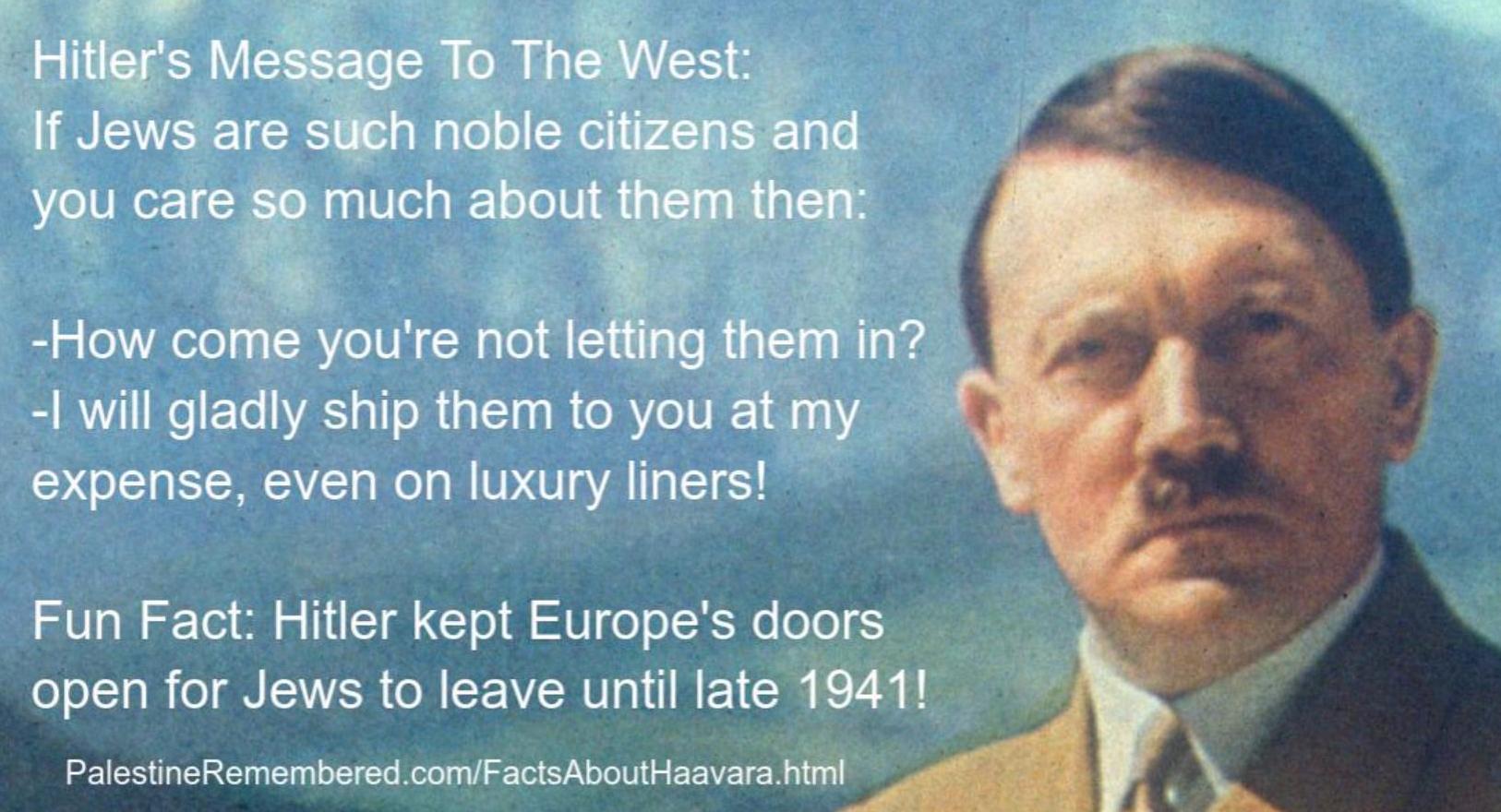 Hitler's Message To The West: If Jews are such noble citizens and you care about them, how come you're not letting them in?
Hitler's Message To The West: If Jews are such noble citizens and you care about them, how come you're not letting them in?
The most important foundations laid by Herzl for Zionism's future successes were anti-Semitic circles in Britain. A substantial number of Russian Jewish refugees from Czarist pogroms chose Britain rather than Palestine as their refuge, thus disappointing Zionist hopes. But the Zionists found that a number of extreme right-wing politicians in Britain were only too willing to stir up a vicious campaign aimed at denying these unfortunate refugees the right of asylum.
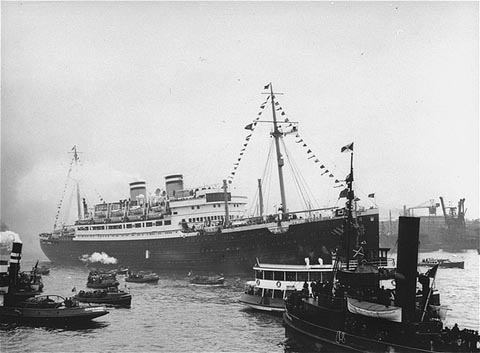 In May 1939, MS St. Louis in Havana was refused to unload its Jewish passengers in Cuba & US, and it was forced to go back to Antwerp. Jewish Agency refused to give any of its passengers' immigration visas to Palestine. Over 250 of the passengers perished during the Holocaust
In May 1939, MS St. Louis in Havana was refused to unload its Jewish passengers in Cuba & US, and it was forced to go back to Antwerp. Jewish Agency refused to give any of its passengers' immigration visas to Palestine. Over 250 of the passengers perished during the HolocaustHerzl gave these right-wingers his blessing and encouragement. In his evidence to the Royal Commission on Alien Immigration, which investigated the question in 1902 and 1903, Herzl called for the stream of migration to be diverted away from Britain. He thus agreed with the racist Arnold White, one of the leading theorists of the campaign to ban Jews from Britain. (5)
Another leader of this campaign with whom Herzl made friendly contact was Colonial Secretary Joseph Chamberlain. In a speech in Limehouse, London, in December 1904, Chamberlain attacked the policy of allowing Jewish immigration to Britain, at the same time endorsing the Zionist idea of a Jewish state and warmly praising Herzl. (6)
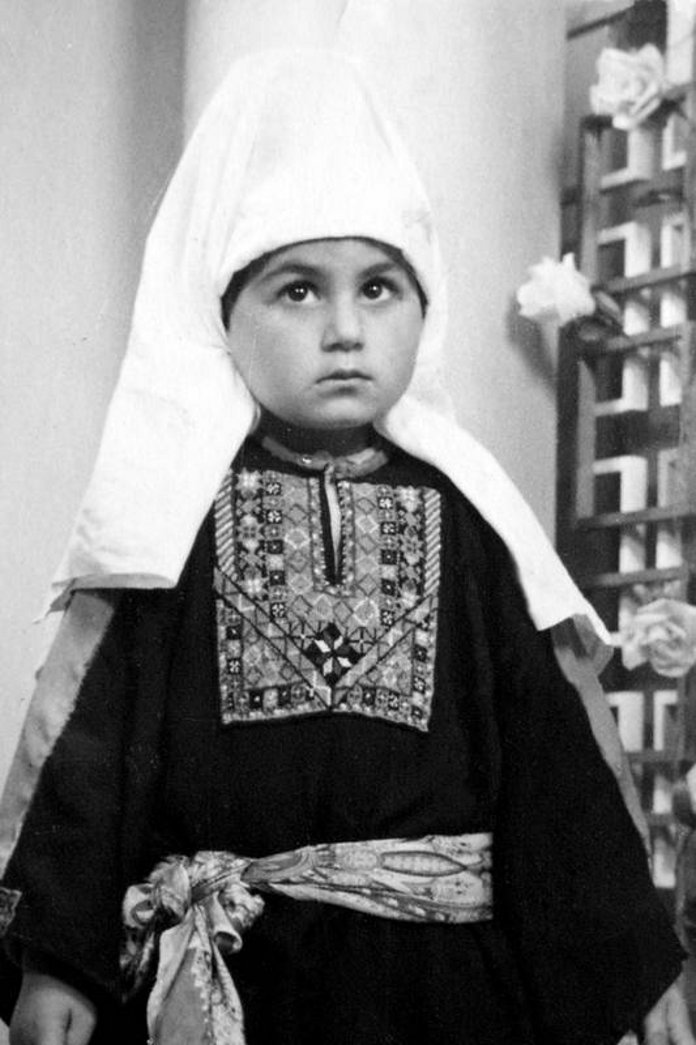 Pre-Nakba picture of a Palestinian Christian girl from Bethlehem who "doesn't exist"; Zionists say!
Pre-Nakba picture of a Palestinian Christian girl from Bethlehem who "doesn't exist"; Zionists say!The most important British anti-Semite of that age, in terms of his eventual services to Zionism, was the fanatical Jew-baiter Lord Arthur Balfour. In a parliamentary debate on the immigration issue, Balfour made a speech in which he put forward a case for anti-Semitism that is all too familiar. He declared: "It would not be to the advantage of the civilisation of the country that there should be an immense body of persons who, by their own action, remained a people apart, and not merely held a religion differing from the vast majority of their fellow-country-men, but only intermarried among themselves." (7)
Herzl was able to declare with satisfaction that "anti-Semitism has grown and continues to grow, and so do l." (8) But the fruits of his diplomacy did not ripen during his lifetime: A decade after his death, the First World War was to prove a turning-point in the fortunes of Zionism, as the Western allies planned the division of the Ottoman Empire, which was fighting on the side of Germany. Palestine was then under Ottoman control.
The Zionists followed a policy of betting on both sides in the first two years of the war. The headquarters of the World Zionist Organisation was then still in Berlin, and its leaders there pursued efforts to form an alliance with Germany. At the same time Chaim Weizmann, then President of the British Zionist Federation, made parallel efforts for an alliance with Britain. Weizmann conducted an astute and energetic campaign, concentrating on canvassing the support of reactionary politicians like Balfour, Lord Robert Cecil and the Prime Minister Lloyd George. Apart from the argument that Zionism was a convenient way of ridding Europe of its Jews, Weizmann also used the imperialist argument that "a Jewish Palestine would be a safeguard to England, in particular in respect to the Suez Canal." (9)
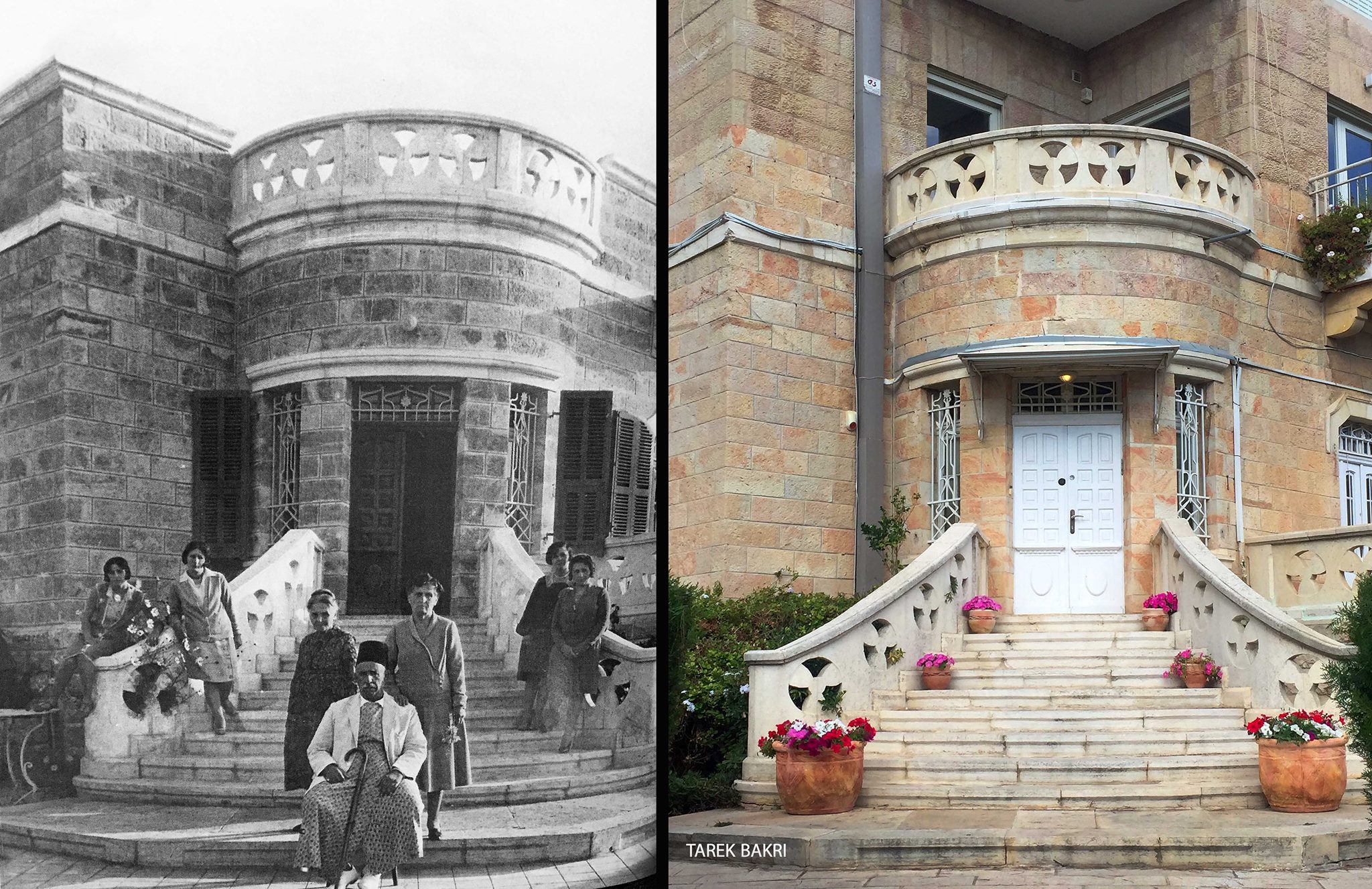 Shukri al-Jamal's Palace in the Talibiya neighborhood in Jerusalem two days after its completion and just before Zionist Jews looted it from him and his family
Shukri al-Jamal's Palace in the Talibiya neighborhood in Jerusalem two days after its completion and just before Zionist Jews looted it from him and his familyThe Balfour Declaration of 2nd November 1917 was the outcome Of these diplomatic efforts. This first charter for a Zionist "national home" was thus motivated by a combination of imperial ambitions and anti-Semitic prejudices on the part of the right-wing politicians who issued it. It is interesting that the strongest opposition to it within the British Government came from its only Jewish member, Sir Edwin Montagu, who clearly recognised the anti-Semitic motivations behind the policy of Balfour and Lloyd George. Montagu wrote: "I assert that there is not a Jewish nation... When the Jews are told that Palestine is their national home, every country will immediately desire to get rid of its Jewish citizens, and you will find a population in Palestine driving out its present inhabitants, taking all the best in the country."(10)
Montagu's predictions were all too accurate. The years following the Balfour Declaration witnessed the rise of virulent anti-Semitism in Europe, culminating in Hitler's holocaust. This in turn was followed by the dispossession of the Palestinian people. As will become apparent, the two events were closely interrelated.
II. The Common Ground between Zionism and Nazism
Hitler's advent to power in Germany on 30 January 1933 meant that anti-Semitism became the German Government's official policy. This event was accompanied by an intensification of the Jew-baiting policies character- iStic of Nazism.
"In January 1933, the Nazi leaders, long considered by thinking persons as a band of ignorant and perverted demagogues, suddenly became the respectable heads of a great government. However, only their status had altered; their character and methods remained unchanged, and the Jews of Germany had to suffer the consequences of the demagogic campaign of hatred which had long been waged against them.(11)
Armed with the full apparatus of government, the Nazis were able to launch an effective reign of terror: A Jewish witness described it thus:
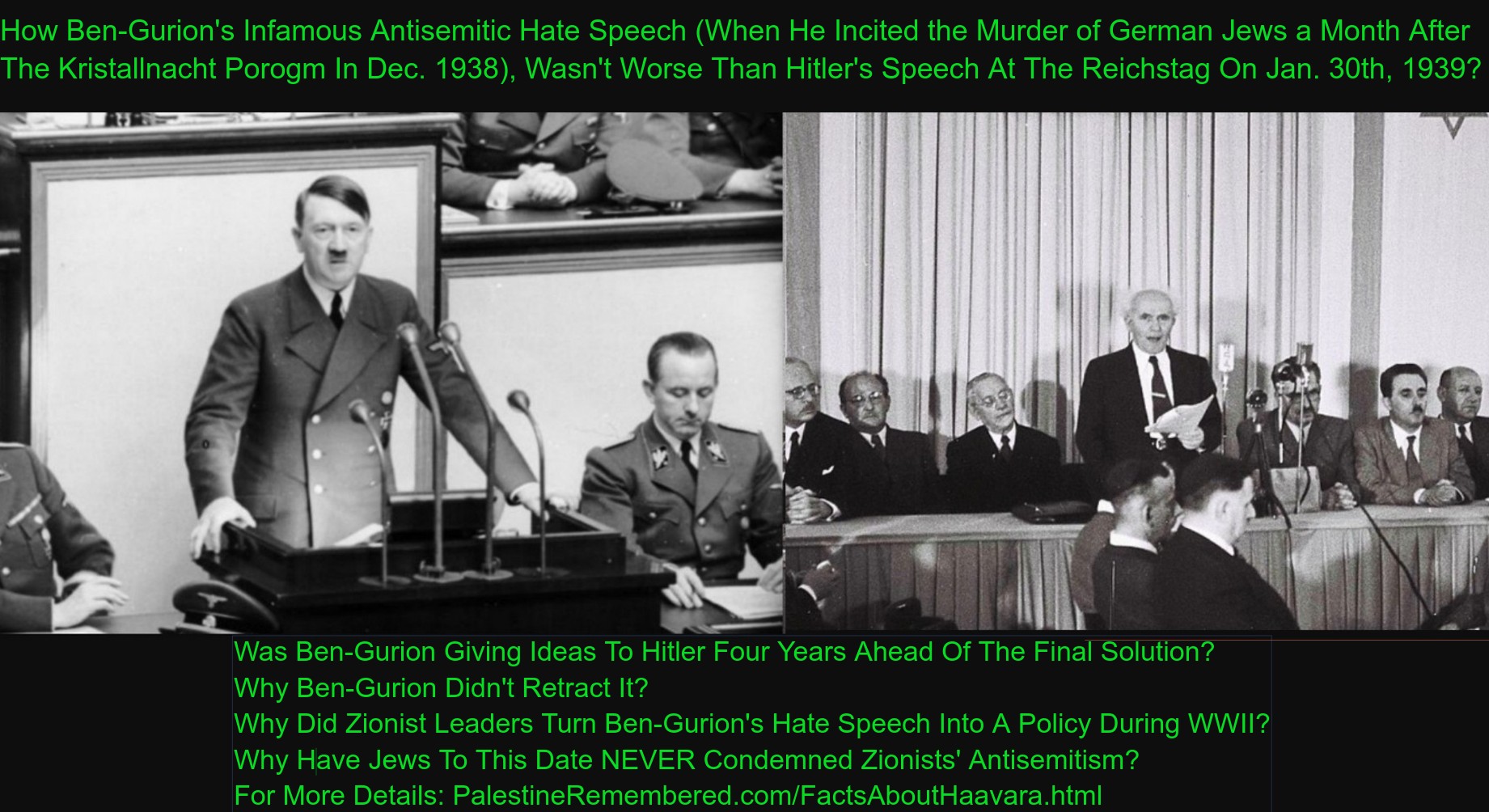 Which hate speech is more antisemitic: Hitler's hate speech at the Reichstag on Jan 30th, 1939, or Ben-Gurion's hate speech a month after the Kristallnacht pogrom in December 1938? You be the judge!
Which hate speech is more antisemitic: Hitler's hate speech at the Reichstag on Jan 30th, 1939, or Ben-Gurion's hate speech a month after the Kristallnacht pogrom in December 1938? You be the judge!"I had to listen to the shouts of 'Jude Verrecke' of the organised bands of demonstrators marching past my house. Daily there were attacks on people and kidnappings, the most terrible kinds of mistreatment of any number of people of my acquaintance who were known to have Democratic or Socialistic views, or simply because they were Jews... When I left Berlin a few days ago I had the feeling that I was living in a condition of a constant and continuous pogrom worse than those that once took place in Russia because there the pogrom started and ended at a definite time. You will probably have heard by this time of the terrible pogrom in Koenigsberg... The relatives of the Jews who had been attacked and wounded did not dare even to bring the poor victims to the hospitals in Koenigsberg but had to transport them to Berlin and many succumbed to their wounds in the course of the transportation to Berlin.(12)
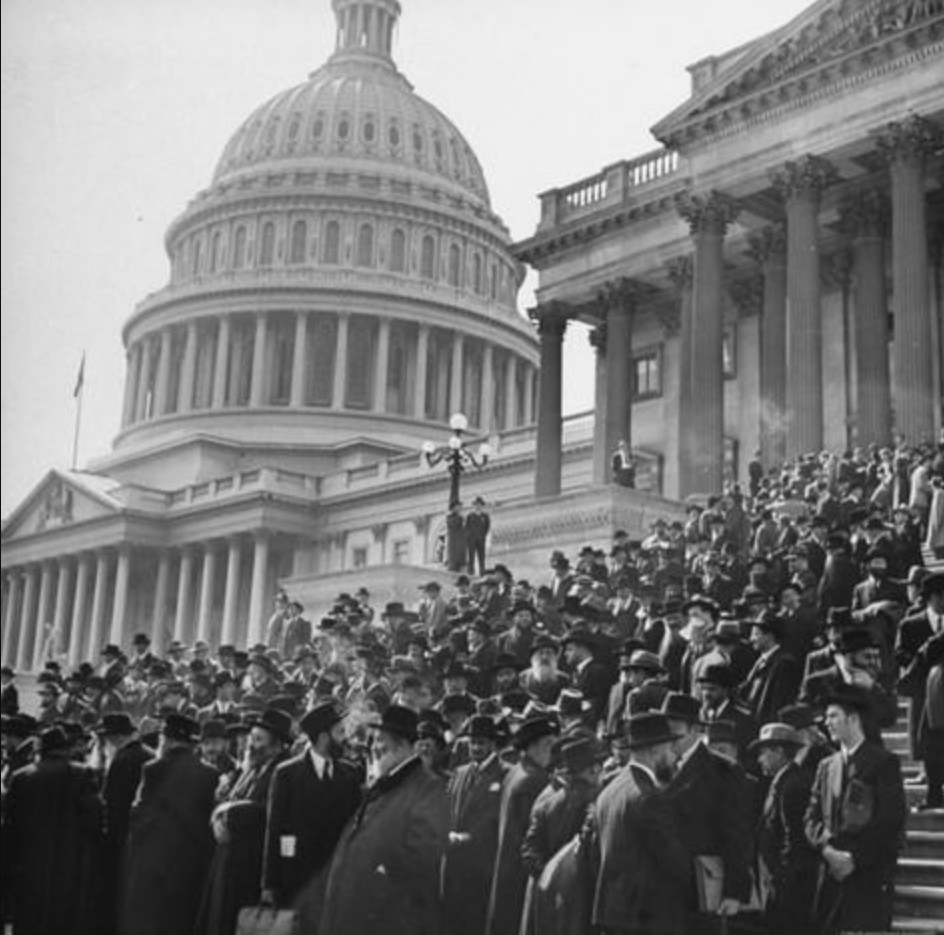 Fake Valor: When American Rabbis marched in DC in Oct. 1943 to lobby for rescuing Jews, you would think Zionists supported them?
Fake Valor: When American Rabbis marched in DC in Oct. 1943 to lobby for rescuing Jews, you would think Zionists supported them?Organised thuggery was accompanied by administrative measures to segregate the Jews from the rest of German society:
"On April 8, the new Civil Service Law was approved by the Cabinet and promulgated by Dr. Frick, the Reich Minister of the Interior. It barred all non-Aryans (except those who fought at the front who lost a father or son in the World War) from any position jn Federal, State or Municipal Civil Service... (April 12) Matriculated Jews could not be members of the student body. On the same day the Government barred Jewish political editors from its press conferences... On March 20, the official Court Bureau announced the purging throughout Germany of the offices of the prosecuting attorneys and the removal of Jewish judges from the Criminal to the Civil Courts. But by March 31, there had been a change of heart and all Jewish lawyers and judges were removed.
"In Prussia on March 31, the Diet petitioned the Minister of Education for dismissal of all Jewish teachers and for limiting Jewish Students not only in universities but in lower schools to one percent... (In Munich) the Superintendent of Schools went further to announce that, in the next term, no Jewish children would be allowed in Christian schools. nor would Jewish school doctors be allowed to treat Christian children".(13) The devastating effect of such discrimination was illustrated in this dispatch from the Jewish Telegraphic Agency:
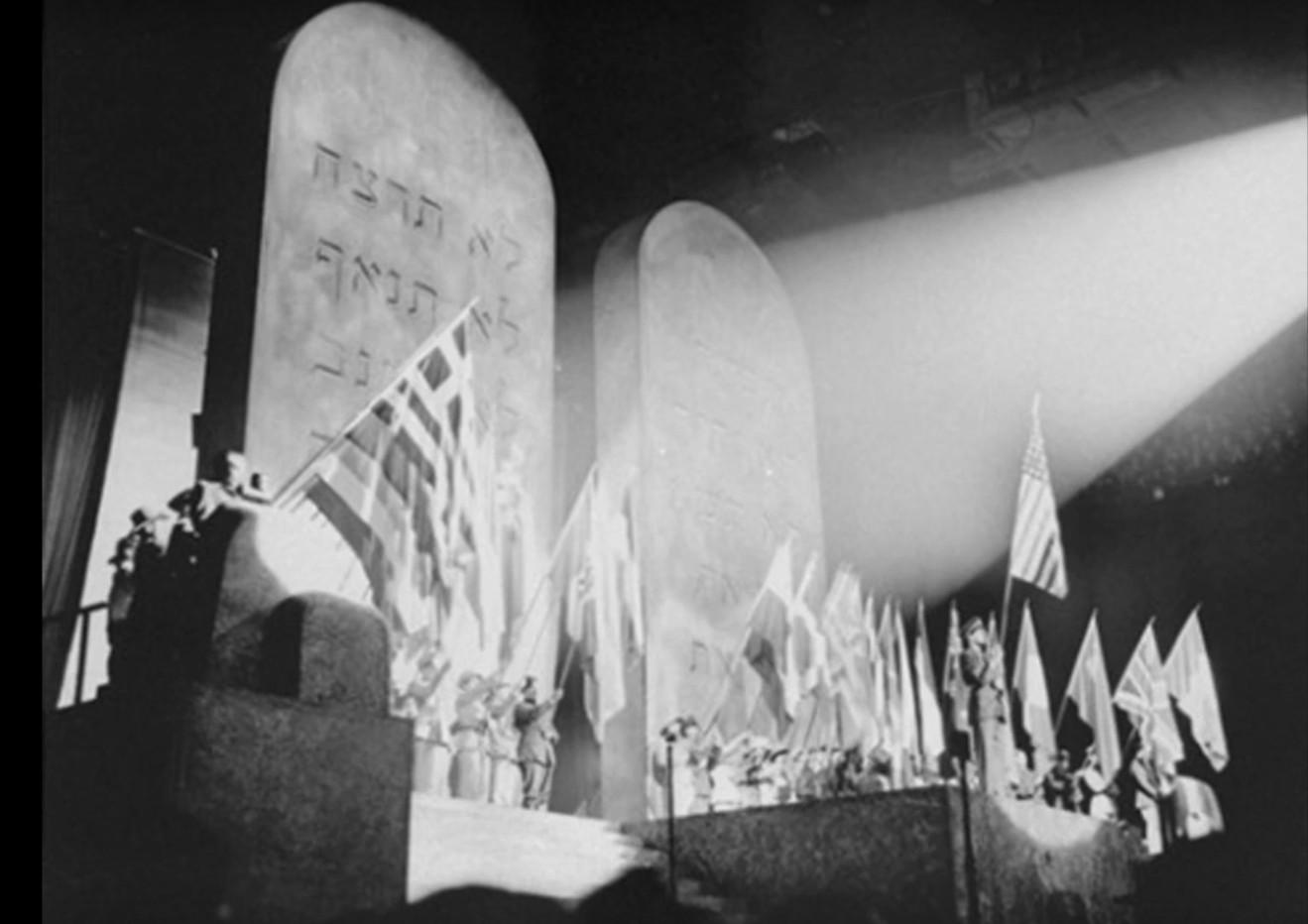 When the Bergson Group organized pageants in major US cities during the Holocaust, why did Zionists leaders lobby to shut them down?
When the Bergson Group organized pageants in major US cities during the Holocaust, why did Zionists leaders lobby to shut them down?"Jewish breadlines in Germany are doubling overnight, the number of the helpless leaping from thirty to eighty thousand in less than a week... Most of these are ruined middle-class folk, shopkeepers, white-collar workers, and professional people who have been forced to give up their means of livelihood by the anti-Semitic measures."(14)
The viciousness of Nazism was thus established beyond all doubt from the moment it came to power. What was the purpose of such measures? According to one eminent Jewish legal expert, "the inevitable consequence of the campaign of dismissal and exclusion by law, and of violence and outrage under the protection of outlawry of Jews and liberals, was a large exodus of Jews, non-Aryans and liberals from Germany.(15)
How did Zionism react to the cruel Nazi measures? In effect, the Zionist movement also believed that Jews should not be part of Gentile society. This fact explains why the rise of Nazism resulted in greatly increased strength for Zionism among German Jews. It also explains why a convinced Nazi-like Adolf Eichmann was able to be on cordial terms with Zionists, and even describe himself as pro-Zionist, while remaining dedicated to the Nazi ideology.
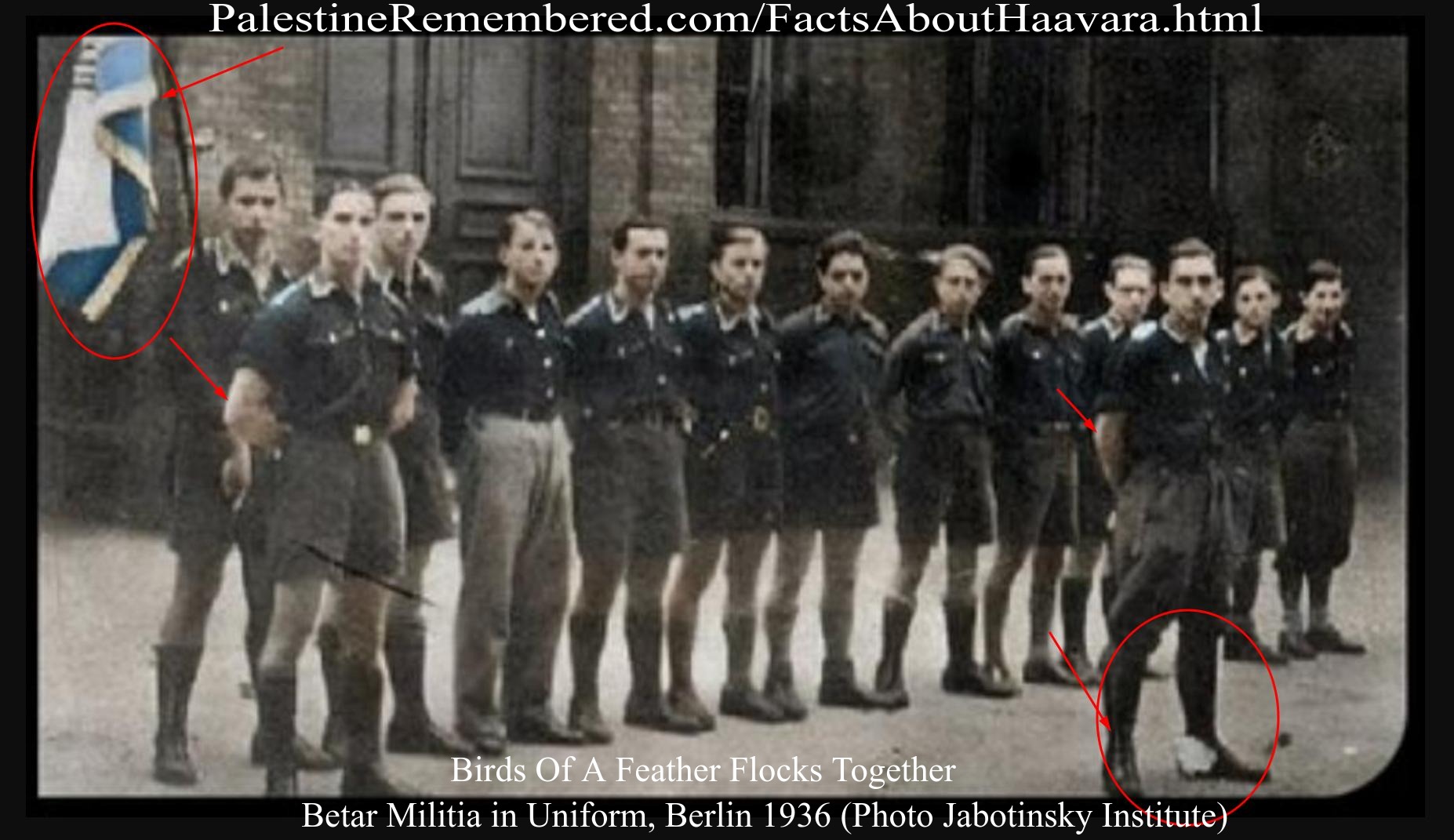 Zionists were the only non-Nazi parties allowed to operate in Nazi Germany! Pay attention to Betar's SS-look-like uniforms!
Zionists were the only non-Nazi parties allowed to operate in Nazi Germany! Pay attention to Betar's SS-look-like uniforms!Eichmann "was by no means alone in taking this 'pro-Zionism' seriously; the German Jews themselves thought it would be sufficient to undo 'assimilation' through a new process of 'dissimilation' and flocked into the ranks of the Zionist movement. (There are no reliable statistics on this development, but it is estimated that the circulation of the Zionist weekly Die Judische Rundschau increased in the first months of the Hitler regime from approximately 5-7,000 to nearly 40,000, and it is known that the Zionist fundraising organisations received in 1935-36, from a greatly diminished and impoverished population, three times as much as in 1931-32). This did not necessarily mean that the Jews wished to emigrate to Palestine; it was more a matter of pride: 'Wear it with pride, the Yellow Star', the most popular slogan of these years, coined by Robert Weltsch, editor-in-chief of the Judische Rundschau, expressed the general emotional atmosphere. The polemical point of the slogan, formulated as a response to Boycott Day, April l, 1933 -- more than six years before the Nazis actually forced the Jews to wear a badge, a six-pointed yellow star on a white ground --was directed against the 'assimilationists' and all those people who refused to be reconciled to the new 'revolutionary development, those who 'were always behind the times. (16)
Zionism certainly benefited from the fact that the rise of Hitler led to the crushing of its main rivals for ideological leadership of German Jewry. "It was in those years a fact of everyday life that only Zionists had any chance of negotiating with the German authorities, for the simple reason that their chief Jewish adversary. the Central Association of German Citizens of Jewish Faith, to which 95 percent of organised Jews in Germany then belonged, specified in its bylaws chat its chief task was the 'fight against anti-Semitism'; it had suddenly become by definition an organisation 'hostile to the State'... During its first few years, Hitler's rise to power appeared to the Zionists chiefly as 'the decisive defeat of assimilationism'. Hence, the Zionists could, for a time at least, engage in a certain amount of non-criminal co-operation with the Nazi authorities; the Zionists too believed that "dissimilation' combined with the emigration to Palestine of Jewish youngsters and, they hoped, Jewish capitalists, could be a 'mutually fair solution'. At the time, many German officials held this opinion."(17)
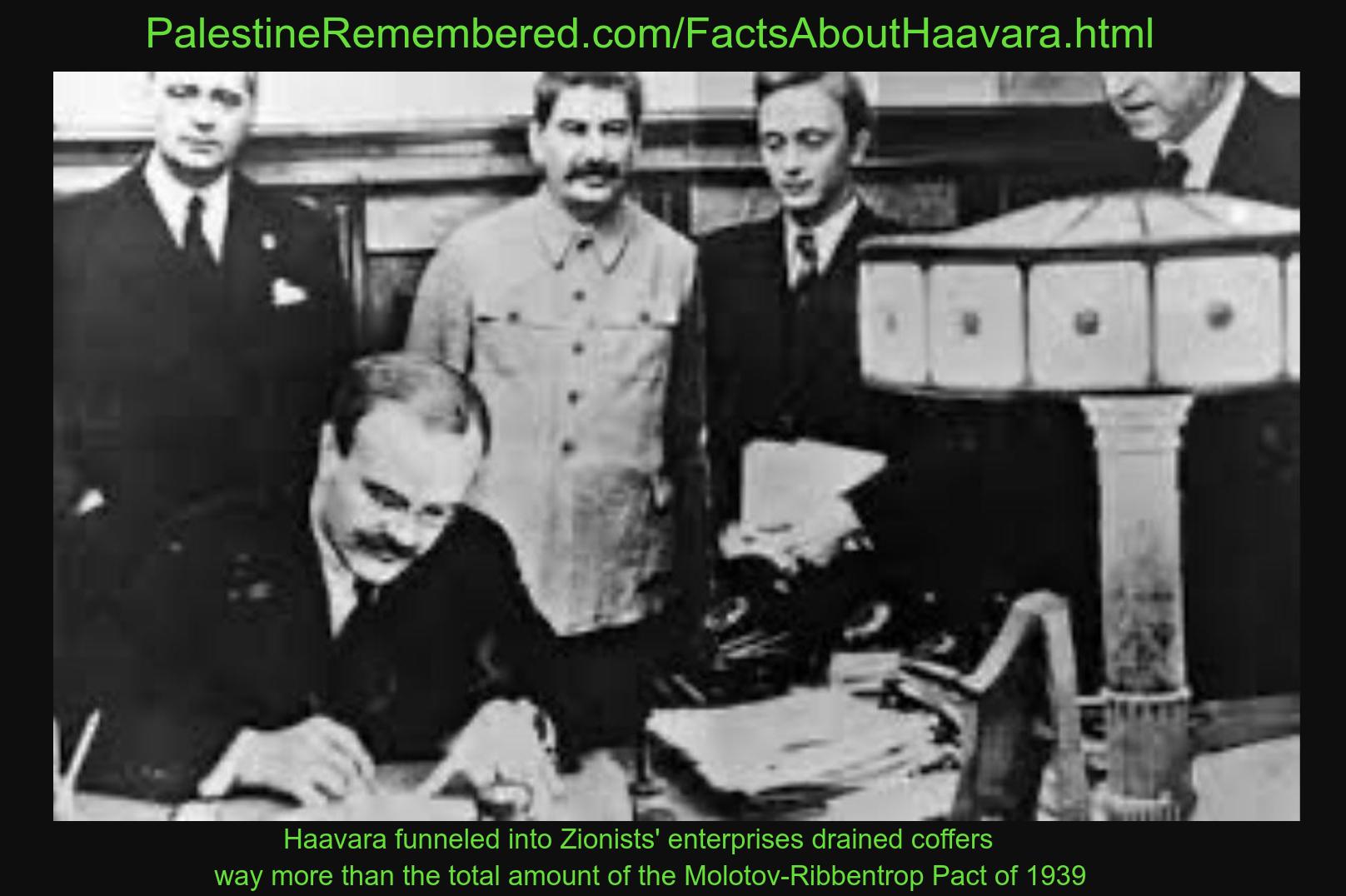 Haavara funneled into Zionists' enterprises drained coffers more than the total amount of the Molotov-Ribbentrop Pact of 1939
Haavara funneled into Zionists' enterprises drained coffers more than the total amount of the Molotov-Ribbentrop Pact of 1939This "non-criminal" co-operation between Nazism and Zionism in the early years was in fact to prove the thin end of the wedge, destined later to open the door to much wider and more serious cooperation that became less and less "non-criminal" in character as Nazi policy developed. Even before Hitler became Chanceller the common interests between Zionism and Nazism had extended beyond the principle of dissimilation of German Jews to Nazi endorsement of a central point in the Zionist programme: the migration of Jews to Palestine. Thus as early as 20 June 1932, "three hundred Nazis marched through the streets of Breslau and terrorised Jewish passersby, shouting 'Let the Jews go to Palestine." (18)
This policy of encouraging the Jews to emigrate to Palestine received the blessing of Hitler himself. Although earlier, when he wrote Mein Kampf, he had not believed that the Zionists really intended to found a state, once he came to power he revised his opinion of them and took them more seriously. "It was precisely the Zionists who showed themselves ready to 'free Germany of its Jews'. And since this aim took priority over all the others, Hitler was to accept, with the pragmatism for which he was known, to compromise on his own doctrinal teachings.
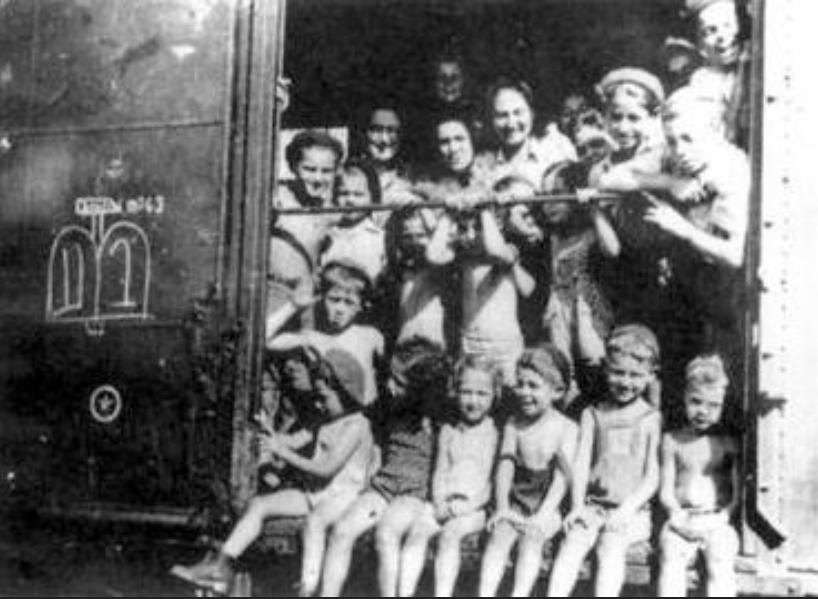
How does justifying Haavara after the fact doesn't resemble Rudolf Kastner's defense for what happened on his famous train but at a much larger scale? Kastner train passengers on their way to Switzerland, 1944
"The objectives, it was to be concluded at the Wilhelmstrasse, that this category (of Jews who oppose assimilation and are favourable to a regrouping of their co-religonists in a national home) had set themselves, in whose front rank were the Zionists, are those that deviate least from the goals which German policy is really pursuing with regard to the Jews.
"The only Jews with whom, in the final analysis, various organs of the Third Reich, and particularly the Ministries of Foreign Affairs and the Economy were to establish real working relations, were in effect the Zionists and the Palestinian Jews.(19)
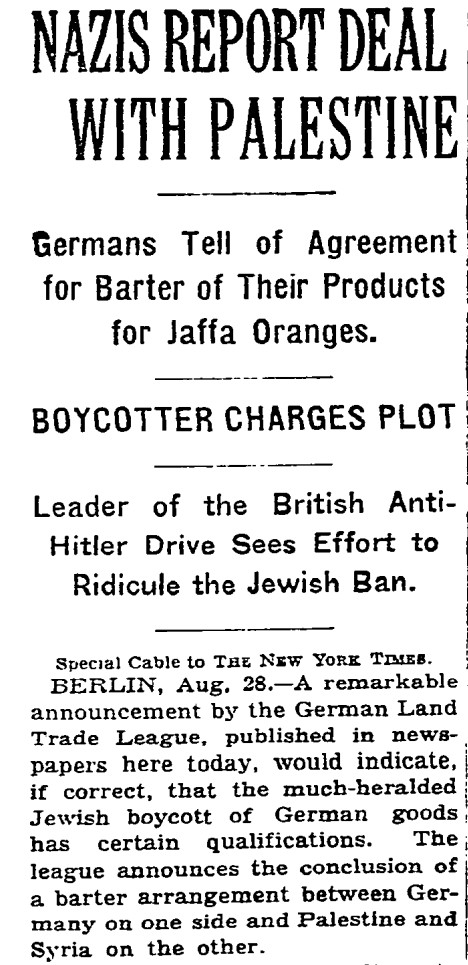
NYTimes: Aug 29, 1933: Germans Tell of Agreement for Barter of Their Products not only Palestinian oranges but with Syria's oranges too!
III. The Ha'avara Agreements
The relationship between Zionism and Nazism was soon formalised in an agreement, the first of a series.
"Jews emigrating to Palestine were given a special opportunity to remove their capital by the so-called Ha'avara agreement. This agreement was concluded by the German Reich and the Jewish Agency for Palestine. In form, it was a modified clearing arrangement. Under its terms, a Jewish 'capitalist' who wanted to emigrate to Palestine was permitted to make a contract with a German exporter for the transfer of goods from Germany to Palestine. The German exporter was paid with funds drawn from the blocked account of the emigrating Jew. The emigrant received his Palestinian currency from the Jewish Agency upon arrival in Palestine.
"The Jewish Agency and the exporters were just as satisfied with this arrangement as the emigrants themselves. German goods poured into Palestine and, after a while, the Ha'avara clearing agreement was supplemented by a barter agreement providing for the exchange of Palestine oranges for German timber, wrapping paper, motor cars, pumps, agricultural machinery, etc. It seemed as though the economic relations between Nazi Germany and the Jewish community in Palestine were excellent." (20)
Probably the most painstaking research done so far on the Ha'avara agreements is that of Eliahu Ben Elissar. A doctor of political science and a former senior civil servant in the Israeli Presidency, as well as a senior member of the Likud, he is eminently qualified to write on the subject. He discovered that the first approach was made to Germany in April 1933 by Sam Cohen, director Of the Ha'notea company. He signed a deal worth 1 million marks, later increased to 3 million.
"Those of the World Zionist Organisation responsible for Germany, who were in no way opposed to the principle of such an agreement, felt no enthusiasm at seeing it thus concluded with a company which was in fact private and of limited scope. They doubted that the Ha'notea disposed of enough financial means to ensure in this precise case the good functioning of an operation whose political importance outweighed its purely commercial interest.
"Werner Senator, of the Zionist Federation of Germany, and George Landauer, of the Jewish Agency, therefore began negotiations with the Ministries of Foreign Affairs and the Economy...
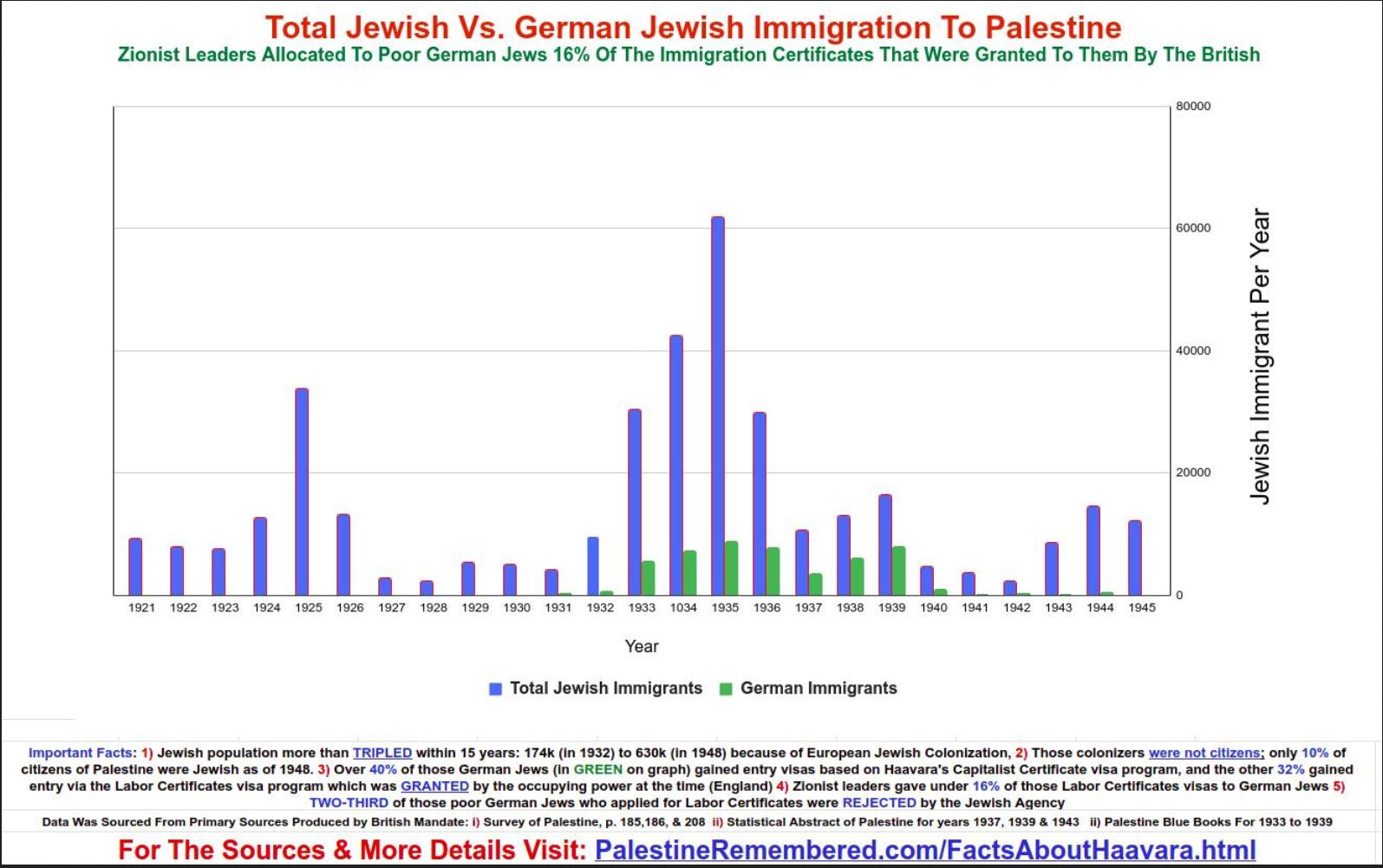 Palestine's Total Jewish Immigration Vs. German Jewish immigration during the pre-Nakba period
Palestine's Total Jewish Immigration Vs. German Jewish immigration during the pre-Nakba period"The Germans, who by all evidence were eager to reach a rapid conclusion, took the initiative of calling a conference with the participation of all the Jews concerned. The conference opened, on 7 August,in the Ministry of the Economy's offices. On the Jewish side there were: Cohen and Machnes who represented the Ha'notea, delegates from the Zionist Federation Of Germany and two personalities who came specially from Palestine for this purpose, Hoofien, director of the Anglo-Palestine Bank whose interests were intimately linked to those of the Zionist Organisation, and Ruppin, a sociologist and great specialist in questions of Jewish colonisation in Palestine.
 Nesher cement factory-Haifa may have been a recipient of Haavara-related funds since it had a monopoly on cement
Nesher cement factory-Haifa may have been a recipient of Haavara-related funds since it had a monopoly on cement"The stipulations of the agreement which the conference reached were as follows: Sam Cohen agreed to consider void all agreements prior to 7 August. A trust company would be created directed by Hoofien and under the auspices of the Anglo-Palestine Bank. Its function would be to manage Jewish interests and negotiate with German exporters and industrialists. The total of transactions remained fixed at three million Reischmarks, with the possibility of renewal...
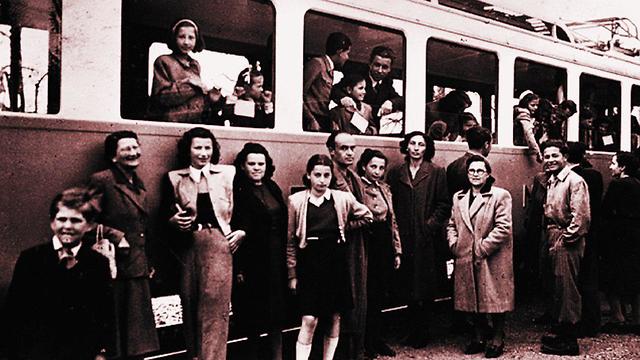
How does justifying Haavara after the fact doesn't resemble Rudolf Kastner's defense for what happened on his famous train but at a much larger scale? Kastner train passengers on their way to Switzerland, 1944
"The agreement and the overall operations were known under the name of Ha'avara -- a Hebrew word which means transfer--and which was also to be the social reason for the trust company (Ha'avara Trust and Transfer Office) whose headquarters was in Palestine, The company which was to be specially established to represent it in Berlin would be called Paltreu...
"On 21 August 1933 the 18th. Zionist Congress, the first to meet since Hitler came to power, opened in Prague. The situation of the Jews in Germany was, naturally, the central theme under consideration and discussion. Hoofien and Ruppin had come straight to Prague from Berlin. A large number of delegates reproached Hoofien and Cohen, the two chief negotiators, with having made common cause with the devil and with having, through the Ha'avara agreement, undermined the Jews' struggle against the racist policy of the Reich. Impassioned exchanges took place. But a motion envisaging the Organisation's effective participation in the efforts to boycott Germany was not adopted." (21)
The efforts of anti-Nazi Jewish circles to organise a boycott of Nazi Germany arose as a counter-measure to the Nazi authorities' boycott of I April 1933. This was "a general boycott... of all Jewish places of business and of all Jewish doctors, lawyers, and other professional men. From that day, for the next six years and a half, there was a succession of acts of increasing inhumanity until the outbreak of war ushered in a region of unparalleled barbarity. The boycott was merely a prelude to a system Of persecution that robbed Jews of every source of livelihood." (22)
Jews in many parts of the world hoped that by retaliating with a boycott of German goods they could show solidarity with their oppressed co-religionists and perhaps pressure the Nazi regime into relaxing the persecution. The Zionists' signature of the Ha'avara agreement effectively sabotaged this hope. "The result was that in the thirties when American Jewry took great pains to organise a boycott of German merchandise, Palestine, Of all places, was swamped with all kinds of goods 'made in Germany" (23)
Well before the 18th. Zionist Congress, the Zionist movement has made clear its intention of sabotaging the anti-Nazi boycott. The Zionist Federation of Germany went so far as to reassure a senior Nazi official that "the propaganda which calls for boycotting Germany, in the manner it is frequently conducted today, is by its very essence completely un-Zionist." (24)
The unfortunate precedent was thus created of sacrificing the interests of the Jewish masses in Europe for the sake of Zionist political ambitions. The usefulness of this was not lost on the Nazis.
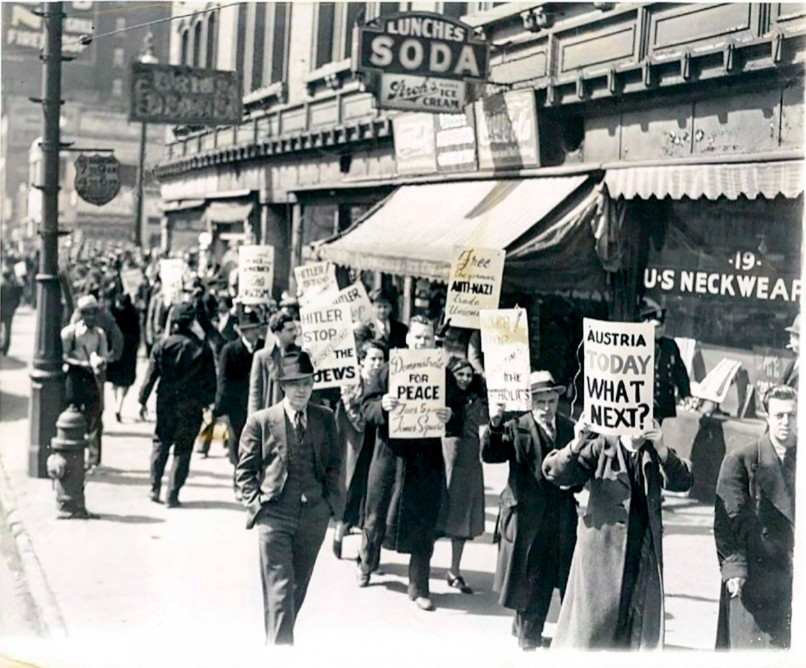 Anti-Nazi Demonstration in Detroit, March 13, 1938. If this happened in Palestine, D. Ben-Gurion would have arrested them! Are you surprised?
Anti-Nazi Demonstration in Detroit, March 13, 1938. If this happened in Palestine, D. Ben-Gurion would have arrested them! Are you surprised?"In signing... the Ha'avara agreement, the German authorities were simultaneously pursuing two objectives: breaching the boycott organised against Germany by the Jews in various foreign countries and facilitating the departure of Jews from the Reich to Palestine.
"But, little by little, the second objective came to be considered the more important in Berlin. On one hand, the effects of the Jewish boycott had been considerably weakened while on the other hand, the expatriation of the Jews had become one of the major goals of the National Socialist regime's internal policy. Now the Zionists were the only ones, among Jews and non-Jews, to propose a constructive solution to the Jewish problem in Germany and above all to be able to put it into effect. The Ha'avara had provided them with the means for this. The German government could not remain indifferent to that. Thus one saw the Ministries of the Interior and the Economy simultaneously vying with each other to establish the Ha'avara and develop the activities of the Zionist Organisation in Germany.
"The organs of the Ha'avara thus gradually acquired a dominant, even privileged, position in German-Palestine trade... Urged on by the Zionist leaders in Germany, the 19th. Zionist Congress, which met in Lucerne from 20 August to 3 September 1935, decided to place the whole Ha'avara system under the direct control of the Zionist Executive Committee whose shares, held hitherto by the Anglo-Palestine Bank, were consequently transferred. In 1933, the transfer operations realised by the Ha'avara were for 1,254,956 marks. In 1937, they reached the value of 31,407,501 marks."(25)
Shortly after the 19th. Zionist Congress, on 15 September 1935. the Nazi regime passed the Nuremberg Laws, which Gerald Reitlinger has aptly termed the most murderous legislative instrument known to European history. "The character of these Nuremberg Laws was twofold. There was first the Reich Law of Citizenship which established two degrees, the Reichsbürger who must be of pure German blood, and the Staatsanhoriger who was a subject but not a citizen. The Slaw for the protection of German blood and honor' was complimentary, for it added the principle that the two should not cohabit together in wedlock or out of it." (26)
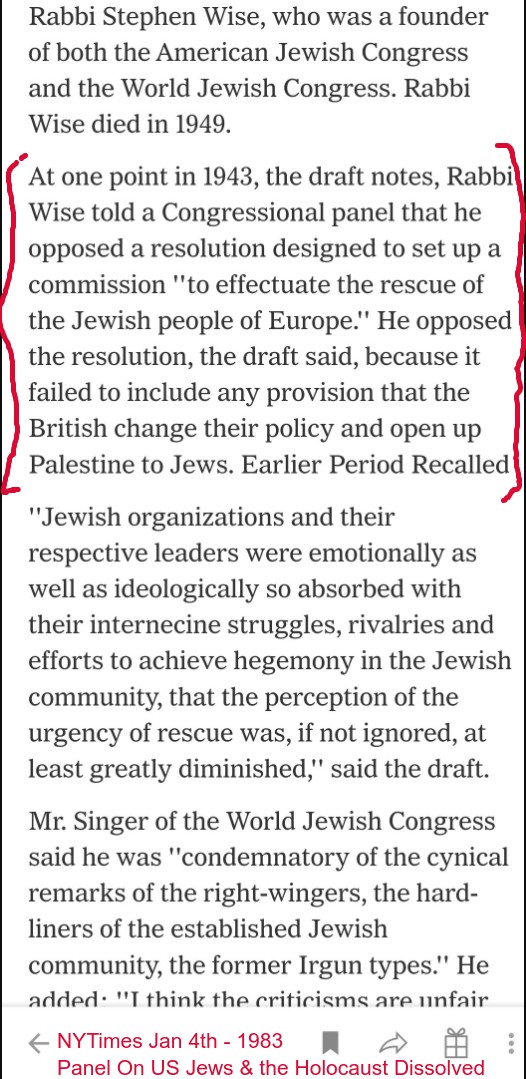 NYTimes, as late as 1943 Zionist leaders were lobbying US Congress to block Jewish refugees' safe havens unless GB opened immigration into Palestine
NYTimes, as late as 1943 Zionist leaders were lobbying US Congress to block Jewish refugees' safe havens unless GB opened immigration into PalestineWe have noted that the Ha'avara agreements reached a record level in 1937, two years after the Nuremberg Laws were passed, so the Zionists clearly did not allow them to become an obstacle to a profitable co-operation. Ironically, the privileges which the Zionist movement had been gaining since Hitler came to power actually increased with the Nuremberg Laws, while the German Jews' position continued to deteriorate.
"The Zionist Organisation was authorized to open professional and agricultural training centres for candidates for emigration who wanted to prepare themselves for a new life in the Middle East. Hebrew courses were organised in several towns and, under the direction of a man of great value, Robert Weltsch, a Zionist newspaper, the Judische Rundschau, brought the hope of a better life to thousands of Jewish homes. The Ministry of the Interior authorized a delegation of German Zionists to participate in the 19th. Zionist Congress.
"In spite of the decision taken on 19 December 1934 to forbid members of Jewish youth movements to wear their traditional uniforms, on 13 April 1935 the political police of Bavaria, a veritable preserve of Himmler and Heydrich at the time, allowed as an exception the wearing of the uniform by the members of one of these movements because 'it is established that the "State Zionists" are precisely those whose organisation is trying by all means, even in illegal ways, to send its members to Palestine'...
"Alfred Rosenberg himself, in an interview granted on 3 May 1935 to Raymond Cartier of L'Echo de Paris, recognised the merits of Zionism because it was opposed to the assimilation of Jews.
"One of the two Nuremberg Laws, that on 'the protection of German blood and honour', which had forbidden the Jews to raise the national flag with the swastika nevertheless authorised them to display the 'Jewish colours' which were none other than the blue and white of the Zionist flag stamped with the star of David "(27)
Zionist cooperation with Nazi Germany should also be seen in the light of Nazism's contamination of other countries in Europe, notably Poland and Romania, with the virus of racism during the 1930's. The suffering of German Jews was rapidly extended to others, as is clear from this contemporary account:
"The relentless drive of organised anti-Semitism, and the failure of the governments to concern themselves with the Jewish problem in a positive and constructive manner, have already produced far-reaching effects upon the Jews. These are most clearly evident in the state of panic and despair to which the Jews, notably those of Poland and Rumania. have been reduced; in the segregation and isolation of the hapless people in a number of countries; in the pauperisation of large masses of Jews; and in the relative, if not absolute, a decline of the Jewish population.
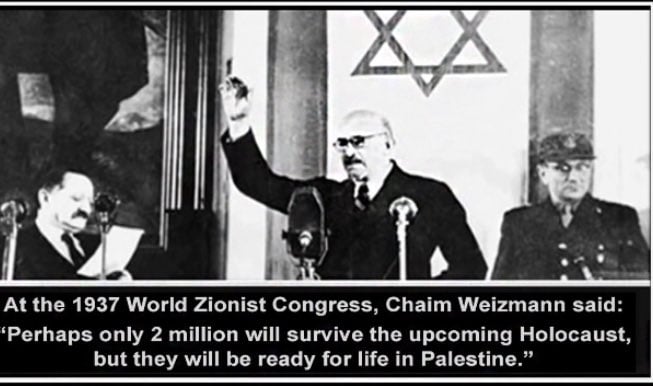 Catastrophic Zionism at its worse,. Zionists spoke of the Holocaust decades before its time & encouraged its inevitability
Catastrophic Zionism at its worse,. Zionists spoke of the Holocaust decades before its time & encouraged its inevitability"The Jews of east-central Europe are terror-stricken. They have been the victims of so virulent a campaign of hatred and abuse, especially since the Nazis rose to power in Germany, that they are in a state of chronic anxiety, ever apprehensive of what the morrow might bring...
"The Jews are being segregated socially. The narrowing of economic opportunities tends to isolate the Jew. But even more noteworthy, morally and psychologically, are the effects of segregation in the social sphere. To the question whether they still had non-Jewish friends, Danzig Jews replied sadly, 'our lifelong Gentile friends dare not associate with us.' They told, with evident pain, of being ignored on the streets by school chums, colleagues and friends; and an occasional, furtive apology of a generous Christian was remembered with touching gratitude." (28)
Instead of attempting to fight this situation, however, Zionist leaders saw the suffering of these Jews as something from which they could make useful political capital. "The 20th. Zionist Congress in fact met in Zurich from 3 to 17 August 1937 to discuss the Palestine partition plan, and Chaim Weizmann, the Organisation's President, was to go to Poland and Rumania to ensure the support of these countries for the creation of a Jewish state. The policy of Warsaw and Bucharest was in reality very clear. A community of about 3,500.000 Jews lived in Poland and nearly 800,000 Jews lived in Rumania. Just like Berlin, Warsaw and Bucharest were interested in seeing the Jews leave their national territory. So these two capitals were very favorable to the arguments put forward by the Zionists." (29)
The Ha'avara system continued in force until the outbreak of the Second World War [Haavara had two portions: trade & money transfer. The later was shut down by Americans in December of 1941]. During the period when it was applied, the deals carried out under its auspices amounted to a total of 140 million marks [We found the Haavara transaction was much larger]. Towards the close of this period, some quarters in Germany attempted to have it revised or abrogated, without success. After reaching its peak in 1937, the volume of transactions began to fall, largely owing to the impoverishment of those Jews still left in Germany. Thus, from 1 January 1938 to 1 September 1939, transfer operations fell to around 27 million marks; more than 4 million marks less than in the year 1937.(30) Meanwhile, the new measures adopted by Nazi Germany to force Jews to emigrate, coupled with the Anschluss with Austria, required new and more comprehensive agreements to supersede the Ha'avara.

NYTimes: Aug 29, 1933: Germans Tell of Agreement for Barter of Their Products not only Palestinian oranges but with Syria's oranges too!
The 1938 Emigration Accords
The year 1938 was to prove a triumphant one for Hitler. Its highlights included his annexation of Austria and the Munich Agreement, the diplomatic capitulation of the British and French Governments which enabled the Nazis to dismember Czechoslovakia. These successes emboldened the Nazis to intensify their campaign to force the Jews out of Europe, and the acquisition of new territories brought more Jews, in large numbers, within the scope of this campaign. The end of the year witnessed the notorious pogrom known as the Kristallnacht.
It is relevant to remind ourselves here of the precise goal of which Hitler never lost sight throughout this period. This was summarised eloquently by two Jewish legal experts, shortly before the intensified campaign was launched, in these words: "The avowed aim of the National Socialist Government is to force the emigration on a vast scale of the 'non-Aryan' population of Germany. This objective is being attained through a systematic. programme of discrimination and humiliation which is calculated to induce the flight from their homes of hundreds of thousands of individuals." (31)
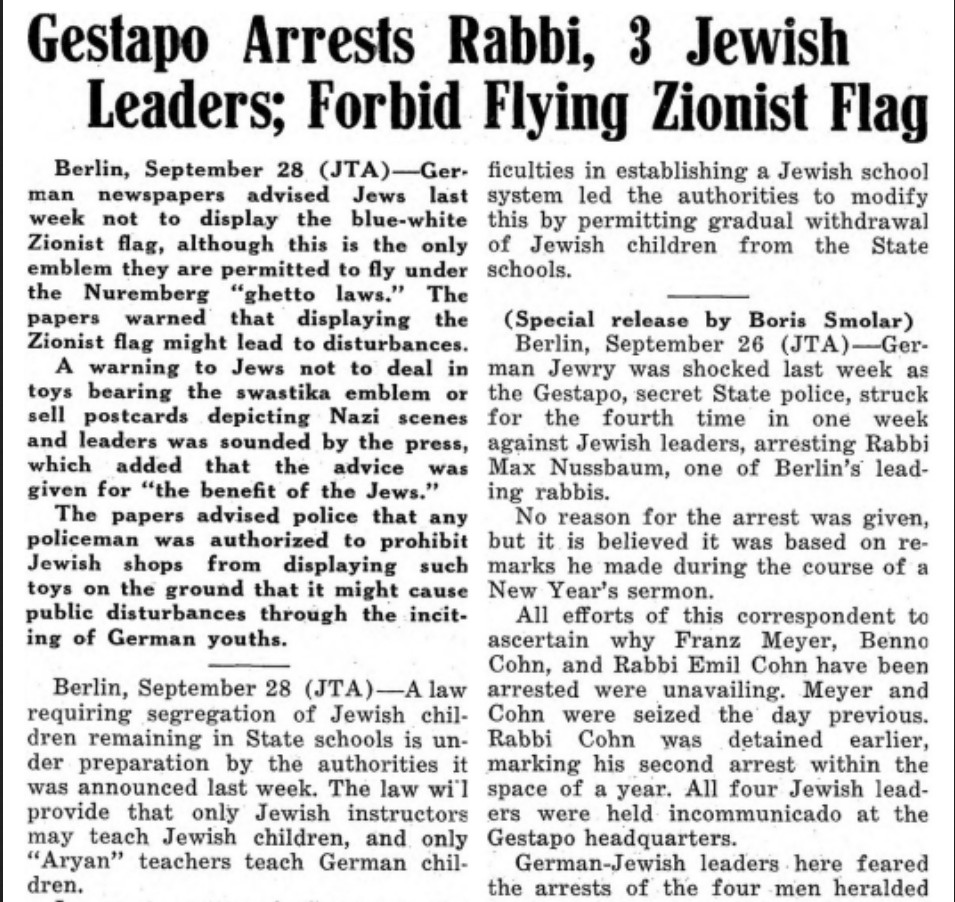
Zionists defied German Jewish leaders who demanded that Jews should not raise fascists' (Zionists & Nazis) flags
However, the agreements reached hitherto with Zionism were not adequate for Nazi purposes, and the pace of emigration was considered too slow, as this account indicates:
"The central Jewish organisation known as the 'Zentralauschuss der Deutschen Judenfur Hilfe und Aufbau'...was established in 1933 in the Reich. That body had three principal divisions dealing with emigration, economic assistance, and relief and it was the special function of the office for economic assistance to assist in the change of vocation and the training of the young... At the time of writing (October 1935) there are ten training camps, with a total of 2,700 young men and women. The larger number are instructed in agriculture. The German Government constantly makes difficulties and threatens the complete dissolution of the camps, on the pretext that Jews may not be assisted to prepare for manual occupations in Germany. It is hoped, therefore, to enlarge the youth emigration to Palestine, so that thousands may go each year." (32)
We have already noted above that the Nazis had allowed the Zionists to establish special training schools to prepare emigrants for life in the Middle East. What the common interests of both parties now required was a speeding up Of emigration, and measures to bring the training programme under tighter Zionist-Nazi control. The Zionists sent special envoys to make the necessary arrangements, while the Nazis held constant meetings to plan their strategy for the expulsion of Jews.
"In the course of the first session of the steering committee of the 'Central Office', on 11 February 1939, Heydrich explained that Germany had no reason to give up sending illegal transports of emigrants to Palestine..
"Illegal transports, Heydrich continued, would in any case set out for Palestine from several European countries. So Germany could have recourse to the same procedures. Hinrichs and Eisenlohr, from the Wilhelmstrasse, far from raising any objections, insisted on the contrary that 'Germany should profit from any occasion offered to her to throw a Jew out.' Wohlthat did not lag behind. 'Palestine could absorb some 800,000 to one million extra Jews,' he reported having heard in London, 'and if the Jews of Germany did not go there, other countries could well provide this contingent.'
"Since the end of December 1938, two delegates from Palestine, Pinhas Ginsberg and Max Zimels, had been working without intermission on the territory of the Reich preparing illegal convoys to Palestine. The Gestapo would put no obstacles in the way of their activity. "(33)
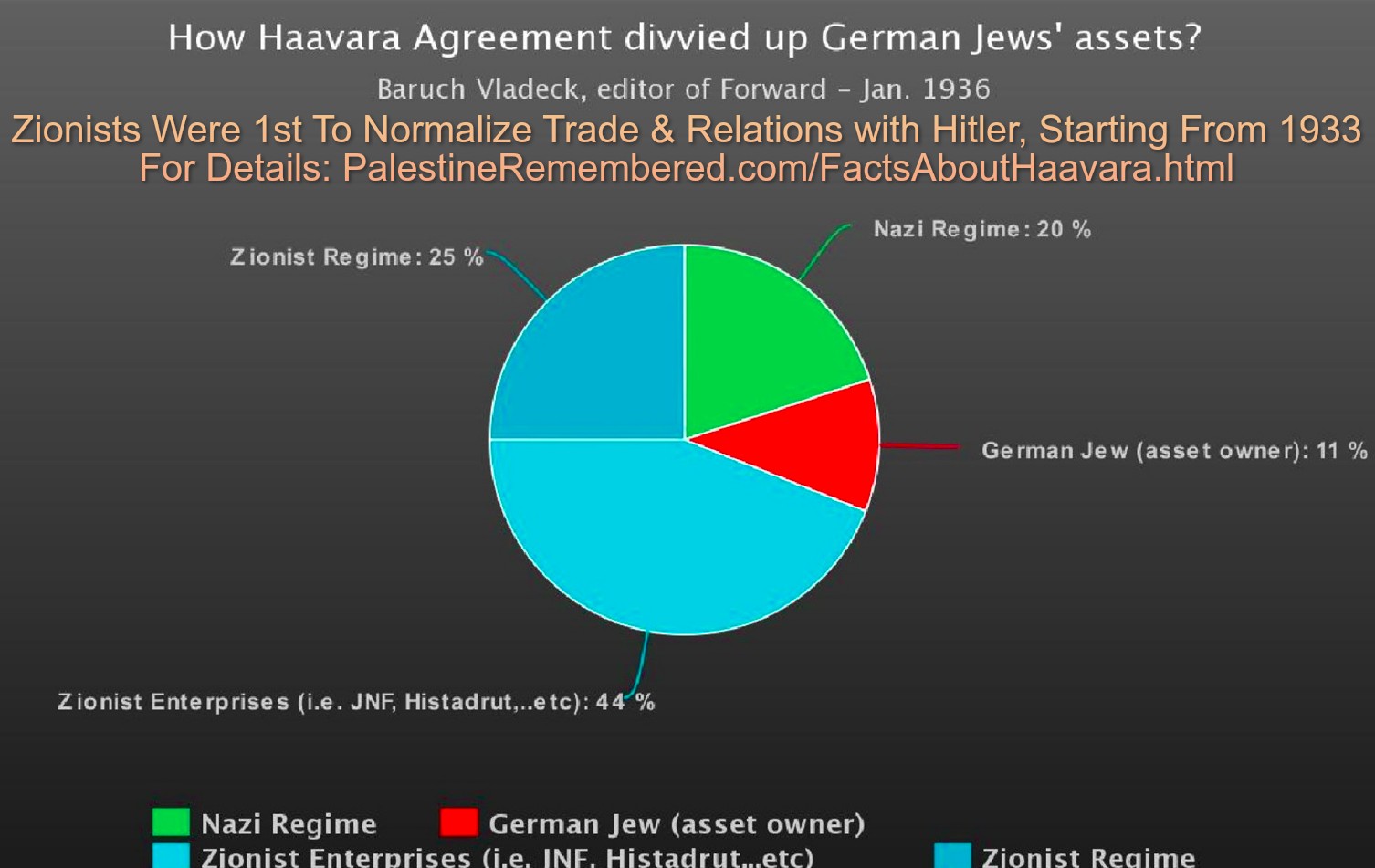 Click to enlarge: How German
Jews' assets were divided. Note that shares in communal collectives
aren't redeemable as if they are shares in a normal corporation! Even
cash isn't available all at once!
Click to enlarge: How German
Jews' assets were divided. Note that shares in communal collectives
aren't redeemable as if they are shares in a normal corporation! Even
cash isn't available all at once!Two Zionist writers, who refer to Ginsberg by his nickname "Pino", relate how the Jewish Agency sent him to meet the Supervisor of the Jewish Question at the Gestapo Headquarters: "He was on a special mission; his work was what the Nazis wanted; his aim was to organise the emigration of German Jews to Palestine; only with the assistance of the Nazi leaders could this project be carried out on a large scale. The Gestapo 'Supervisor" was now interested. He called in three other Gestapo officials. The interview had become a conference; the Gestapo was discussing how to aid and increase Jewish 'illegal' immigration into Palestine against the will of the British Mandatory."
Ginsberg accordingly requested Gestapo assistance for his scheme. The interview concluded he left the Gestapo HQ to go to the Zionist Organisation's Berlin office. "By the time the emissary reached the Zionist offices, excited officials told him that the Gestapo answer was waiting for him. He could stay. He could start work at once. He could even pick young Jewish pioneers who had been sent to concentration camps. He would not require to pass through the endless red tape of official channels. He could set up special training camps for the selected immigrants who would make the illegal run to Palestine through the British blockade... He had brought with him his long spoon; he was not worried that now he was about to sup with the devil. In fact, he felt no little satisfaction as he read the Gestapo reply." (34)
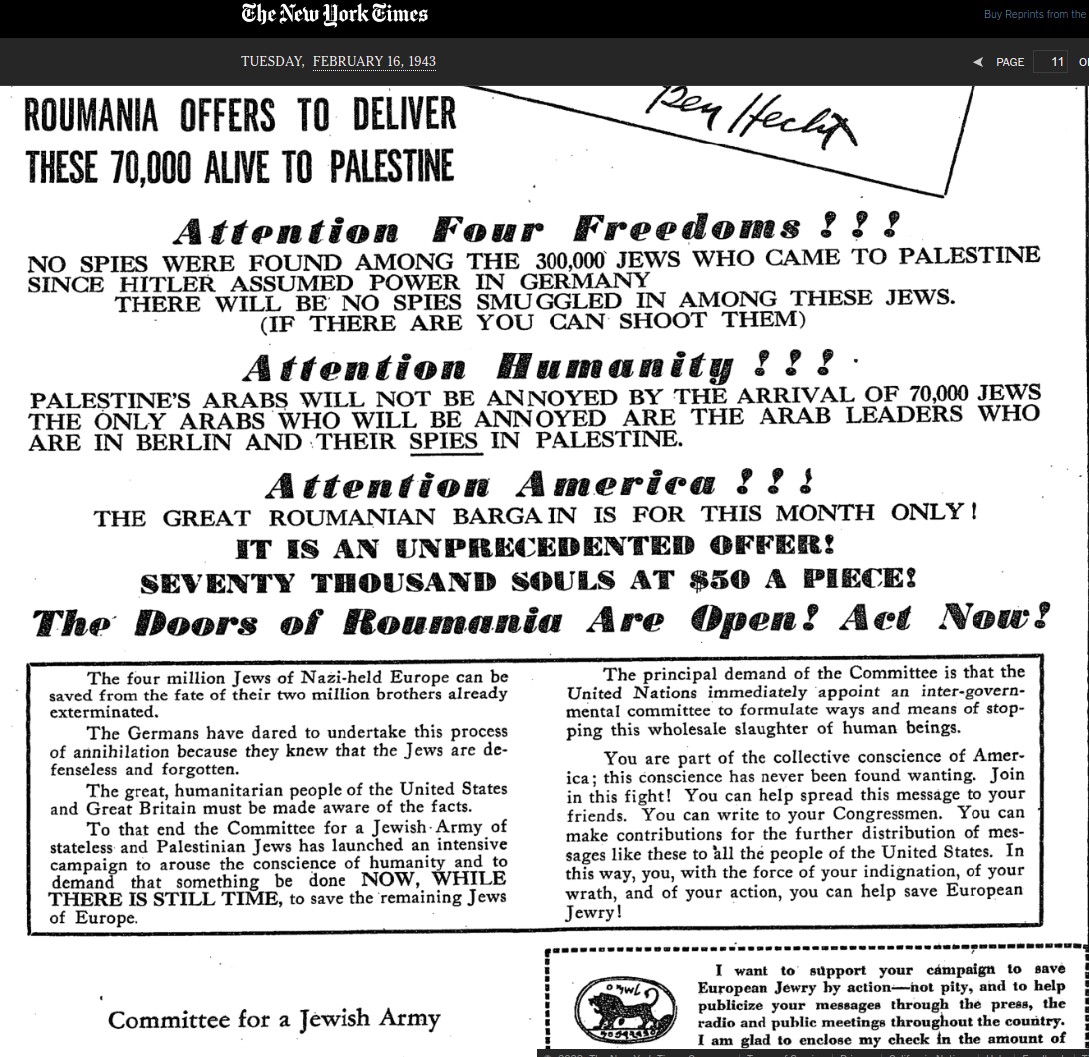 Two full page ads in the NY Times calling for the rescue of millions of European Jews but ONLY Palestine was cited!
Two full page ads in the NY Times calling for the rescue of millions of European Jews but ONLY Palestine was cited!Also during 1938, just after the Anschluss, the Zionists sent another envoy, Moshe Bar-Gilad, to Vienna on a similar mission. "Bar-Gilad, like his colleague in Berlin, soon discovered that the only road to large-scale emigration from Austria led through the Gestapo headquarters and the S.S. office for Jewish affairs for which the sumptuous mansion of Baron Rothschild had been requisitioned. There, in charge of the 'Central Bureau for Jewish Emigration', sat Captain Carl Adolf Eichmann. It was a name which was to become notorious... He received Bar-Gilad politely; he was also impressed by the forthright self-assurance and blunt speech of this unusual visitor. "Bar-Gilad explained that he wanted permission to establish pioneer training camps to train young people for work in Palestine and to arrange for their emigration as quickly as conditions permitted... A dissident Zionist group, the Revisionists, right-wing activists, were engaged in illegal transports to Palestine. Bar-Gilad explained that Revisionists took primarily those Jews who could pay the heavy cost of illegal transportation, while his organisation was interested in young people who were prepared to become pioneers. Most of them had no means. His organisation would bear the -entire cost. He wanted no financial help from the Gestapo; all he asked was that his work should not be obstructed."
Two weeks later, Bar-Gilad received Eichmann's answer to the Zionist movement's requests. "Eichmann told him that he would help in the provision of farms and facilities to set up training centres for intending emigrants, but the actual transportation must be left to the Revisionists, the dissident Zionists and to 'private enterprise'... Bar-Gilad could not agree to the exclusion of transportation from his province. But as regards training facilities Eichmann kept his promise. He supplied farms and farm equipment. On one occasion he expelled a group of nuns from a convent to provide a training farm for young Jews. By the end of 1938, about a thousand young Jews were under-going training in these Nazi-provided camps." (35)
These two emissaries were official representatives of the "Union of Communal Settlements" which, within the Zionist movement, carried out work for the establishment and strengthening of kibbutzim. These settlements, as is now becoming widely known, are paramilitary in character. The agreements which these envoys reached through their contact with the Gestapo and SS, whereby Nazi Germany made a vital contribution towards reinforcing Zionism's manpower, training, and consequent military effectiveness, were not an informal arrangement. They were solemn agreements officially, though secretly, entered into by the Nazi Government: an alliance of convenience ordered in a policy directive by Hitler himself.
"Hitler's decision was communicated by the Foreign Affairs Office of the Nazi Party to all Ministries concerned. They were told that the Fuhrer had decided again that 'Jewish emigration from Germany shall continue to be promoted by all available means. Any question which might have existed up to now as to whether in the Fuhrer's opinion such emigration is to be directed to Palestine has thereby been answered in the affirmative.'" (36)
The existence of this official Nazi policy was also confirmed by the Jewish historian Hannah Arendt, in her description of Eichmann's work in Vienna in 1938: "Eichmann's task had been defined as 'forced emigration', and the words meant exactly what they said: all Jews, regardless of their desires and regardless of their citizenship, were to be forced to emigrate an act which in ordinary language is called expulsion. Whenever Eichmann thought back to the twelve years that were his life, he singled out his year in Vienna as head of the Centre for Emigration of Austrian Jews as its happiest and most successful period." (37)
Apart from all its other unpleasant aspects, the persecution of Jews was also a lucrative form of big business. It is common knowledge that many Nazis amassed large fortunes, generally out of the property or slave labour of their victims. What is less widely known is that the Zionist organisers of emigration, through their collaboration with the Nazis, also took their share of material benefits at the expense of individual Jews.
" Eichmann, therefore, sent Jewish functionaries abroad to solicit from the great Jewish organisations, and these funds were then sold by the Jewish community to the prospective emigrants at a considerable profit one dollar, for instance, was sold for ten or twenty marks when its market value was 4.20 marks." (38)
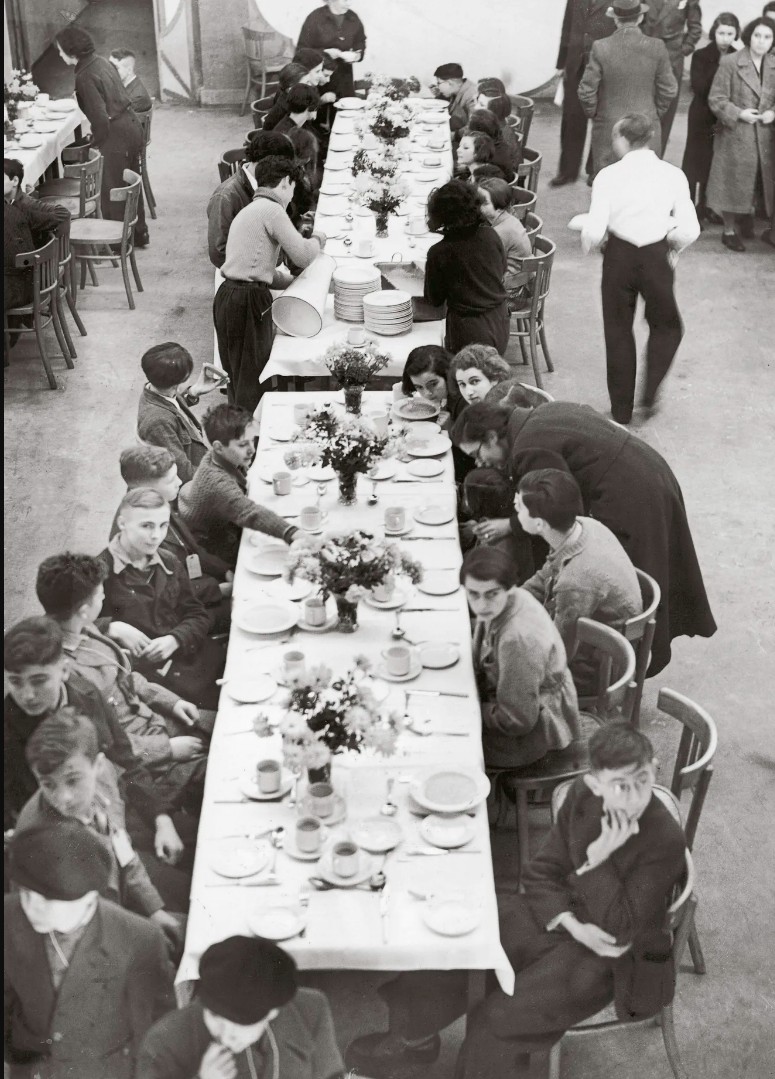 A group dinner for the German Jewish kids who were saved by the British people a month after Kristallnacht. It is their departure and rescue which triggered Ben-Gurion's antisemitic hate speech
A group dinner for the German Jewish kids who were saved by the British people a month after Kristallnacht. It is their departure and rescue which triggered Ben-Gurion's antisemitic hate speechThus philanthropy, administered by the Zionist movement, became highly profitable. However, the aim of all the Zionist "rescue" operations and agreements with the Nazis was hardly humanitarian, as is evident from the account of the missions of Bar-Gilad and Ginsberg. "These two Jewish emissaries had not come to Nazi Germany to save German Jews; that was not their job Their eyes were fixed entirely on Palestine and the British Mandatory. They were looking for young men and women who wanted to go to Palestine because they wanted a national home of their own and were prepared to pioneer, struggle and. if necessary. fight for it. Their interest in those German Jews who turned to Palestine as a haven of refuge, as the next best after the United States or the United Kingdom, was secondary to their main purpose...
"Their end was to them far more important than the means which they were now compelled to employ; and though they could not see the future, nor imagine what it would bring, they had no qualms about the price they had to pay so long as they managed to get their Jews to Palestine." (39)
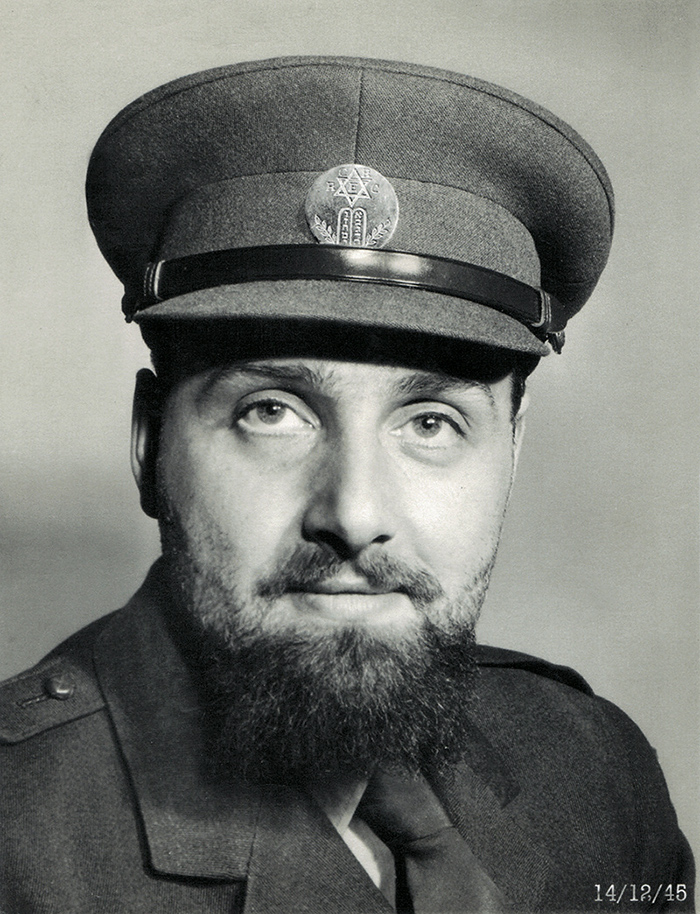 Rabbi Solomon Schonfeld: British Hero of the Holocaust. Was he ever honored by Zionists? Was he thanked?
Rabbi Solomon Schonfeld: British Hero of the Holocaust. Was he ever honored by Zionists? Was he thanked?The signature of the "common interests" agreements between the Nazis and the Zionists, through the efforts of Ginsberg and Bar-Gilad, was followed by implementation. The reluctance of large numbers of German Jews to uproot themselves at the behest of Zionism had to be overcome by persuasion which the Nazis were quite willing to provide.
"The beginning was slow but the grim night of November 9th, 1938, during which the Nazis carried out their organised riot of arson and assault on German Jewry convinced the German Jewish leaders that emigration, by any means at their disposal, remained their only hope. "As this realisation dawned on the Jewish masses. Jews from all over Germany began to stream to Maineckestrasse; applications for emigration flooded the offices of Hechalutz, the Zionist pioneering movement, which was Pino's H.Q." (40)
Once the agreements began to be carried out in earnest, a remarkable spirit of co-operation, even camaraderie, grew up between Zionists and Nazis. This was to No. 10 Maineckestrasse was the address of the Zionist Organisation's Berlin headquarters contrasted strangely with the Nazi attitude to those Jews -- the great majority in fact -- who were unwilling or unable to comply with the Zionist and Nazi demand that they leave their homes in Europe.
"In March 1939, the first transport of 280 German Jews organised by Pino, whose destination was ostensibly Zionist training farms in Yugoslavia, left Berlin. The Nazi authorities provided a special train and Nazi officials accompanied the train as far as Vienna, where the group joined another and larger transport of Austrian Jews which was accompanied by Austrian Nazis.
"The Austrian part of the transport had been organised by Bar-Gilad, working in Vienna...
"The train with the hundreds of singing pioneers, with the bored Nazi guards leaning out of the windows, must have been an incongruous sight as it rattled through the lazy countryside of southern Austria. The sailing went according to plan; several hundred young Jews landed secretly on the shores of Palestine." (41)
Playing astutely on their feelings of insecurity, the Zionist movement persuaded German Jews to donate considerable sums for the rapid expansion of the training camps and transportation facilities so that the trickle of emigrants could become a flood. The Zionist-Nazi agreements on emigration continued in this form for two years following the outbreak of the Second World War. How- ever, their smooth operation was disturbed in 1941 after Germany attacked the Soviet Union. The Nazis argued that the agreements were no longer able to operate owing to their need to give priority to their military situation on the Eastern Front when allocating transport, and to the general disruption by the war of communications in central and Eastern Europe.
Finding it no longer feasible to rid Europe of Jews through emigration, Hitler opted for another way. "In January 1938, he had already given orders that Jewish emigration was to be directed primarily to Palestine, and when that gate was also closed he embraced the simple way out that was now offered to him, the 'Final Solution' of the extermination camp." (42)
This new situation confronted Zionism with a critical choice between two courses of action. The first was to declare war on Nazism, renounce the 1938 agreements totally and raise the banner of Jewish revolt against Nazism throughout Europe. This, of course, would have meant abandoning once and for all any possibility of securing even the most limited "legal" emigration of Zionist manpower from Europe through co-operation with the Nazis in future, should the logistical situation later change to allow for that. The choice of resistance would also mean that the Zionists would have to throw themselves into the struggle against oppression and anti-Semitism in Europe, side by side with Gentiles and assimilationist or progressive Jews. For Zionists, this would have implied not only a serious compromising of their most profoundly-held beliefs but also, perhaps even more serious, an admission of defeat for their whole philosophy.
The second course of action open to the Zionists was to accept that the situation had changed, at least temporarily, in a direction unfavourable to them, and to attempt to salvage as much as they could by reaching new, but more limited, arrangements. This would, of course, mean acquiescing in the deaths of large numbers of their co-religionists. It would, however, have the advantage of keeping the door of communication with Nazi Germany open, to be used if the situation changed back to a more favourable one in future. Furthermore, it would involve no fundamental watering-down or defeat of the Zionist ideology.
The Zionist movement was led inevitably to this agonizing choice by its signature of those early agreements with Nazi Germany. Some apologists have argued that in this the Zionists were not acting from really sinister motives, and were unaware of the cruel end to which it could lead. Apart from the moral danger of blindly maintaining that the end justifies any means, it is highly doubtful that the Zionist leaders, with their remarkable skill in long-term planning, were unaware of either the true nature or the potential course of Nazi policy. which were obvious to most ordinary Europeans by at least the mid-1930s. In this context, the prosecutor in the Eichmann trial, Gideon Hausner, made some very valid comments. Referring to Hitler, he stated: "When he gave free rein to hatred for the Jews, he had also taken the steep path that plunged down to the 'Day of Boycott' against the Jews on 1 April 1933, to the Kristallnacht of 9-10 November 1938; to the 'physical extermination' decision of 31 July 1941. This was the logic of events, each of which evolved from the one before, and led inexorably to its successor. The way of anti-Semitism led to Auschwitz." (43)
The logic of the steep path did not apply only to the Nazis. By accepting the fatal principle of common interests and consequent cooperation with Nazism, however, limited its scale in the 1930s. the Zionists set themselves on their own parallel steep path downwards. the two phenomena of anti-Semitism and the Zionists' alliance of convenience with it. in the hope of using it as the "propelling force" they needed, cannot be separated completely. They reacted mutually on each other, as inevitably happens with any two political forces whose relationship is one of close contact, whether in confrontation or co-operation.
In any case, whatever excuses could be advanced for Zionism's agreements with Nazism in the 1930s, these cannot be valid for any continued cooperation after the Nazis had launched the full-scale implementation of genocide in mid-1941. During the period 1941-44, a number of individual Zionists in Nazi-occupied Eastern Europe, such as Mordechai Anielewicz, broke with Zionism's traditional policy and participated in revolts against Nazism. But these revolts were all organised locally, by Jews in Warsaw, Vilno, Bialystok and other areas, often in coordination with each other within occupied territories, but without the cooperation of the Zionist movement on the international level.
The Ghetto Revolts
History records no proclamation of revolt by the Zionist movement against Nazism in Europe. It is relevant to ask why. As a Jewish writer has asked, "Why was there no Jewish self-defense organised and in readiness? There were also scores upon scores of thousands of Jewish soldiers in the army Of the Polish Republic. Why was there no guiding hand to instruct some of them at least to bring their weapons home, to store them away... so that later, when the Jewish fighting organisations did arise, they should have at least some equipment with which to face the Nazis?"(44)
It should be noted that Poland's Jews accounted for about half the 6 million Jews estimated to have been butchered by Nazism. Despite the lack of any preparation of this type, the Jews of Europe distinguished themselves by many gallant acts of resistance against their oppressors, that have been well documented by Jewish historians like Reuben Ainsztein, who wrote a massive and thorough work on the subject. Large numbers of Jews joined partisan movements, particularly in Nazi-occupied areas of the Soviet Union, and also staged remarkable uprisings in ghettos and even in concentration camps. But in his painstaking 849-page study. Ainsztein does not quote a single instance of military assistance to these revolts by the Zionist movement's highly organised worldwide apparatus outside Nazi-occupied Europe. In fact, he repeatedly pointed out that the only allies the ghetto fighters had outside their ghetto walls were local groups of leftists or other anti-Nazis, such as the People's Guard (later People's Army) Of the Communist Polish Workers' Party. (45)
This is all the more remarkable since Ainsztein is himself pro-Zionist and his book is liberally filled with both anti-Soviet comments and glorification of those Zionist individuals and small groups that were overwhelmed by the holocaust after 1941 and often had little choice but to resist. After the collapse of the Zionist migration accords at that time, a number of Zionist groups, notably in Poland, found themselves unable to communicate with the Zionist leadership outside Nazi-held territory. As the leader of one of these groups, in a letter urging the right-wing Polish Home Army to supply the Warsaw ghetto with arms, wrote: "How we regret that we have no possibilities of direct contact with the governments of the Allied States, with the Polish Government and Jewish organisations abroad." (46)
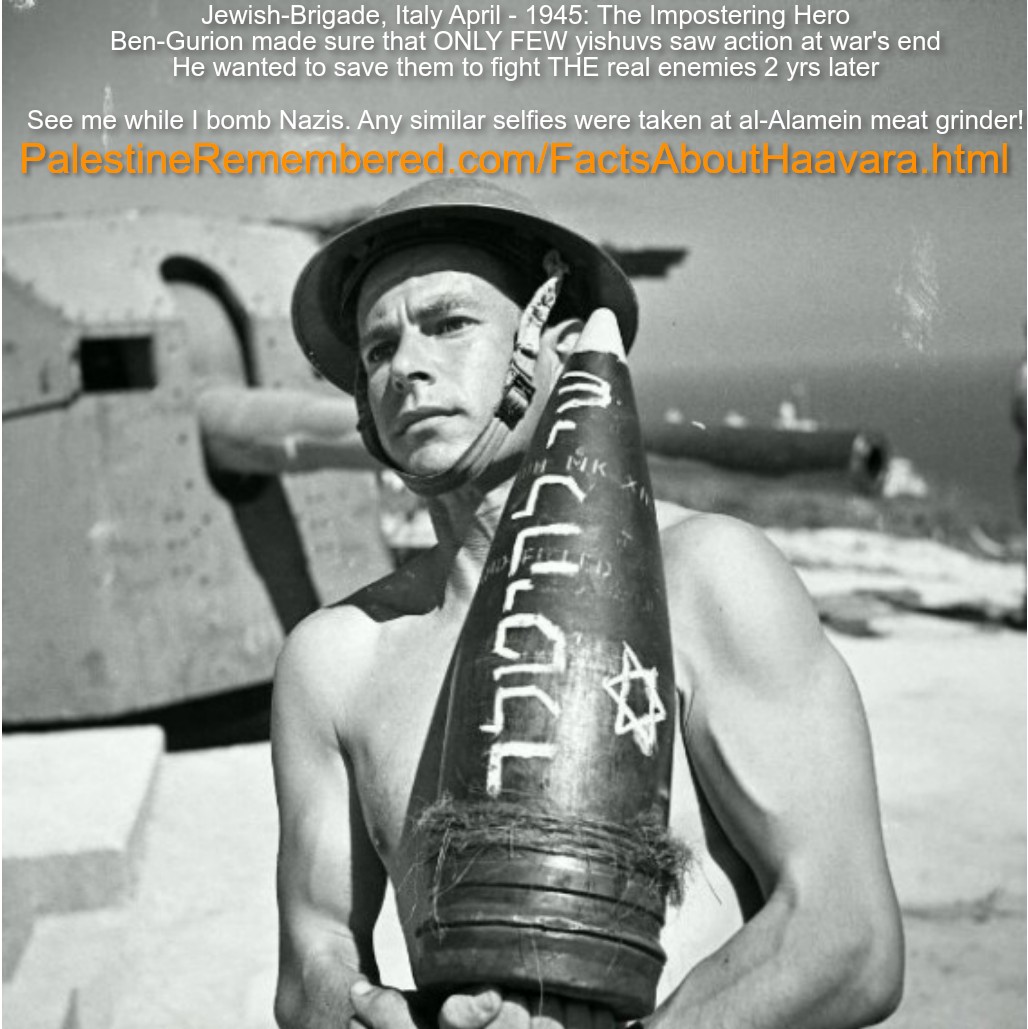 Fake Valor: Jewish-Brigade, Italy April - 1945: The Impostering Hero, see me while I bomb Nazis ONLY a few weeks before WWII ended. We wonder: were any similar selfies taken at the al-Alamein meat grinder?
Fake Valor: Jewish-Brigade, Italy April - 1945: The Impostering Hero, see me while I bomb Nazis ONLY a few weeks before WWII ended. We wonder: were any similar selfies taken at the al-Alamein meat grinder?The ghetto revolts constitute a remarkable, even unique form of resistance by the Jews in areas of Eastern Europe. They arose when the inhabitants of the ghettos realised that the Nazi aim was their extermination. Some ghettos learned this earlier than others. "That the aim of the Germans was the total annihilation of all the Jews they could get hold of became obvious to the mass of Warsaw Jews only in the summer of 1942 when in three months 300,000 were dispatched to the gas chambers of Treblinka and other places of slaughter. Even in Bialystok, despite the massacres that followed the capture of the city by the Wehrmacht, it was possible for a Jew to delude himself that a remnant of the ghetto's Jews might be allowed by the Germans to survive. Butin Vilno the truth about the nature of the Nazis' Jew-hatred became obvious to those who had the moral and physical courage to face it even before the end of 1941." (47)
The fact that Nazi extermination plans became widely known to Jews in Europe shortly after their implementation began is also confirmed by Joseph Tenenbaum, who pointed out that the Nazis were not able for long to conceal the news of their death camps. "The news of the Treblinka murder camp came like a thunderclap. Some had heard of it before; they whispered about it. There was news from Chelmno of the mass extermination of Jews in gas-filled vans. There was terrible news brought by refugees from Wilno of the massacres of Jews in Slonim, Baranowicze, and other places. But who could believe such atrocities to be possible? Soon, however, there came incontrovertible proof.
In July 1942, 'Zygmunt' (Frydrych) was delegated to verify the story of Treblinka. He reached Malkynia. There he met Esriel Wallach, an escaped prisoner from Treblinka, who confirmed the worst rumors. Frydrych brought back the sad tidings to Warsaw, whence it spread throughout occupied Poland. The underground Jewish organisation closed ranks. They disseminated the Treblinka news and brought this information to the attention of all." (48)
 Zionists were the only non-Nazi parties allowed to operate in Nazi Germany! Pay attention to Betar's SS look like uniforms!
Zionists were the only non-Nazi parties allowed to operate in Nazi Germany! Pay attention to Betar's SS look like uniforms!"As early as December 1941, Edek Boraks, Israel Kempner, and Pinczewski were sent to Warsaw with the news of Ponary. Another team, Chayka Grossman and Tamara Schneiderman, carried authentic information about the developments in Wilno. Bela Chazan under the assumed name and passport of Bronia Limanowski made personal contact with Grodno. There were no ghetto walls for these winged messengers. A Wilno 'courier' constantly on the move was Lea (Leonia) Kazibrodska. She was apprehended and executed in April 1942. Frumka Plotnicka, who carried money appropriated by the Joint Distribution director in Warsaw for the use of the youth organisations in Wilno, also brought the news of Treblinka. She later traveled to Kowel where she organised an underground movement and established connections with Bialystok. Among the non-Jewish couriers who served the cause with distinction were Irena Adamowicz and Jadzia Dudziec. (49)
Historians generally agree that Vilno (also known as Wilno or Vilna) was the city where the Jews first became aware Of German extermination plans after large numbers had been executed at the nearby site of Ponary, and also where the first attempt to organise a Jewish resistance movement began. In its first appeal, this movement declared: "Let us not go like sheep to the slaughter! It is true that we are weak and we have nobody to help us. But our only dignified answer to the enemy must be resistance." 50 Vilno Jews carried out sabotage actions against the Nazis, but their hopes for a mass uprising did not materialise.

How does justifying Haavara after the fact doesn't resemble Rudolf Kastner's defense for what happened on his famous train but at a much larger scale? Kastner train passengers on their way to Switzerland, 1944
A major factor in this failure was the role of Jacob Gens, a leading Zionist collaborator with the Nazis, who eventually made him chief of a Jewish police force in Vilno. "He stands all by himself because no other ghetto leader went so far in serving the Nazis as Gens: no other ghetto leader used his police force to carry out the actual killing of Jews. Nor did any other ghetto leader play such an effective part in sabotaging Jewish participation in the partisan movement... He combined Lithuanian nationalism with the fascist brand of Zionism represented by Jabotinsky's followers by being a member of the Revisionist Brith Hakhayil (Military Organisation)... "As soon as the surviving Vilno Jews were crammed into two ghettos on 6 and 7 September 1941, Gens became the deputy commander of the ghetto police whose commander, Muszkat, was a lawyer from Warsaw and also a Revisionist. His programme and philosophy were no different from those of Barasz, Rumkowski, Merin or other collaborationist ghetto leaders: he too argued that a remnant of Jews might survive if they made themselves economically useful to the German war machine. However, it was not his success in building workshops in the ghetto that endeared him to the Gestapo, but his ruthlessness in delivering Jewish victims and his usefulness in preventing the flight of young Jews into the forests to join the partisans...
"Having embraced both as a Jew and as a Lithuanian ideology that extolled the virtues of leadership, he found it possible to believe that he had a mission to fulfill and that he knew what was good for his Jewish subjects. Since work alone was not enough to ensure the survival of his Jews, he was ready to assume the responsibility for selecting the victims who had to feed the Nazi Moloch. And he did this sufficiently that by the autumn of 1942, the Gestapo made him the dictator not only of the Vilno ghetto but also of all the surviving rural ghettos in the Vilno region." In October 1942, the Nazis told Gens they wanted 1,500 Jews killed in Oshmyany ghetto. Later they "agreed to reduce the number Of victims to 400 provided they were selected and killed by Gens's policemen." Gens agreed and sent his Chief of Police Salek Desler (also a Revisionist) with 30 policemen. ney selected over 410 sick and old people whom they killed themselves. Gens defended his action by claiming "it is our duty to save the strong and the young and not to let ourselves be overcome by sentiments." (51)
 Pre-Nakba picture of a Palestinian Christian girl from Bethlehem who "didn't exist"; Zionists say!
Pre-Nakba picture of a Palestinian Christian girl from Bethlehem who "didn't exist"; Zionists say!"On April 5, 1943, an announcement appeared on the walls of the ghetto, urging Jews who had relatives in Kovno to join the transports from the neighbouring villages, principally from Snipiszok, allegedly bound for Kovno. The announcement was couched in alluring language, depicting better living conditions and easier housing accommodations than were available in the crowded Wilno ghetto. Gens put himself out for the Kovno scheme, and many unsuspecting victims volunteered to join the Kovno caravan. All in all, some 5,000 Jews mounted the trains... It soon became evident that instead of proceeding to Kovno the trains were unloaded at Pona and the victims were mowed down with machine guns. Some of the victims, however, were able to fire." (52) escape and tell their tale.
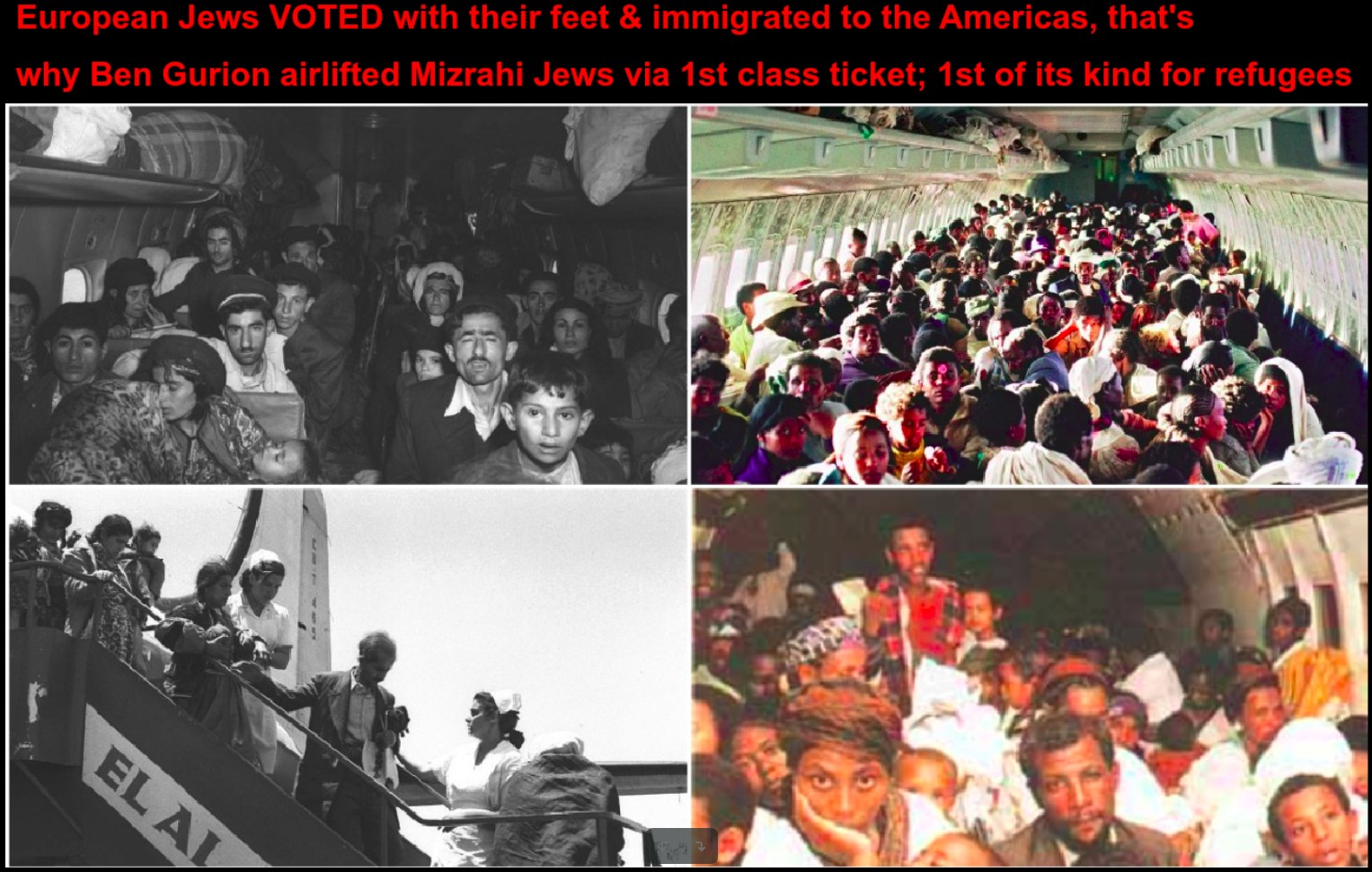
Ben-Gurion’s nightmare was to build the Jewish state, and European Jews won’t immigrate. That’s exactly what happened after Nakba. That is why he airlifted Arabs Jews directly from their countries.
"On April 5, 1943, an announcement appeared on the walls of the ghetto, urging Jews who had relatives in Gens played a particularly treacherous role in betraying the leader of the Vilno ghetto resistance, Itzik Witenberg, who was a Communist and thus a particular target for the hatred of the right-wing Revisionists. "One night Witenberg was arrested by a ruse of the Jewish police, but was rescued by his alerted comrades and returned to the headquarters unharmed... Unfortunately, the volatile Gens and his ruthless police commissioner, Sala Desler, out-witted everybody, including themselves. They promptly sent out their police hounds, aided by the scum of the ghetto, to round up the crowd for an urgent meeting. The people thronged obediently. Before a vast assembly, Gens displayed his uncanny sense of appealing to the fear instinct of a trembling multitude. He harangued the crowd with warnings not to let one man's personal safety jeopardise the safety of all, and he relayed the alleged plans of the Gestapo to wipe out the ghetto at one blow with bombs, tanks, artillery, and all the fires oi hell, unless the ultimatum of surrendering Witenberg was met. "Under this blackmail, "at the appointed hour Witenberg surrendered to the bloody Desler, who handed turn over to the Gestapo... The backbone of the movement was broken. A pall of terror hung over everything. It was no use denying that the Gestapo had won a decisive victory without a fight." (53)
After Witenberg's death, the Zionists managed to ensure that one of their number, Abba Kovner. succeeded the representative of the 'Hashomer him. "Kovner, Hatzair', succeeded in appointing himself as commander of the underground fighting forces in Vilno, (Vilno, Wilno, and Vilna are variant spellings of the same place name) which hoarded ammunition and recruited strong, trained individuals, prepared for battle. But it never used its resources against the Germans in the ghetto and, consequently, Kovner arrived at an agreement with the head Of the ghetto (Gens) and the leader of the Jewish police (Desler), according to which they were obligated, in exchange for the holding back of action by the underground, not to harm any of its members ? and also to promise them exit from the ghetto on the verge of its final destruction. These three--Gens, Desler, and Kovner--held a common view, which was also the approach of Dr. Weizmann and Nathan Schwalb, Jewish Agency representative in Switzerland: to sacrifice the aged and the multitude, and to save the 'elite' group of youth 'our friends'...
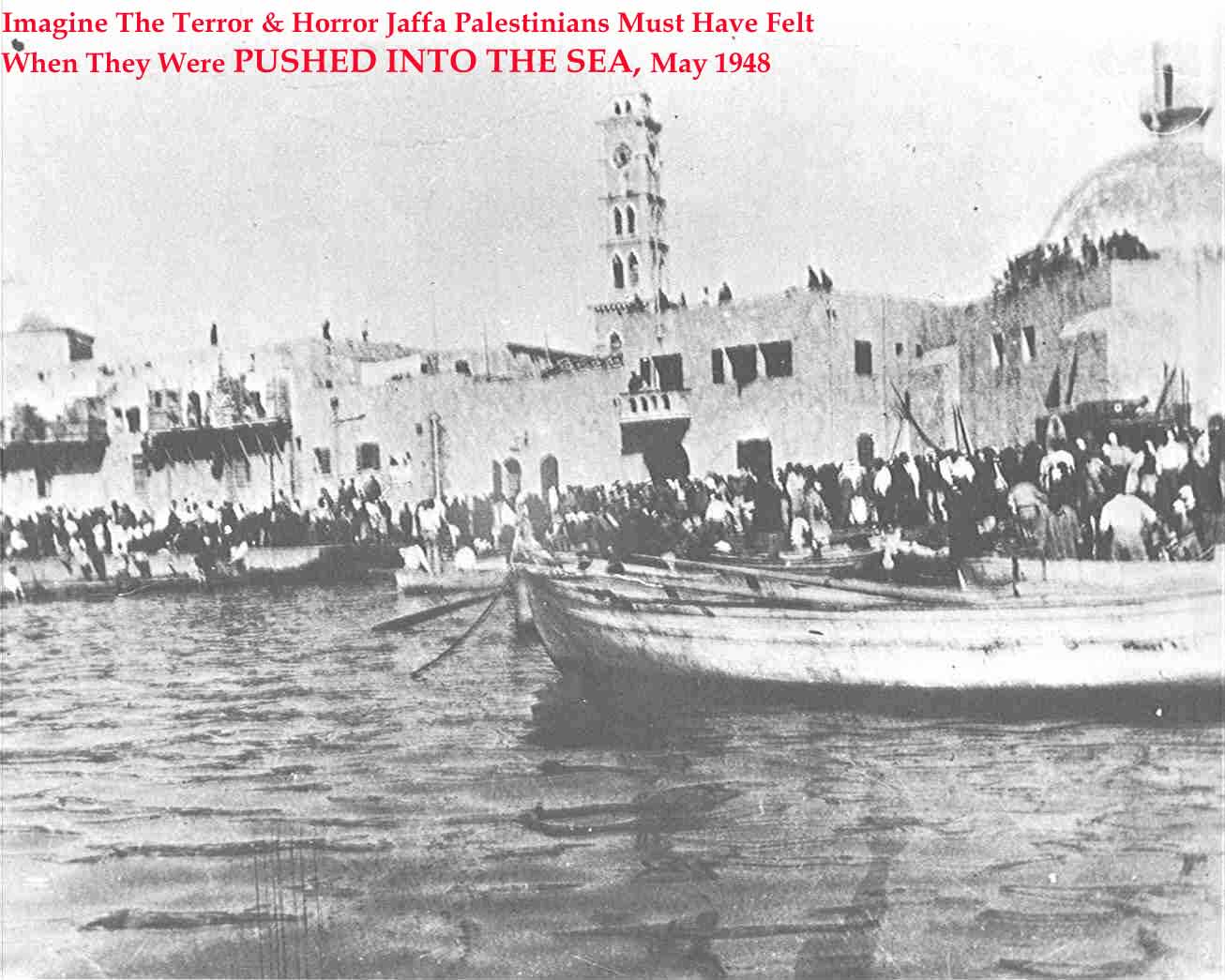 Remind us who shall push who into the sea? Jaffa May 1948, Palestinians were being pushed into the sea by Zionist Jewish forces
Remind us who shall push who into the sea? Jaffa May 1948, Palestinians were being pushed into the sea by Zionist Jewish forces"When representatives of the partisans arrived in Vilna, with news of the final solution and advice to the Jews of Vilna to save themselves in the forests and join the partisan camps, what did Kovner do?
"The representatives of the partisans Kovner kept isolated so that they should not come in contact with the crowds in the ghetto and they shouldn't organise groups of plain Jews for escape into the forests.
"However, escape into the forest does not remain a secret to the residents. Every time a group leaves, hordes run after them and want to join them. But, according to Kovner's orders, a thorough search is carried out at the time of the departure and the Jews are chased away from the gate. Only infrequently does one of them succeed in mingling with the fighters and get out with them. It is interesting thing that just these 'illegals' are later to become the best fighters in the forests. "The Jews begin to gossip about the head of the organisation, Kovner: how is he better than the commander of the police? One decides who will die, and the other chooses who is allowed to live. They permitted hundreds of Jews to be slaughtered who certainly would have succeeded in making an important contribution in the fight against the enemy, and it is Jews whc lock the gates of rescue before them. "The fate of the Vilna ghetto was sealed. The day before the final annihilation arrived, Kovner betrays the constitution of his underground organisation. The 22nd paragraph of the constitution states, 'We will go to the forest only as a result of battle, after we have accomplished our goal. We will take with us the largest number of Jews possible and we will clear a path to the forest, from whence we will continue our battle against the murderous conquerors.'
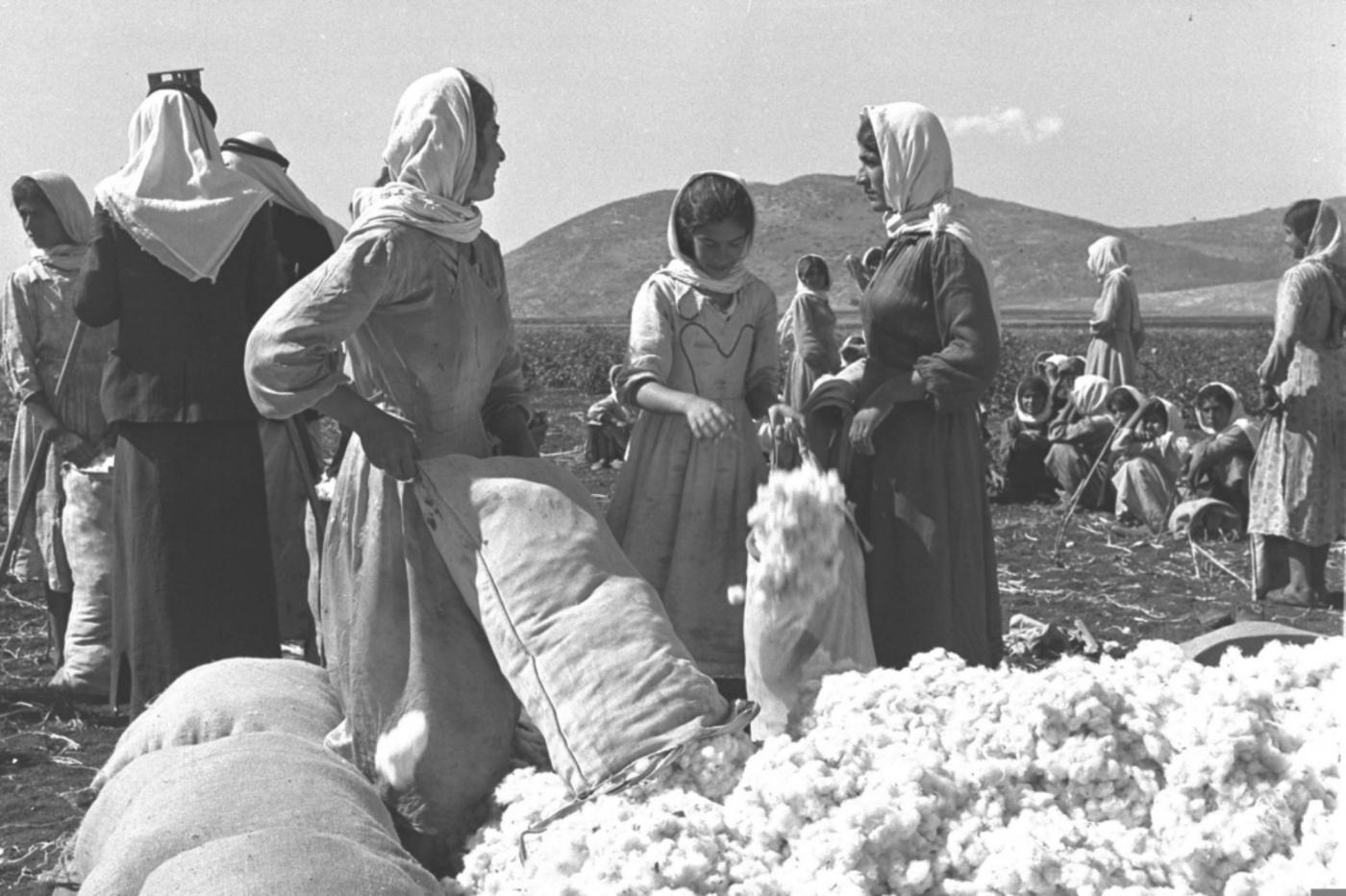 Palestinian women harvesting cotton in the village of Kafr Saba in 1937
Palestinian women harvesting cotton in the village of Kafr Saba in 1937"In reality, Kovner promises exit to 50 of his friends from the organisation exclusively. In spite of all the precautions, it became known in the ghetto that the fighters are gathering to leave. Tens of young, healthy, strong people gather in the courtyard and plead before Kovner that he permit them to join those leaving, but Kovner hardens his heart, threatens them with his revolver, and chases them away. The opening of the sewer is guarded carefully by Kovner's own men so that no 'illegals' should sneak through.
"ln the forests, too, as commander of the partisans, Kovner continues to prevent rescue and ships to death any Jew who wasn't counted among his friends -- the members of the 'Hashomer Hatzair'. (54)
The first mass uprising is believed to have been in Lachwa ghetto in Byelorussia, on 4 August 1942. A remarkable feature of this revolt was that it was carried out without any firearms. "The SS men entered the ghetto and ordered everyone to line up. Instead, the Jews ran to their houses and set them on fire...
"Yitzchok Rochtchin attacked the SS chief with an axe. The SS officer fell to the ground, covered with blood. Having no way of escape Rochtchin jumped into the nearby river. He was struck down by a bullet. At the same time, another SS man was felled at the gate by Chaim Cheiffetz and the brothers Asher and Moshe-Leib Cheiffetz. Still, another German fell at the hands of Moshe Klopnitzki.
"Now the crowd was aroused and stormed the ghetto gate. Those who were able to run did, leaving behind a flaming ghetto. They were pursued and shot at. Many fell. The town was littered with corpses. People ran with their last ounce Of strength to the forests near the river Pripet, hoping to find shelter there. Of the 2,000 Jews, about 600 managed to reach their destination. But the police and the Byelorussians of that region, who pursued them, murdered most of them brutally...
"The Germans only succeeded in leading a few of them to the grave, because both young and old tried to escape. They would rather die from a bullet while running than be led to their deaths.
"Several days later 120 Lachwa Jews gathered in the Chobot forest, about 20 kilometers from town, and joined the partisans, fighting side by side with them, and later with the Red Army, thus taking revenge for their beloved ones.
A key role in the extermination programme was played by the Judenrats, or Jewish Councils, which the Nazis appointed to run each ghetto.
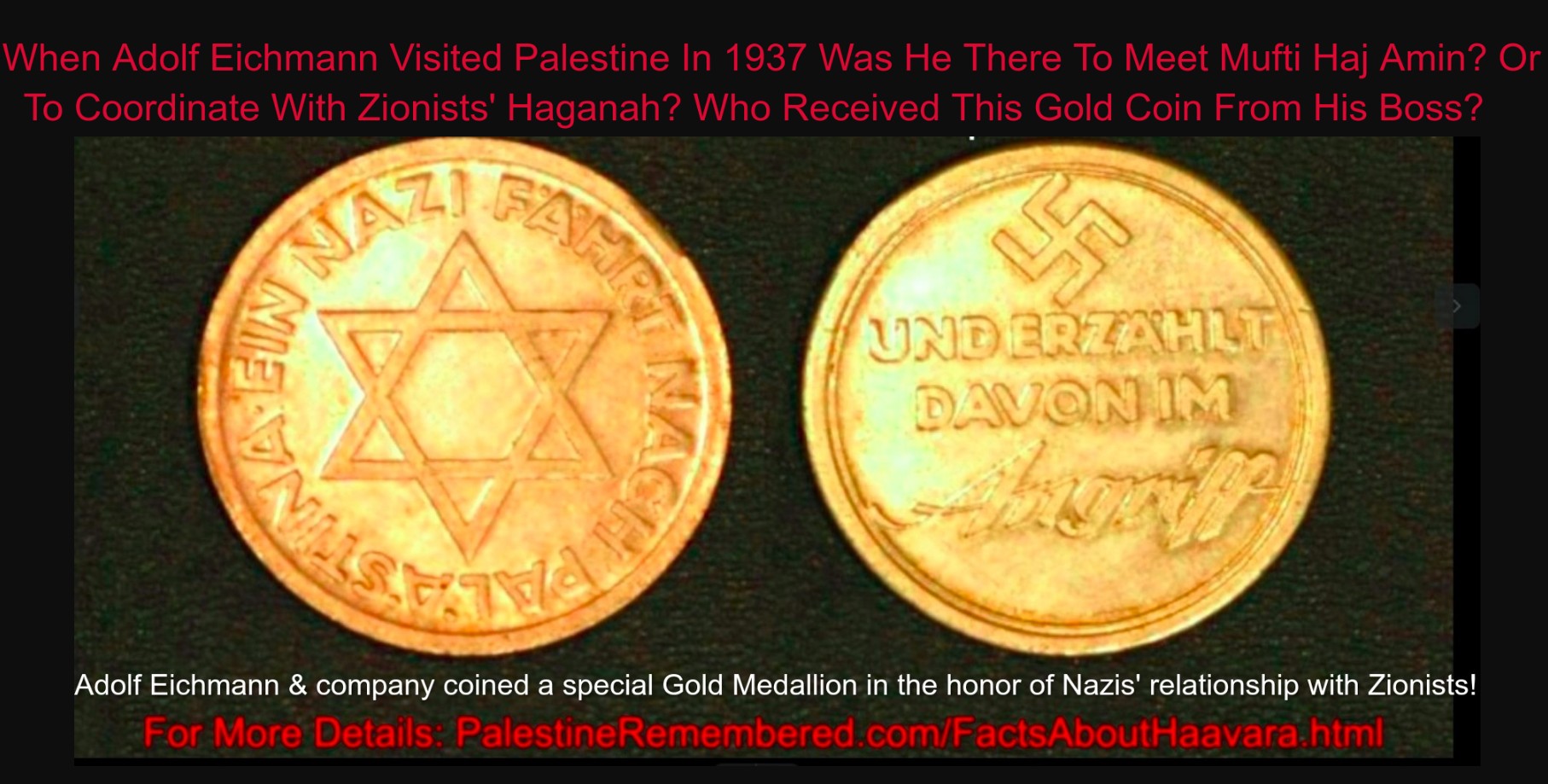 Adolf Eichmann & company coined a special Gold Medallion in the honor of Nazis' relationship with Zionists! Do you've any ideas why he visited Palestine in 1937?
Adolf Eichmann & company coined a special Gold Medallion in the honor of Nazis' relationship with Zionists! Do you've any ideas why he visited Palestine in 1937?Thus, "the first thing the Nazis did in Upper East Silesia, too. was to establish a 'council of elders' (Judenrat) and, as in every place, they appointed Zionist activists to head the council. The Nazis found in these 'elders' what they hoped for: loyal and obedient servants who, because of their lust for money and power, led the masses of Jews to their destruction.
"Monik (Moses) Merin, one of the Zionist activists in the community of Sosnowiec, was propped up by the Nazis as 'emperor' of all the 'councils of elders', and he appointed the leaders of these councils in every community. Of course, he named to these shameful positions only his friends in ideology from the Zionist camp. The Satanic plan of the Nazis assured that the personal fate of each Jew -- whether for life or death--be exclusively left up to the decisions of the 'councils of elders'. The Nazis, from time to time, decided upon a general quota for the work of the camps and for extermination, but the individual selection was left up to the 'councils of elders', with the enforcement of kidnappings and arrests also placed in the hands of the Jewish police (kapos). By this shrewd method, the Nazis were highly successful in accomplishing mass murder and poisoning the atmosphere of the ghetto through moral degeneration and corruption." A prominent religious Jew in Bedzin, Reb Bunim, "alerted the Jews of the city, revealing to them that they would be burned in the furnaces and that they should save themselves by not appearing for the deportation when called by the council. Reb Bunim knew that Merin would revenge himself cruelly, especially since he refused to participate in the schemings of the previous two years Of the council of elders. Merin's revenge was not long in coming. He betrayed to the Gestapo that Reb Bunim's sons belonged to the underground, and they were soon arrested and sent to Auschwitz. After a short time, Reb Bunim and his wife were also arrested ans sent to Auschwitz" (56)
Attempts to organise resistance in the Bialystok ghetto were not very successful. This was partly owing to a tactical miscalculation by the resistance leadership, which tried both to fight in the ghetto and also to strengthen the rural partisans, but had too few resources to achieve both tasks properly. They were also undermined by the collaboration of the Zionist-led Judenrat with the Nazis. "The policy of the Bialystok Judenrat was all the more con- vincing because its chief champion and executor was Ephraim Barasz, an engineer by profession and a liberal Zionist in his political beliefs." Barasz had previously had the reputation of being an "honest man", which enabled him more effectively to lull the ghetto's inhabitants into a false sense of security.

How does justifying Haavara after the fact doesn't resemble Rudolf Kastner's defense for what happened on his famous train but at a much larger scale? Kastner train passengers on their way to Switzerland, 1944
In February 1943, the Nazis demanded the surrender of 6,300 Bialystock Jews for extermination. "The Judenrat complied by preparing lists of people whose sin was that they were poor or had fled to Bialystok from the annihilated provincial ghettos. The deal was arranged in absolute secrecy, without any warning or hint from Barasz or other Judenrat members to the ghetto population of what was in store for it. "However, the resistance United Anti-Fascist Bloc prevented most people on the lists from reporting for transportation to their deaths, and the ghetto inhabitants fought back when the Nazis came to collect them. On 15 August 1943 the Nazis informed Barasz they intended to liquidate the ghetto. "Barasz returned to the ghetto and did not warn anybody that only a few hours were left to the 40,000-odd Jews" still in there, nor did he encourage them to revolt. The Anti-Fascit Bloc nevertheless managed to arm 300 combatants with firearms and grenades and a further 200 with Molotov cocktails, homemade bombs, knives, and axes. These weapons, many of them smuggled into the ghetto in the most daring ways, were grossly inadequate for a large-scale revolt, but the resistance nevertheless lasted until 26 August and the Nazis had to use artillery and aircraft to subdue it. About 100 Nazis were killed. (57)
Another prominent Zionist who gave the Nazis considerable assistance in their extermination campaign was Chaim Romkowsky, a megalomaniac ghetto leader who even had postage stamps with his portrait on them issued for use by the ghetto inhabitants.
"These names are mentioned as blatant examples, but the infamous list itself is long and spans many cities and villages throughout Poland, Lithuania, Hungary and Rumania." (58)
Despite the help given by the Zionist leadership to Nazi efforts to smash any Jewish resistance, anti-racist Jews used great ingenuity to provide themselves with the means to defend themselves. At one point, guns were smuggled into resisting ghettos in false-bottomed coffins. "Then, for a time, girls brought in guns, slung between their legs as they returned from the factories outside." Later, and particularly in Warsaw, "the sewers were to become the most important single route whereby arms came into the ghetto and people got out." In Dnepropetrovsk ghetto, 150 kilograms of industrial dynamite were smuggled in "hidden in the pestilential carcase of a rotting horse," while in Vilno, "the Sisters Of St. Catherine brought grenades and guns into the ghetto and hid the gunrunners in the convent." But with their slender resources, the weapons the ghetto fighters obtained was "never enough and never the right kind; no heavy machine guns, no mortars, no mines, no antitank weapons, no gelignite pencils or plastic explosives."" Jewish ingenuity even managed to seize or manufacture arms or smuggle weapons and components into the death camps of Treb- linka and Sobibor, where desperate revolts were staged." (59)
Ghetto resistance reached its climax in Warsaw in 1943. There "the Jewish resistance movement received the support not only of the militarily weak Communists, but of three small but influential Polish resistance organisations and a number of noble individuals, who played a crucial part in making the Home Army Command provide the Jewish Fighting Organisation with some arms." The People's Guard sent in some pistols, although "how limited their resources were can be judged from the report of the Command of the Warsaw Area People's Guard of 27 December 1942, which put the amount of arms in its possession at thirteen pistols and seventeen grenades, and that of I January 1943, which gave the figures as 24 pistols and eighteen grenades." (60)
When the operation known as the great liquidation (in which some 300,000 Jews were exterminated) began in Warsaw on 22 July, the Jewish resistance groups had few arms and so could not put up a fight. However, the great liquidation made the ghetto arm itself as far as possible, and also build up a superb Intelligence system. "The Polish and Jewish intelligence sources outside the ghetto were able to discover what was being prepared by the Germans because not only the special extermination force but the entire Gennan garrison in Warsaw had been alerted to deal with a possible general uprising."(61)
"On Sunday, April 18, 1943, the chiefs of police and the SS leaders held a conference at which the plan for the ghetto attack was worked out in detail. It was to take place the following day at dawn. At 2 p.m. that day the SS and the German police received their mobilisation orders. A similar order was received by the Polish police, who threw a heavy cordon around the entire ghetto at about 6 p.m. One hour later the chiefs of staff of the Jewish Fighting Organisation and of the Jewish Military Association were informed of the enemy's preparations. " (62)
The ghetto fighters launched their revolt on the follow- ing day. According to Ainsztein, the composition of the ghetto fighters was as follows: the Revisionists' Jewish Military Union had some 400 combatants, the Jewish Fighting Organisation (a coalition of Communists, Bundist Social Democrats and Zionists, of whom Hashomer Hatzair played the most notable part) had between 600 and 800, while the majority, some 2,000, were not attached to any political organisation and were known as "wild groups". The latter in fact lasted longer than the politically organised groups." (63)
Fighting from street to street, from house to house, from underground bunkers, ruins and even sewers, the Warsaw ghetto resisters held the Nazis at bay or pinned down for months in what was described as the largest and longest single act of resistance in occupied Europe, apart from Yugoslavia. It caused hundreds of Nazi casualties, although the German Army shelled the ghetto with artillery and the Luftwaffe was brought in for air strikes against it. The Nazis tried to destroy even the ruins which were providing cover for urban guerrillas in July. and in September 1943 they sent large forces in to clear out the remains of the ghetto. Nevertheless, the last recorded act of resistance by a Warsaw ghetto group, the killing of three German gendarmes, was as late as June 1944.(64)
In addition to the Nazis, the ghetto resisters had to combat a highly dangerous traitor Abraham Gancwajch, who had been the leader of Hashomer Hatzair (a "left-wing" Zionist group, now known as Mapam) in Czestochowa. In Warsaw in the spring of 1940, "he made a speech in which he said that the Nazi New Order had come to stay and that the Jews had to adjust themselves to it... With the assistance of the Gestapo, he collected a staff of collaborators recruited from members of his own family, friends, and acquaintances." The Nazis allowed him to set up his own 300-man "police force" which "per- formed the functions of an American gangster's hoodlums and with their help Gancwajch forced all the important businessmen in the ghetto, irrespective of whether they were honest or dishonest, to pay him protection money, which he shared with his Gestapo patrons... The most important factor was the usefulness of Gancwajch and his Mafia as an agency of espionage and subversion in brief, as a classical fifth column... Two rabbis belonging to the Agudath Israel Party, Blumenfeld, and Glicensztajn, made propaganda on his behalf among the Hassidic elements and saw to it that no resistance ideas should take root in the religious schools and colleges." Gancwajch set up an "ambulance service" which helped round up victims for the Nazis, and also every Tuesday handed in an intelligence report which he "boasted that the Gestapo awaited with impatience because they regarded it as the only reliable assessment of what was happening in the ghetto." The Agudath Israel Party, now one of Israel's respected political parties, helped the Nazis to suppress resistance "by telling (its) numerous followers that the ghetto was not only the Lord's punishment for Jewish desertion Of orthodoxy and atheism but a blessing in disguise designed to bring the Jews back to the state of piety."(65) That the ghetto fighters were able to organise resistance despite these collaborators was a remarkable achievement.
Shortly before his death in battle in the ghetto, the leader Mordechai Jewish Fighting Organisation's Anielewicz wrote to his successor: "Aware that our last day is at hand, we demand from you to remember how we were betrayed. The day of payment for our spilled innocent blood will come. Send help to those who in the last battle may escape the enemy's hands, so that they can carry on the fight."(66) Although he does not specifically name who it was who betrayed the Warsaw ghetto Jews, it is interesting to note that Anielewicz was a rare exception that proves the rule, in that he was a Zionist, ironically from the same Hashomer Hatzair organisation to which Gancwajch belonged.
Relevant links
VI: Zionist Policy on the Holocaust

How does justifying Haavara after the fact doesn't resemble Rudolf Kastner's defense for what happened on his famous train but at a much larger scale? Kastner train passengers on their way to Switzerland, 1944
The accounts by Jewish historians of the ordeal of East European Jews under Nazi occupation contain a two-sided story of the heroism of resistance and the shame of collaboration. What precisely was the role of the Zionist movement, as a movement, in all this? Were the numerous Zionist leaders who collaborated with Nazism in various ways acting as individuals, or as officials implementing Zionist policy? In other words, which was more typical of the Zionist movement, Anielewicz or Gens?
When the German Army's thrust into the Soviet Union brought the bulk of East European Jewry an iron circle of Nazi control, the reaction of individual Zionists caught in this trap varied. Some realised that Nazi Germany was determined to make Europe "Judenrein" and therefore believed that there was a risk of extermination for any Jew who had not escaped or been taken out of Europe by the Zionists under the 1938 agreements. These, who included Anielewicz, joined with non-Zionist Jews to resist. Others, particularly those like Gancwaich and Gens who had been leaders in the Zionist movement, continued to hope that they could save themselves and their chosen followers through deals with the Nazis, at the expense of their fellow Jews.

How does justifying Haavara after the fact doesn't resemble Rudolf Kastner's defense for what happened on his famous train but at a much larger scale? Kastner train passengers on their way to Switzerland, 1944
However, in the higher echelons of the Zionist movement, notably in the Jewish Agency whose leaders sat out the war in safe havens to become the future Israeli Government, there was no such division of opinion. No clarion call for a revolt against Nazism came from these leaders, nor is it recorded that they made any attempt, for instance, to smuggle in arms to the ghetto fighters who so desperately needed.
The Zionist movement did engage in some limited military activity in World War Two, but this was essentially designed to further the aim of Zionist statehood rather than to combat Nazism as such or help the oppressed Jews to resist it. Thus, the Zionists formed a "Jewish Brigade" [only a few of the so-called yishuv so action five weeks before WWII ended] in the British Army, whose real purposes were to give credence to the fiction that the Jews constituted a national entity and to gain military training and expertise for the future Israeli Army.
According to Jewish historian Joseph Tenenbaum, "Eliahu Golomb leader of the Haganah petitioned the British Army to put at the disposal of the Jewish volunteers' planes and ammunition for flight, fight, and rescue, None were forthcoming until the beginning of 1944." It is not clear why the British would have failed to cooperate in such a project if it had been seriously intended to strengthen the allied war effort and if they had had the resources to spare for it, nor why the Zionists did not make such an appeal to the United States, the allied power with the greatest resources where the Zionist movement also possessed the most powerful political influence. Finally, when the war was in its closing stages, the Zionists dropped a total of 31 parachutists in Nazi-occupied countries, but their task was to organise further emigration to Palestine rather than resistance to Nazism. (67) [here is M. Hibbard thesis we found on this subject; very detailed and informative about the 31 to 33 parachutists -- the fig leaf of an effort, p. 27-28, 31, 32, & 33]
 Rabbi Solomon Schonfeld: British Hero of the Holocaust. Was he ever honored by Zionists? Was he thanked?
Rabbi Solomon Schonfeld: British Hero of the Holocaust. Was he ever honored by Zionists? Was he thanked?The charge that the British Government neglected supposed Zionist pleas to help the Jewish victims of Nazism was refuted by Rabbi Dr. Solomon Schonfeld, who served as Chairman of a rescue committee set up by Britain's Chief Rabbi. According to Rabbi Schonfeld, "my experience in 1942-43 was wholly in favor of British readiness to help, openly, constructively and totally, and that this readiness met with opposition from Zionist leaders who insisted on rescue to Palestine as the only acceptable form of help." Rabbi Schonfeld recalled that 277 British Members of Parliament signed a motion calling on the Government to provide asylum in British-controlled territories for victims of Nazi persecution, and "HM Government did, in fact, issue some hundreds of Mauritius and other immigration permits indeed, in favour of any threatened Jewish family whom we could name." Then, "at the Parliamentary meeting held on January 27, 1943, when the next steps were being energetically pursued by over 100 MPs and Lords, a spokesman for the Zionists announced that the Jews would oppose the motion on the grounds Of its omitting to refer to Palestine. Some voices were raised in support of the Zionist view, there was considerable debate, and thereafter the motion was dead. Even the promoters exclaimed in desperation: It the Jews cannot agree among themselves, how can we help?" (68)
In July 1944, the Slovakian Jewish leader Rabbi Dov Michael Weissmandel, in a letter to Zionist officials in charge of "rescue" organisations, recommended a series of measures to save the lives of thousands of Jews threatened with liquidation at Auschwitz. His proposals were
"1) With the aid of an exact mapping of the railways, to bomb the tracks on which Hungarian Jews were being transported to the crematoria;
"2) To bomb the furnaces of Auschwitz;
"3) To parachute ammunition to the 80,000 prisoners of Auschwitz;
"4) To parachute saboteurs who would blow up all the means of annihilation, and thus cause a break in the process of cremating 13,000 Jews every day;
"5) In the event of the refusal of the Allies, to obtain airplanes and to recruit Jewish volunteers who would carry out the sabotage.
"To his letter, he added his heart-piercing questions. 'Why was this not done until now? Why is it not done now? Who is guilty of this frightful negligence? Are you not guilty, our Jewish brothers: you who have the greatest good fortune in the world-liberty? " It is doubtful, indeed, whether the Zionists ever did make any serious appeal to the allies to help the persecuted Jews under Nazi occupation. "During the Kastner trial, time and again the question was brought up why the leaders of the Jewish Agency did not turn with this demand (to bomb the Auschwitz extermination facilities) to the Allies. No answer could be obtained from them. Ben-Gurion and Sharett even evaded appearing before the court to explain the lack of any significant action. Only after four years, in the case against Eichmann, did the Jewish Agency, in anticipation of further embarrassing difficulties, bring documents before the court on its own initiative, testifying that pleas were brought to the British Government on the subject of bombing Auschwitz. What a wonder! So many years nothing was known of these documents and suddenly they were discovered in the archives of the Jewish Agency! But now, also, Ben-Gurion and Sharett refrained from giving oral explanations to the court, and the public prosecutor twisted and turned, with amazing virtuosity, so as not to need them." (69) [See The Holocaust Victims Accused for Rabbi Weissmandel's detailed account where he provided the blueprints of the death camps]
It is legitimate, though few have dared to do so, to ask why the Zionist movement did nothing to help the heroic ghetto revolts and the desperate attempts to organise resistance even in the extermination camps, and why it did very little to help the Jews of Europe generally, with the exception of organising emigration facilities for its own members. Did the Zionist leadership not know that the East European Jews were being exterminated? According to the well-known Zionist writer Michael Elkins, one victim named Moshe Podhlebnik miraculously escaped death and managed to flee from Chelmno, the first gas chamber extermination centre, and carry word of what was happening to the outside world as early as 18 December 1941. "Early in August 1942 an agent of the World Jewish Congress in Switzerland named Gerhard Riegner brought a report to the American Legation in Berne" based on the evidence of Podhlebnik and others. The Legation reported on 17 August to the State Department that there was a plan for all Jews under Nazi rule to "be at one blow exterminated." (70) So at least by that date, the Zionist movement outside Nazi-held territories knew what was going on.
Did the Zionist movement lack the resources to help the beleaguered Jews? This is hardly credible. Zionism was then the only Jewish movement organised on a world-wide basis, with financial resources and influential contacts in positions of power throughout the Western world. It should not be forgotten that 1942 was the year of the Biltmore Programme, which marked the establishment of decisive Zionist influence over policy in the United States. Surely Zionism was not too weak to help the oppressed European Jews, particularly when we recall that as soon as World War Two ended, "from Haganah, the Jewish underground army in Palestine, a hundred agents filtered into Europe" to transport the surviving Jews to Palestine to swell Zionist manpower. But by then, an estimated six million victims had been slaughtered. The Zionist intelligence organisation Mossad "had thrown a Haganah network over Europe from Constantza on the Black Sea to the tiny Port de Bouc at the tip of France's Mediterranean coast and there was little that a Jew could meaningfully do in all those thousands of miles that escaped their notice." (71) Where had these resources been when the Jews of Europe were being slaughtered in their millions?
Dr. Chaim Weizmann, who later became the first President of the Israeli state, indicated as early as 1937 that he had a good idea of what the fate of Europe's Jews might be, and also declared unambiguously what official Zionist policy would be towards them. "The hopes of Europe's six million Jews are centered on emigration", he stated. ' 'I was asked: 'Can you bring six million Jews to Palestine? ' I replied, From the depths of the tragedy I want to save two million young people... The Old ones will pass. They will bear their fate or they will not. They were dust, economic and moral dust in a cruel world... Only the branch of the young shall survive... They have to accept it." (72)
The Zionists were indeed single-minded. Their one concern was securing their goal of a state in Palestine. One of their leaders, Yitzhak Greenbaum, who was appointed Chairman of a committee that the Zionists set up supposedly for the rescue of European Jewry, stated that nothing, not even the rescue of European Jewry, should be allowed to obscure that goal. In his words, "when they come to us with two plans the rescue of the masses of Jews in Europe or the redemption of the land I vote, without a second thought, for the redemption of the land. The more said about the slaughter of our people, the greater the minimisation of our efforts to strengthen and promote the Hebraisation of the land. If there would be a possibility today of buying packages of food (for starving Jews under Nazi rule) with the money of the Keren Hayesod (United Jewish Appeal) to send it through Lisbon would we do such a thing? NO! And once again no!" (73) It is strange that few people asked whether a man who voiced such sentiments was the right man to head a body whose theoretical function was rescue work.
Interestingly enough, Yitzhak Greenbaum's son Eliezer was a notortous collaborator with the Nazis in Auschwitz. The Jewish author K. Tzetnik, in his book "Call Him Feifel", referred to "Eliezer Greenbaum (whom he called Fruchtenbaum in the book) who, thanks to his tactics of acting as an informant and displaying cruelty -- to an extent which amazed even the Germans -- was elevated to the rank of the bloc commander." (74)
VII. Kastner and the Hungarian Jews

How does justifying Haavara after the fact doesn't resemble Rudolf Kastner's defense for what happened on his famous train but at a much larger scale? Kastner train passengers on their way to Switzerland, 1944
The agreements between the Zionist movement and Nazi Germany were a well-kept secret for many years. But once the scandal known as the Kastner case broke in 1953, the details began to come to light gradually. The first secret agreement to be fully revealed was the one reached between Dr. Rudolf Kastner of the Jewish Agency Rescue Committee in Budapest and Colonel Adolf Eichmann (who had signed the 1938 emigration agreement with Moshe Bar-Gilad), the official responsible for settling the "Jewish question" in Hungary, in 1944. The Kastner-Eichmann agreement concerned the fate of some 800,000 Jews in Hungary.
"The great bulk of Hungary's Jews were without organisation. They belonged neither to Zionism nor the Jewish Agency. They belonged only to Hungary, its homes, streets, workshops, sports fields, and cafes. Who could speak for these assimilated Jews, these Jews without chairmen? ... The organised Jews took over the entire rescue work for the whole 800,000 doomed." (75) The organised Jews were the Zionists, who set up the Jewish Agency Rescue Committee. Kastner and the other officials of this Committee, like Ginsberg and Bar-Gilad, were officially recognised by the Nazis as negotiators and representatives of the Zionist movement.
The truth about the activities of this so-called "Rescue Committee" did not begin to come out until an Israeli named Malchiel Greenwald publicly denounced Kastner as a collaborator with Nazism, maintaining that "Kastner's deeds in Budapest cost us the lives of hundreds of thousands of Jews." (76) Greenwald was sued for libel not by Kastner but by the Israeli Government, whose leaders had been Kastner's superiors and had drawn up the policy he had implemented.
The trial did not go well for the Israeli Government. Greenwald was cleared of the charge of libel, indicating that there was a firm basis for his accusation that Kastner's Rescue Committee had collaborated with the Nazis and helped them to exterminate the bulk of Hungarian Jewry in exchange for being allowed to save more than 600 prominent Zionists and take them to Palestine. According to the Judge in the Kastner case. Benjamin Halevi: "The Jews of the ghettoes would not have trusted the Nazi or Hungarian rulers. But they had trust in their Jewish leaders. Eichmann and others used this known fact as part of their calculated plan to mislead the Jews. They were able to deport the Jews to their extermination by the help of Jewish leaders... Those of the Jews who tried to warn their friends of the truth were persecuted by the Jewish leaders in charge of the local 'rescue work'. The trust of the Jews in the misleading information and their lack of knowledge that their wives, children and themselves were about to be deported to the gas chambers of Auschwitz led the victims to remain quiescent in their ghettoes... The Nazis' patronage of Kastner, and their agreement to let him save 600 prominent Jews, were part of the plan to exterminate the Jews... The opportunity of rescuing prominent people appealed to him greatly. He considered the rescue of the most important Jews as a great personal success and a success for Zionism...
"The sacrifice of the vital interests of the majority of the Jews, in order to rescue the prominents, was the basic element in the agreement between Kastner and the Nazis. This agreement fixed the division of the nation into two unequal camps, a small fragment or prominents, whom the Nazis promised Kastner to save, on the one hand, and the great majority of Hungarian Jews whom the Nazis designated for death, on the other hand. An imperative condition for the rescue of the first camp by the Nazis was that Kastner will not interfere in the action of the Nazis against the other camp and will not hamper them in its extermination. Kastner fulfilled that condition... Collaboration between the Jewish Agency Rescue Committee and the exterminators of the Jews was solidified in Budapest and Vienna. Kastner's duties were part and parcel of the SS. In addition to its Extermination Department and Looting Department, the Nazi SS opened a Rescue Department headed by Kastner." (77)
Greenwald's lawyer Shmuel Tamir (who as a member of the Herut party was hoping to topple the government of the Mapai party to which Kastner belonged) next sought to bring Kastner to trial for collaboration with Nazism. For this, Tamir collected "a suitcase full of new evidence against Dr. Kastner, and God knew whom else." Before this second trial could be held, however, Kastner was assassinated by Zeev Eckstein, formerly "a paid undercover agent of the Israeli government's Intelligence Service", thereby putting an end to the danger that his appearance in court might reveal more embarrassing details.(78)
At the same time that Kastner was carrying through his deal with the Nazis, Rabbi Weissmandel wrote to the Zionist movement: "We send you this special message to inform you that yesterday the Germans began the deportation of Jews from Hungary... The deported ones go to Auschwitz to be put to death by cyanide gas... This is the schedule of Auschwitz, from yesterday to the end: 12,000 Jews-men, women and children, old men, infants, healthy and sick ones are to be suffocated daily...
"And you, our brothers in Palestine, in all the countries of freedom, and you, ministers of all the Kingdom, how do you keep silent in the face of this great murder? Silent while thousands on thousands, reaching now to 6 million Jews, were murdered. And silent now while tens of thousands are still being murdered and waiting to be murdered? Their destroyed hearts cry out to you for help as they bewail your cruelty. Brutal you are and murderers too you are, because of the cold-bloodedness of the silence in which you watch. Because you sit with folded arms and you do nothing, although you could stop or delay the murder of Jews at this very hour... You, our brothers, sons of Israel, are you insane? Don't you know the hell around us? For whom are you saving your money? Murderers. Madmen. Who is it that gives charity? You who toss a few pennies from your safe homes? Or we who give our blood in the depths of hell?" (79)
Another interesting revelation of the Kastner libel case was that Kastner had intervened to save SS General Kurt Becher from being tried for war crimes. Becher had been one of the leading Nazi negotiators of deals with the Zionists in 1944. Kastner told the Nuremberg Tribunal: "There can be no doubt about it that Becher belongs to the very few SS leaders having the courage to oppose the programme of annihilation of the Jews, and trying to In my opinion, when his case is rescuing human lives... judged by Allied or German authorities, Kurt Becher deserves the fullest possible consideration... I make this statement not only in my own name but also in behalf of the Jewish Agency and the Jewish World Congress. Signed, Dr. Rudolf Kastner, Official, Jewish Agency in Geneva. Former Chairman of Zionist Organisation in Hungary, 1943-1945. Representative of Joint Distribution Committee in Budapest." (80)
As a result of Kastner's personal intervention Becher was released from prison in Nuremberg. What sort of man was this whom Kastner, "in behalf of the Jewish Agency and the Jewish World Congress", was so eager to save? "Kurt Becher, tall, handsome, a good horseman, a prosperous wheat broker, joined the Nazi party in 1934. He served as an SS Major in Poland, and was a member of the Death Corps that worked around the clock killing Jews. He wore a death's head on his uniform cap and his boot heels were weighted with steel plates so as to clank more fearsomely when he walked among the Jewish prisoners waiting for death... Becher distinguished himself as a Jew slaughterer in Poland and Russia." (81) He was appointed by Himmler as Commissar of all Nazi concentration camps.
"And where is Kurt Becher now? In what place of exile, under what alias, is he hiding as his Nazi associate Eichmann hid? No exile, no alias, and no fears are Becher's... (His) riches are for the most part the loot extracted and tortured out of myriads of Jews before their slaughter. He is president of many corporations and loaded down with honours. Among the many enterprises he heads up is the sale of wheat to Israel. Becher's firm, the Cologne-Handel Gesellschaft, does a fine business with Israel's government." (82)
An Israeli journalist, Moshe Keren, wrote a series of articles on the Kastner case, raising a number of embarrassing questions for the Israeli authorities. Before Kastner's assassination, Keren wrote: "Kastner must be brought to trial as a Nazi collaborator. And at this trial, Kastner should defend himself as a private citizen and not be defended by the Israeli Government... The echoes of the Kastner trial will keep on among us for years and years to come. They will continue to poison the air above us, like those famous historical trials after which old governments fell and new governments arose. The state of Israel will never be after this verdict what it used to be before the verdict." (83)
Subsequently, "Dr. Keren flew to Germany. His intention was to interview Kurt Becher. A few days after his arrival in Germany, journalist Keren was found dead in a German hotel. The diagnosis was 'heart attack'." (84)
The Kastner trial also revealed, for the first time, details of the "blood for trucks" incident, in which Eichmann had offered to free the Hungarian Jewish community in exchange of 10,000 lorries and other commodities. It became known that the Zionist leadership, including Dr. Chaim Weizmann, had prevented this deal for saving lives from going through and sabotaged the mission of the Jewish go-between in the deal, Joel Brand, by arranging for the British authorities to arrest him as an enemy national. (85) "This bargaining reached a dead end and concluded with the destruction of Hungarian Jewry, while the Zionist leadership purposely foiled the mission of Joel Brand." Other attempts were made to save Jewish lives in return for ransom money to the Nazis. Rabbi Weissmandel was at the forefront of these efforts. In 1942, "Wisliceny and Hochberg reached an agreement with Rav Weissmandel to stop the expulsion of Slovakian Jewry for the sum of $50,000," but Sali Mayer, the leading Zionist representative in Switzerland, refused to provide such a sum.
In May 1943, Weissmandel reached another. agreement in principle with Wisliceny, Himmler's representative, under which deportations of Jews for extermination in all occupied areas of Europe except greater Germany and Poland would be halted against a ransom of $3 million. However, "Sali Mayer and Nathan Schwalb (representative of the Jewish Agency) were not moved by the piercing cry. Three million dollars, which could have saved a million Jews, are collected today at a joyous celebration in the United States, for the Weizmann Institute. But at that time of emergency, these nationalists who had the influence and the money? refused to give it to the highest purpose for which the money had been raised: redeeming those doomed to die...
"In only one case did Mayer find it fitting to open his purse generously. He gave money to Kastner to redeem 1,700 Hungarian Jews, 688 of whom Kastner had bought from Eichmann, and who were transferred from Hungary, via Bergen-Belsen, to Switzerland. Here, where it involved saving the elite-- for the most part Zionist activists and relatives of Kastner -- Sali Mayer forgot the principle of not giving money to the enemy. Rav Weissmandel pleaded in vain to save one million Jews for $3 million, while $1,000 per head was granted without hesitation. In this case, also, Sali Mayer acted in accordance with the guidelines which were a cornerstone of Zionist policy: Selectivity." (86)
Many years later, an attempt was made to exonerate Kastner by a man who had worked as his assistant in Budapest, Andre Biss. The book he wrote failed to demolish the solid mass of evidence against Kastner that the libel trial had uncovered, but it did make a further interesting revelation: that Kastner's "Rescue Committee", apart from its other relationships, had also closely cooperated with German military intelligence, headed by Admiral Canaris. "For a long time past (Canaris' men) had been in contact with Jewish circles and especially with the Zionists and the representative of the American Jewish welfare organisation known as the American Joint Distribution Committee.
"In 1943, Samuel Springmann, who was Kastner's closest collaborator, got an invitation from his friends in Palestine to go and see them and to make a detailed report on the situation. It was he who had established and kept up the contacts already mentioned between Zionists and the members of Canaris' German counter-espionage network. Springmann, through discreet and efficient work, had obtained important results. (87)
Related links
- Perdition, is a play about Kastner Trial that was canceled under Zionist pressure.
- BBC Documentary Podcast: Kastner Trial (in two parts, almost an hour in total. Pay attention from minute 22:00 Part 1)
- Perfidy a book by the Irgunist Ben Hecht. Click here if you wish to download a PDF version.
- Video: The Kastner Trial
- Video: Lenni Brenner on Dr. Kastner's collaboration with the Nazis (9 minutes)
- The Trial by Uri Davis Part 1 & here is Part 2
VIII The Concealment of Evidence
As one Israeli newspaper commented on the Kastner case: "The public wants to know the real facts about Kastner, and not about him alone. The only way to find out the truth is to put all the Rescue Committee on trial and give them a chance to offer their defense." (88)
The Israeli authorities, however, showed no eagerness to satisfy their public's desire to learn the truth. From the time that the Kastner scandal first broke, they in fact went out of their way to exonerate him, even going to the length of appointing Attorney General Chaim Cohen to present his case. This led Greenwald's lawyer Shmuel Tamir to raise a number of questions: "Who is this Attorney General representing -- the citizens of our state or the private interests of some officials of the state? It is not too difficult a question to answer. The Attorney General is not alone in covering up for Kastner. Many institutions have done the same covering-up before him. In 1946 the Zionist Congress in Basel, the Haganah trial in the case of the parachutists, and the Israeli police in 1951, all took a look at Kastner's activities and covered up what they saw. And when all the Jewish leaders and all the powers of government had covered up for Kastner, one old man (Greenwald) steps forward to reveal the truth... A government and all its leaders did not act towards this man, Kastner, as any decent society would have done. After seven days of cross-examination, Kastner's lies and villainies were clear to all. Instead of abandoning the protection of such a creature and handing him over to the court saying, 'Let's look into this nightmare ourselves', they throw all their great authority, all the prestige and cunning of their officials into the case to save him. And all these Israeli government officials came here, one pulling the other, all conspiring to conceal from this court and from the nation the truth of how the catastrophe befell the Jews of Hungary." (89)
However, the attempts at concealment in the libel case failed, and it ended With strong doubts in the Israeli public's minds, with the prospect of the Israeli Government's reputation being further tarnished by future revelations if Kastner went on trial for collaboration. This danger faded with Kastner's assassination, as well as the strange death Of the over-inquisitive journalist Dr. Moshe Keren. Yet one very important actor in the whole drama was still alive and at large, a potentially dangerous witness: Adolf Eichmann, who had the liaison officer in some of the most sensitive Zionist-Nazi agreements. Eichmann's eventual capture and trial aroused particularly heated debates in Jewish circles. "Fundamentally, Ben-Gurion, the architect Of the Eichmann trial in Israel, wanted to exploit it to serve his 'Jewish' political ends.
"No one will dispute that the demoniac and sadistic cannibal Adolf Eichmann, plus the bigger and smaller Eichmanns still at large in Germany and in hiding elsewhere, should have been brought to justice. But that they should all have been apprehended and subjected to a nonpolitical and dispassionate tribunal, in order to expose to the German people themselves their utter depravity during the Hitler era, and thus have mankind, civilisation -- that was torpedoed by and international law profit by it the tribalistic and politically narrow-minded 'Jewish' nationalist Ben Gurion and his junta." (90)
The weight of evidence concerning Eichmann's guilt was immense, and it is beyond doubt that he deserved to be tried and punished. The questions which are legitimately raised do not concern that, but other matters, notably: why did the Israelis insist that this particular war criminal, Eichmann, must be tried by an Israeli court and not, for instance, by an international tribunal like that of Nuremberg which tried other Nazi criminals? Why did the Israelis go to such tremendous pains to catch this particular war criminal when others, no less guilty, could have been captured far more easily but still have not been brought to justice? Why did the Israelis kidnap him from Argentina when they could almost certainly have arranged his extradition? These questions can legitimately be asked.
Let us first examine the official answers put forward by Israeli spokesmen. The Israeli court which tried Eichmann claimed: "The connection between the Jewish people and the State of Israel constitutes an integral part of the laws of nations... The connection between the State of Israel and the Jewish people needs no explanation... this is the sovereign state of the Jewish people." In Ben-Gurion's words, "only a Jewish state can try him; from a moral point of view Israel is the only inheritor." The Israeli prosecutor, Attorney General Gideon Hausner, went even further by claiming that "it is not an individual that is in the dock in this historic trial and not the Nazi regime alone, but anti-Semitism throughout history." (91)
Thus the purpose of the Eichmann trial, according to these Zionist spokesmen, was to stage a propaganda stunt for Zionist allegations that the Jews are a nation owing allegiance to the Israeli state, and to repeat the argument that so-called eternal anti-Semitism justifies the existence of that state. This was certainly one of the reasons for trying Eichmann in an Israeli court, as is clear from the fact that the Israelis made considerable propaganda use of it. Such indulgence in propaganda is understandable and to be expected; any ideology tries to propagate its ideas. However, this reason does not answer all the questions. It explains why the Israelis insisted on trying Eichmann themselves but not why they chose to kidnap rather than extradite him, nor why they had to have him, in particular, for this unique big trial. Why, for instance, did they not kidnap and try General Becher, who had been superior to Eichmann and no less responsible for the slaughter of Jews?
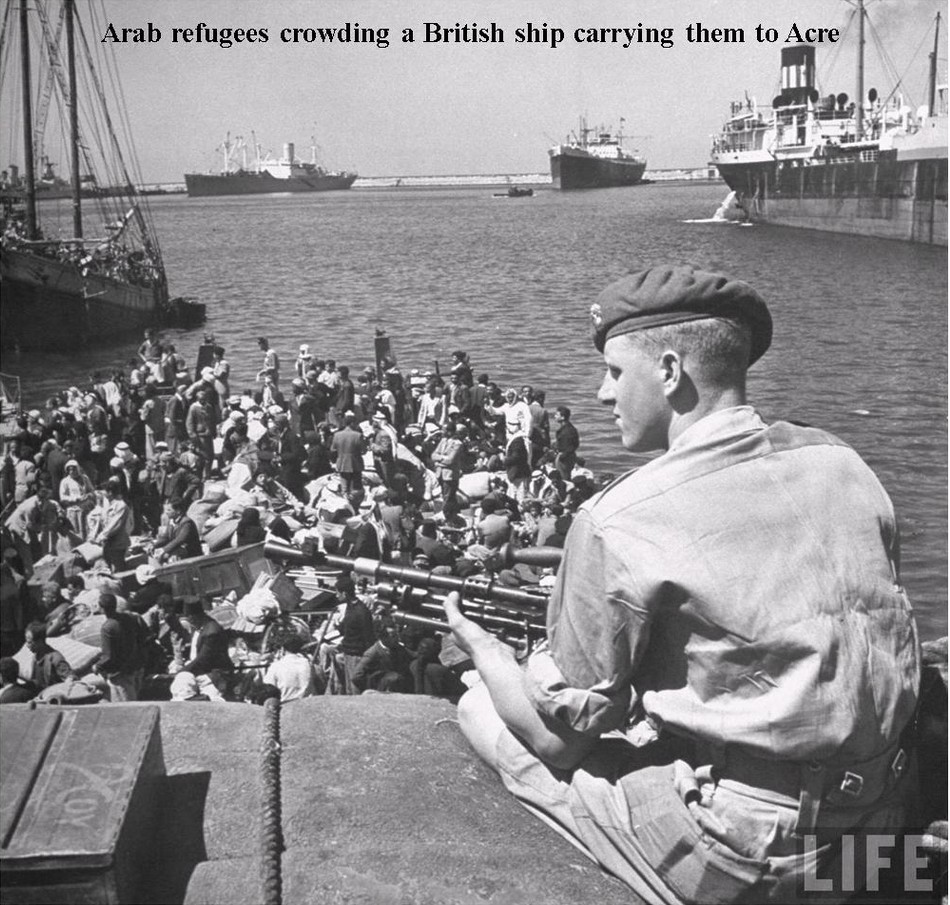 Haifa, Palestinians are crowded on ships to take them to Acre soon after they were ethnically cleansed by Zionist Jewish forces, in April 1948.
Haifa, Palestinians are crowded on ships to take them to Acre soon after they were ethnically cleansed by Zionist Jewish forces, in April 1948.A vital point to realise in connection with the Eichmann trial is the role that Kastner and other Zionists played in their relationship with Eichmann. "Hovering over the courtroom... was the ghost of Dr. Israel Kastner... Kastner had been the central figure in a sensational trial in Israel in 1953. The Attorney General at the time, Hausner's predecessor, had initiated a prosecution for criminal libel against a man who had alleged that Kastner's contacts with the SS in Budapest, in which he had sought to mitigate the lot of the Jews, had in fact amounted to collaboration." (92)
In view of the way the Kastner trial had gone, the Eichmann trial had to be handled very smoothly to prevent embarrassing revelations. On the whole, it did go smoothly, although there was one incident during the testimony of Pinhas Freudiger, formerly a member Of the Hungarian Central Jewish Council which had collaborated with the Nazis. "There was a disturbance in the court during Freudiger's testimony which brought to everyone's mind the issues of the Kastner case. A spectator in the hall suddenly got to his feet and managed, before he was hustled out, to scream to the witness in Hungarian, 'You duped us so you could save yourselves and your families. But our families were killed.' He was apparently attacking Freudiger not personally but as a representative of the Central Jewish Council, for he added, referring to another representative, 'He gave us injections to numb our minds. But he took his own parents out... and left mine there to die." (93)
Israeli police in the courtroom were constantly on the alert in case they had to "hustle out" anyone who threatened to bring the wrong note into this carefully stage-managed trial. However, Freudiger was accidentally allowed to reveal the spirit of defeatism spread by Zionism among European Jews, whom it encouraged not to resist Nazism. Freudiger blurted out: "But what could we do? What could we do? Today, some Hungarian Jews complain that we did not tell them to escape. But 50 percent of the people who escaped were captured and killed." (94) Needless to say, the proportion of those killed because they had been captured and did not try to escape was nearly 100 percent.
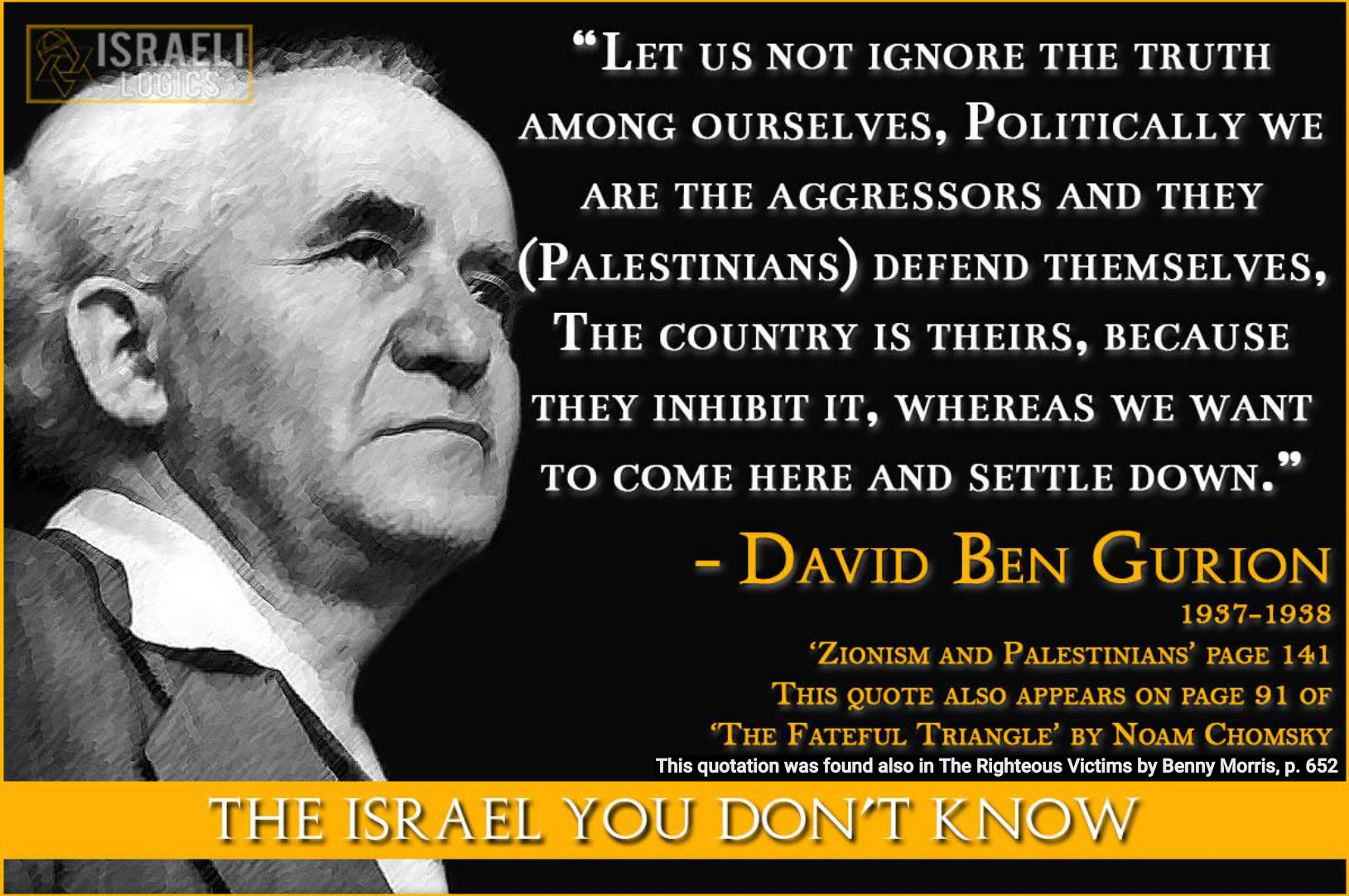 David Ben-Gurion: we're the aggressors; Arabs defend themselves. (Righteous Victims, p. 652)
David Ben-Gurion: we're the aggressors; Arabs defend themselves. (Righteous Victims, p. 652) The records of the Kastner case provide a vital clue on why the Israelis had to get hold of Eichmann and execute him themselves. For the Kastner case had also brought out the details of a deal which had come at the conclusion of the long Zionist collaboration with Nazism, and specifically Kastner's collaboration in Hungary with General Becher (then a Colonel) and three other SS Colonels, Krumey, Wisliczeny and Eichmann. "The four SS Colonels and Jewish Agency chief Kastner arranged their escape plot during the time of Jew-killing.
"Not precisely as one arranges a bank merger. There were too many unforseeable blot turns. But arranged it as an overall modus operandi. Three Of the Colonels would return to Germany and take their chances on facing arrest and trial as war criminals. Dr. Kastner would then ride to the rescue of these three and plead for them as a rescuer of Jews, as an official high in the councils of Jewish officialdom; and his pleading would gain freedom for the three exterminators.
"All three, and Kastner also, would dump the guilt of the Budapest quartet on the missing member, after helping the scapegoat achieve invisibility. The Quartet member who went into hiding, to become the sole symbol of Nazi evil in Hungary, was Adolf Eichmann." (95)
After these facts had been made public, Kastner was assassinated. Becher, with his prosperous trade with the Israeli Government, and Krumey, whom Kastner had also saved from trial at Nuremberg, could be relied on to say nothing. Wisliczeny was dead. But Eichmann was still at large and had to be prevented from ever telling his story to the public. At his trial, Eichmann pleaded that he had helped the Zionist cause but, in the emotional atmosphere stirred up by the Zionists in an astute public relations campaign, few people listened to him.
The Eichmann trial offered the Israeli leaders a chance of burying once again all the unpleasant things which the Kastner case had brought to light. As an American Jewish writer has observed: "When you consider that most Israelis knew about Kastner and his link to Israeli officialdom... then you begin to recognise another reason for Ben Gurion's insistence that the Eichmann trial be held in Israel. This trial was saying in effect, 'You see, here is your devil -- he did it." (96)
Witnesses at the Eichmann trial were carefully selected. Abba Kovner testified, but Chaim Lazar, who exposed Kovner's relationship with the Nazis, was not invited to testify. (97) Nor was Andre Biss, despite the important role he had played as Kastner's assistant. According to him, the reason for this was that he wanted to try to rehabilitate Kastner, and by then the Zionist leadership wanted to prevent anything that might remind the public of the Kastner trial or even bring new facts to light. Biss nevertheless revealed some interesting facts about those who were called as witnesses:
"Aharon Karie, charged by the public prosecutor's department to conduct investigations in Europe concerning Eichmann, assured me that I was the best-informed witness about Eichmann of all those whose existence he knew of. He was convinced I would be a capital witness for the prosecution at the trial and he begged me not to wait for an official invitation before going to Jerusalem. Therefore I left for Israel on April 9, 1961.
"At the Eichmann trial, 102 witnesses for the prosecution were heard. At least ninety of them had not only never met Eichmann, but until the end of the war had never even heard his name. I myself had seen the prisoner a greater number of times than all the other witnesses together. No one knew him as closely as I did.
"The date of my appearing before the court was fixed, yet finally I was not heard officially. The public prosecutor, Gideon Hausner, had asked me to omit from my evidence any mention of our action in Budapest, and especially to pass over in silence what was then in Israel the 'Kastner affair'. Furthermore, I should not speak of Becher's activities in favour of the Jews. Hausner absolutely refused to believe in these. I told him I could not give evidence unless I was free to tell the whole truth. Hausner finally preferred to dispense with me as a witness." (98)
At the time of Eichmann's capture, Israel's senior Judge was Benjamin Halevi, whose exemplary honesty in his handling of the Kastner libel case had led to extreme embarrassment for the Israeli Government. In order to prevent a repetition of this, Israeli Justice Minister Pinhas Rosen and Attorney General Hausner acted in an unprecedented manner by pushing a special law through the Knesset to deprive Judge Halevi of the right to preside over the Eichmann trial.
Rosen organised a pressure campaign designed to exclude Halevi from the trial altogether, although in the end he was allowed to be one member of a panel of judges who tried Eichmann. Hausner, as we have noted, was the prosecutor at the trial. Apart from being an interesting illustration of how Israeli justice works, the Government's treatment of Halevi shows that the Zionist leadership intended the Eichmann trial to be a propaganda stunt rather than a fair and honest attempt to establish the whole truth about Eichmann's crimes. (99)
As a central figure in some of the most important deals of co-operation between the Zionists and the Nazis, Eichmann, while not the most senior surviving Nazi war criminal, was probably the Nazi with the most detailed knowledge of the Zionist movement's relationship with the Nazi regime.
All that knowledge died with him.
IX. The Irgun and Nazism
In May 1977, as a result Of a general election, the rightwing extremist Likud bloc emerged as the strongest Zionist political grouping, and led the new Israeli coalition cabinet. Its Prime Minister was Menachem Begin, who had formerly headed the Irgun Zvai Leumi terrorist organisation.
During the period of the Kastner trial, Begin's Herut party, the most important component party of the Lukud, pointed an accusing finger at the leaders of its rival, the ruling Mapai party, for their collaboration with Nazism. The lawyer Shmuel Tamir was a Herut man (later he joined the Democratic Movement for Change), and veteran Irgun supporter Ben Hecht played a vital role in drawing public attention to the Kastner story. Many people thus inferred that the Irgun/Herut leaders had a cleaner record than their Mapai counterparts as far as dealing with Nazism were concerned, despite the cases of people like Jacob Gens and Salek Desler.
Recently, a document for long kept secret and finally revealed by German writer Klaus Polkehn shed light on the real attitude of the Irgun towards Nazism in 1941. In this document, the Stern faction of the Irgun proposed the following:
"it is often stated in the speeches and utterances of the leading statesmen of National Socialist Germany that a New Order in Europe requires as a prerequisite the radical solution of the Jewish question through evacuation ('Judenreines Europa').
"The evacuation of the Jewish masses from Europe is a precondition for solving the Jewish question; but this can only be made possible and complete through the settlement of these masses in the home of the Jewish people, Palestine, and through the establishment of a Jewish state in its historic boundaries.
"The solving in this manner of the Jewish problem and thus the bringing about with it of the liberation of the Jewish people once and for all is the objective of the political activity and the years-long struggle of the Jewish freedom movement: the National Military Organisation (Irgun Zvai Leumi) in Palestine.
"The NMO, which is well-acquainted with the goodwill of the German Reich government and its authorities towards Zionist activity inside Germany and towards Zionist emigration plans, is of the opinion that:
1) Common interests could exist between the establishment of a new order in Europe in conformity with the German concept, and the true national aspirations of the Jewish people as they are embodied by the NMO.
2) Co-operation between the new Germany and a renewed Hebrew nation (volkisch-nationalen-Hebraertum) would be possible and
3) The establishment of the historical Jewish state on a national and totalitarian basis and bound by a treaty with the German Reich would be in the interest of maintaining and strengthening the future German position of power in the Near East.
"Proceeding from these considerations. the NMO in Palestine offers to take an active part in the war on Germany's side, provided the abovementioned national aspirations of the Jewish liberation movement are recognised by the German Reich government.
"This offer by the NMO, whose validity extends over the military, political and information levels, inside and also according to certain organisational preparations outside Palestine, would be bound to the military training and organising of Jewish manpower in Europe, under the leadership and command of the NMO. These military units would take part in the fighting to conquer Palestine, in case such a front is formed.
"The indirect participation of the Israeli freedom movement in the drawing up of the New Order in Europe, already in its preparatory stage, would be connected with a positively radical solution of the European Jewish problem in conformity with the above-mentioned national aspirations of the Jewish people. This would strengthen to an uncommon degree the moral basis of the New Order in the eyes of the entire world.
"The co-operation of the Israeli freedom movement would also be in line with one of the recent speeches of the German Reich Chancellor in which Herr Hitler stressed that any combination and any alliance would be entered into in order to isolate England and defeat it." (100)
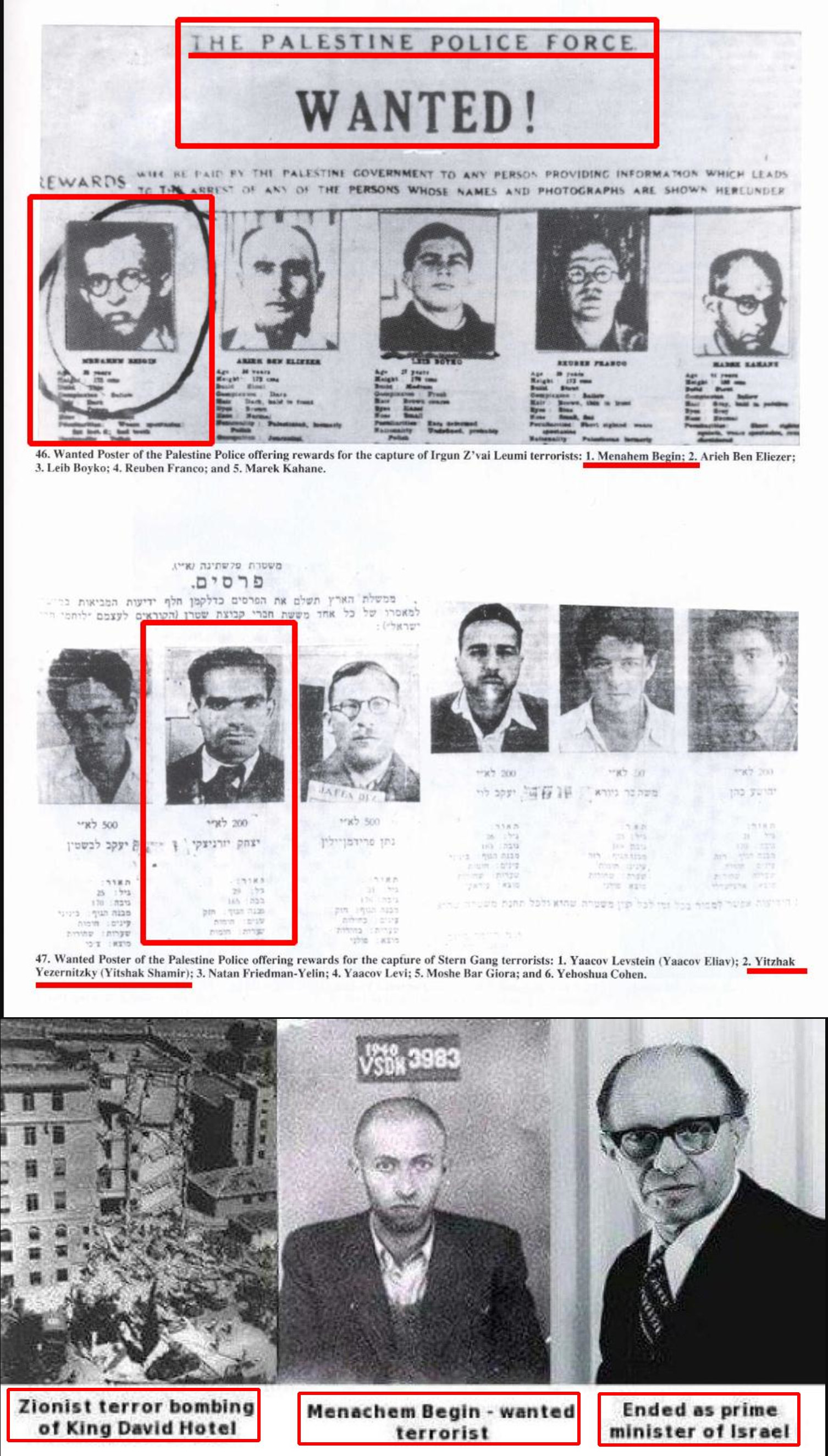 Why did Great Britain indict two of Israel's future PMs on charges of terrorism? Those evil British must have been "Jew-hating" antisemites!
Why did Great Britain indict two of Israel's future PMs on charges of terrorism? Those evil British must have been "Jew-hating" antisemites!A split occurred within the Irgun in relation to this issue. The faction led by Abraham Stern, which became known as the Stern Gang, launched immediate warfare against the British in Palestine. The other faction, which Begin was to lead, delayed, and some Of its members sided with the British for a time. The main reason for the delay seems to have been the Irgun's temporary disarray after the split. In 1943, Begin became the top man in the Irgun High Command, and the organisation was rearmed and its whole structure was reorganised. Once this period of preparation was completed, Begin's Irgun launched its military and terrorist campaign against the British in Palestine in January 1944, when World War Two was still at its height? Thus the difference between the two wings of the Irgun, which divided to become the mainstrean Irgun and the Stern Gang, was essentially a matter of timing rather than principle.
Indeed, before the split, the Irgun and the Revisionist Zionist party with which it joined forces firmly regarded Britain as the enemy and the "anti-Semitic" governments as allies. As the Union of Communal Settlements did with Nazi Germany, the Revisionist-Irgunists established co-operation arrangements, including training camps for Zionist pioneers, with the rabidly anti-Jewish regime in Poland. Abraham Stern negotiated this co-operation in 1937, and it included a Polish pledge of arms supplies for the Irgun.
The Irgun, in co-operation with the Revisionist youth movement Betar, planned to organise an uprising in Palestine by Zionist immigrants from Europe in October 1939, the month after World War Two was declared. The plan was to seize as many government buildings as possible and declare a Zionist "provisional government" The plan was foiled when the British arrested all the Irgun High Command's members. Even had it been carried out it would doubtless have been crushed rapidly, but it would nevertheless have undermined the British was effort against Nazism. (101)
Stern was killed in 1942 in a clash with British police. At the end of 1943, his followers established a separate organisation, Lohamei Herut Israel or "Lehi", which cooperated closely with Begin's Irvun. In 1948 Lehi members murdered the UN Mediator Count Folke Bernadotte, a Swedish humanitarian who had played an important role in World War Two rescuing Jews from Nazi rule and securing them refuge in Sweden.
X. Assessment of Zionist Policy towards Nazism
The foregoing evidence from Jewish sources demonstrates a number of important facts.
Zionism "prescribed immigration to Palestine as the only answer to anti-Semitism, it criticised, and rejected, any struggle for emancipation, civil rights legislation, etc. It found itself in one camp with those anti-Semites who said to the local Jewish communities, 'Go to Palestine'. Typically, the initiative in the Jewish struggle against Nazism during the 1930s never came from the Zionist organisation. It was the non-Zionist Jewish individuals and organisations who took the initiative and burden of that struggle on themselves. The fiercer that struggle became, the further apart did the Zionist organisation stand from the rest of Jewry. The underlying considerations are spelled out in a letter written by Ben-Gurion to the Zionist executive on December 17th, 1938:
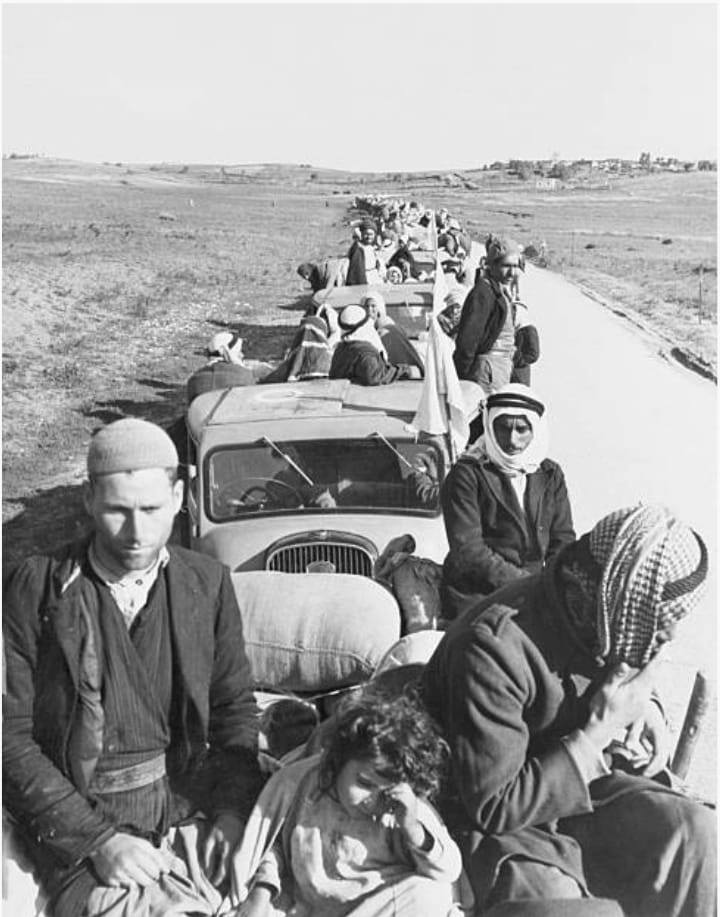 Palestinian are being ethnically cleansed out of Faluja in March of 1949
Palestinian are being ethnically cleansed out of Faluja in March of 1949"The Jewish problem now is not what it used to be, The fate of Jews in Germany is not an end but a beginning. Other anti-Semitic states will learn from Hitler. Millions of Jews face annihilation, the refugee problem has assumed world-wide proportions and urgency. Britain is trying to separate the issue of the refugees from that of Palestine. It is assisted by anti-Zionist Jews. The dimensions of the refugee problem demand an immediate, territorial solution; if Palestine will not absorb them, another territory will. Zionism is endangered. All other territorial solutions, certain to fail, will demand enormous sums of money. If Jews will have to choose between the refugees, saving Jews from concentration camps, and assisting a national museum in Palestine, mercy will have the upper hand and the whole energy of the people will be channelled into saving Jews from various countries. Zionism will be struck off the agenda not only in world public opinion, in Britain and USA, but elsewhere in Jewish public opinion. If we allow a separation between the refugee problem and the Palestine problem, we are risking the existence Of Zionism."
"The saving of Jewish lives from Hitler is considered here as a potential threat to Zionism, unless they are brought to Palestine. When Zionism had to choose between the Jewish people and the Jewish state it unhesitatingly preferred the latter...
"Zionism accepts anti-Semitism as the natural, normal attitude of the non-Jewish world towards the Jew. It does not consider it as a distorted, perverted phenomenon, it is a response to anti-Semitism but not a confrontation, denunciation or fight against it." (102)
"Zionists fundamentally accept the racial ideology of the anti-Semites, but draw a different conclusion. Instead of the Teuton, it is the Jew that is the pure or superior race." (103)
This concept of a superior race is apparent in the "saving" of youth emphasis Zionism placed on the pioneers for emigration to Palestine, and the neglect Of the elderly who could not make such a contribution to building Zionist statehood. Implicit in this is an acceptance of the Nazi principle of superior and inferior categories of human beings.
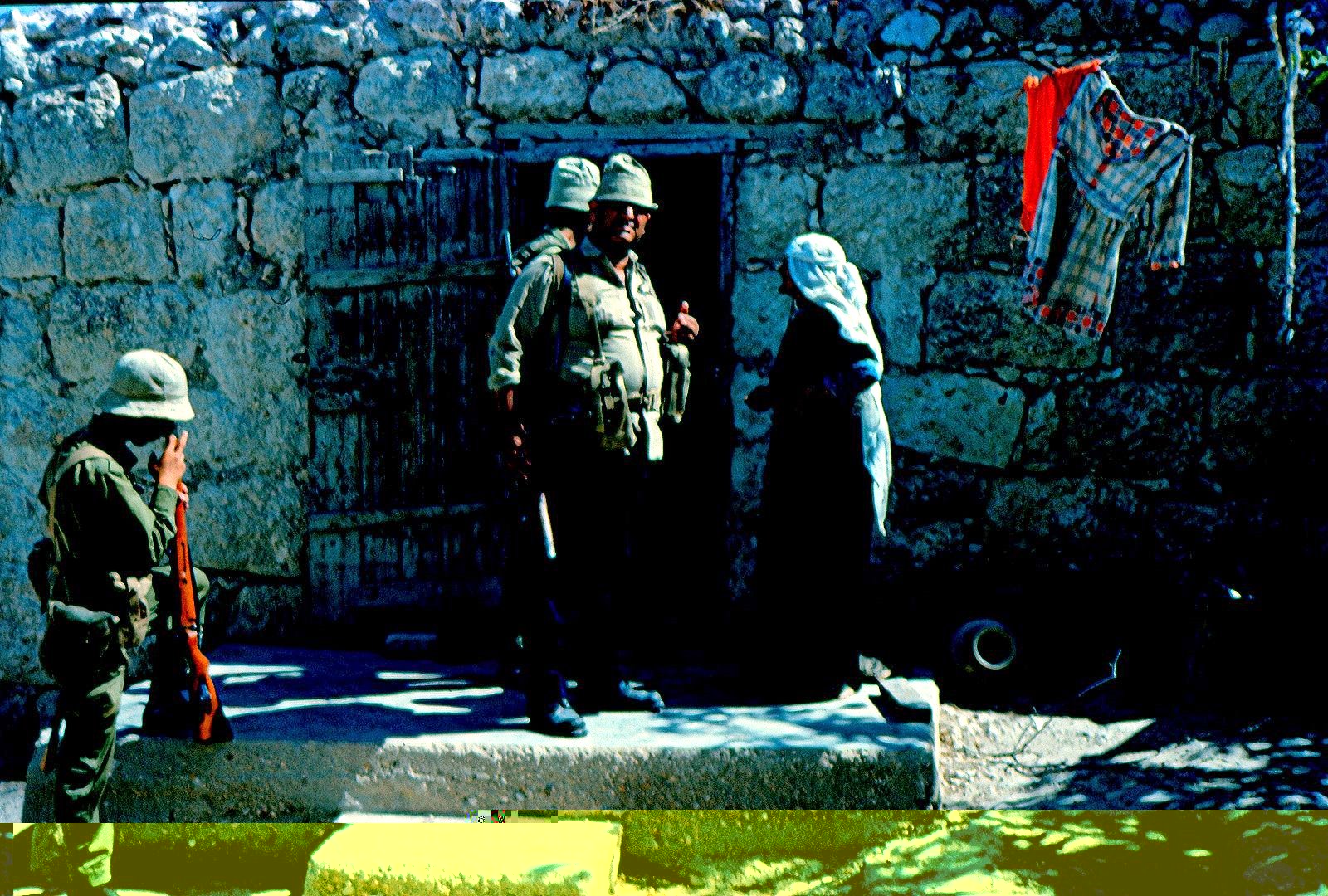 Palestinian are being ethnically cleansed out of 'Imwas & Yalu on June 7th, 1967 by Zionists Jewish forces on direct orders from Yitzhak Rabin
Palestinian are being ethnically cleansed out of 'Imwas & Yalu on June 7th, 1967 by Zionists Jewish forces on direct orders from Yitzhak Rabin"The categories had been accepted without protest by German Jewry from the very beginning, and the acceptance of privileged categories -- German Jews as against Polish Jews, war veterans, and decorated Jews as against ordinary Jews, families whose ancestors were German had born as against recently naturalised citizens, etc. been the beginning of the moral collapse Of respectable Jewish society... What was morally so disastrous in the acceptance of these privileged categories was that everyone who demanded to have an 'exception' made in his case implicitly recognised the rule, but this point, apparently, was never grasped by these 'good men', Jewish and Gentile, who busied themselves about all those 'special cases' for which preferential treatment could be asked. The extent to which even the Jewish victims had accepted the standards of the Final Solution is perhaps nowhere more glaringly evident than in the so-called Kastner Report. Even after the end Of the war, Kastner was proud of his success in saving 'prominent Jews', a category officially introduced by the Nazis in 1942 as though in his view, too, it went without saying that a famous Jew had more right to stay alive than the ordinary one."
The Zionist envoys who negotiated the 1938 emigration accords "spoke a language not totally different from Eichmann... Indeed, they were in a position to deal with the Nazi authorities on a footing amounting to equality, which native Jews were not, since they enjoyed the protection of the mandatory power; they were probably among the first Jews to talk openly about mutual interests and were certainly the first to be given permission 'to pick young Jewish pioneers' from among the Jews in the concentration camps. Of course, they were unaware Of the sinister implications Of this deal, which still lay in the future; but they too somehow believed that if it was a question of selecting Jews for survival, the Jews should do the selecting themselves. It was this fundamental error in judgment that eventually led to a situation in which the non-selected majority of Jews inevitably found themselves confronted with two enemies the Nazi authorities and the Jewish authorities." (104)
The Zionists showed remarkable single-mindedness in pursuing their aim of securing their state in Palestine and subordinating all other considerations to this. "The intervention of the Zionist movement in the question of the possibility of Jews emigrating to America is a classic example of the cynicism of the 'cruel Zionism'. At the time of the Second World War hundreds of thousands of European Jews could still have escaped the Nazis by emigrating to other countries. The US and Britain refused to allow 500,000 Jewish refugees to enter and receive political asylum and this enabled the Nazis to kill them in the gas-chambers. A broad campaign was organised in the US demanding the opening of the gates to free immigration of European Jews in support of what was known as the 'Roosevelt Plan'--a project to enable a few hundred thousand Jews to enter the US and Britain.
"It is beyond all doubt that representatives of the Zionist movement in the US tried to sabotage the plan to save Jewish refugees by bringing them to the US or to any place other than Palestine. As a matter of fact, Roosevelt himself used Zionist pressure against immigration as an excuse for not allowing free Immigration. Morris L. Ernst, a famous New York lawyer and one of the most dedicated activists in the attempt to open the doors of the US to Jews, sums up the response of Zionist leaders to his humanitarian endeavours: 'l was amazed and insulted when active Jewish leaders decried, sneered and then attacked me as if I were a traitor. At one dinner party, I was openly accused of furthering this plan for more free immigration in order to undermine political Zionism. Those Jewish groups which favoured opening our doors gave little more than lip service to the Roosevelt programme. Zionist friends of mine opposed it." (105)
"Both before and after the war the Zionists were powerful enough to scuttle efforts to find havens for the oppressed outside of Palestine. The US Secretary of the Interior was prevailed upon in the thirties to oppose the settlement of Jewish refugees as homesteaders in Alaska, and then pressure was exerted on the Australian Government to abandon the 'Kimberley' project for the settlement of Jewish refugees in Western Australia, which had been sponsored by the Freeland League and had won partial approval. The Freeland League in its publication later asked: 'Who can tell how many thousands of Jewish lives might have been saved from Hitler's claws if these anti-Jewish pressures exerted by Jews had not been effected? Who can tell how many thousands might have started a new life in Kimberley instead of ending their lives in Auschwitz?" (106)
Admitting that the Jews of Europe have suffered beyond expression, why in God's name should the fate of all these unhappy people be subordinated to the single cry of Statehood? I cannot rid myself of the feeling that the unfortunate Jews of Europe's DP camps are helpless hostages for whom statehood has been made the only ransom." (107)
The policy of Zionist collaboration with Nazism bore fruit from the earliest days of Hitler's rise to power, in the figures of Zionist immigration to Palestine. "In 1932, 9,000 German Jews entered Palestine. In 1933, 30,000; in 1934, 40,000; in 1935, 61,000. In 1931, there were only 174,616 Jews in Palestine, but by 1939 the number had risen to 445,457" (108)
The Zionist leaders were to reap important financial benefits from their policy after the war, too. "Having thus turned their backs on the doomed Jews, the same leaders later used the extermination for raising millions on millions, and for collecting billions in reparations from the Germans." (109)
Granted these clear gains which Zionism reaped, how did the Zionists agree to the Jewish communities of Europe paying such a heavy price for these, estimated at some 6 million people murdered? It should be noted that the vast majority of these were from Eastern Europe, with some half of the total from Poland alone. The Polish Jewish historian Isaac Deutscher may provide the answer to this question: "It should be realised that the great majority Of Eastern European Jews were, up to the outbreak of the Second World War, opposed to Zionism. This is a fact of which most Jews and non-Jews in the West are seldom aware. The Zionists in our part of the world were a significant minority, but they never succeeded in attracting a majority of their co-religionists. The most fanatical enemies of Zionism were precisely the workers, those who spoke Yiddish, those who considered themselves Jews; they were the most determined opponents of the idea of an emigration from Eastern Europe to Palestine." (110)
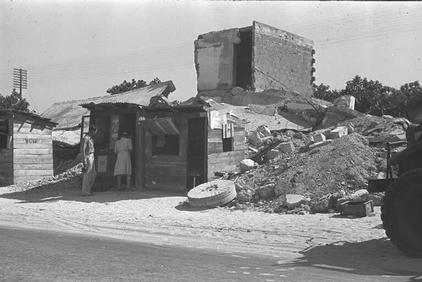 Persecuted European Jews occupy the ethnically cleansed village of Yazur, 1949
Persecuted European Jews occupy the ethnically cleansed village of Yazur, 1949
The philosophy of those Zionists in Eastern Europe, such as Gens and Kastner, who made deals with the Nazis was not an individual aberration but a reflection of official Zionist policy. Executive Vice-Chairman of the United Jewish Appeal Henry Montor expressed it thus: "Selectivity is an inescapable factor in dealing with the problem of immigration to Palestine. By 'selectivity' is meant the choice of young men and women who are trained in Europe for productive purposes either in agriculture or industry and who are in other ways trained for life in Palestine, which involves difficulties and hardships for which they must be prepared physically and psychologically... There could be no more deadly ammunition provided to the enemies of Zionism, whether they be in the ranks of the British Government or the Arabs, or even in the ranks of the Jewish people, if Palestine were to be flooded with very old people or with undesirables who would make impossible the conditions of life in Palestine and destroy the prospect of creating such economic circumstances as would ensure a continuity of immigration." (111)
The results of Zionist co-operation with Nazism were disastrous for the masses of European Jews. "Wherever Jews lived, there were recognised Jewish leaders and this leadership, almost without exception, co-operated with the Nazis. The whole truth was that if the Jewish people had really been unorganised and leaderless, there would have been chaos and plenty of misery, but the total number of victims would hardly have been between four and a half and six million people."(112)
The full story of the role of Zionism during the Hitler period is still not widely known, not only among the world at large, but also among Jewish communities. The effectiveness with which it has been suppressed, and the myth that the Zionists are defenders of Jewry has been circulated, is an indication Of how successful the Zionist movement has been in the art of propaganda.
References
- 1. Theodor Herzl. The Jewish State (New York, 1946) p. 92.
- 2. Hannah Arendt, The Jewish State, 50 Years After -- Where nave Herzl's Politics Led ? (article in Commentary, Vol. l, No. 7, May 1946).
- 3. Moshe Menuhin, The Decadence of Judaism in Our Time (Institute for Palestine Studies reprint, Beirut, 1969) p.p. 46-47.
- 4. Quoted by Reuben Ainsztein, Jewish Resistance in Nazi-Occupied Eastern Europe (London, 1974) p. 151,
- 5. Report of Royal Commission on Alien Immigration, 1902-1903 (Crnnd. 1741 & 1742).
- 6. Jewish Chronicle, 23 December 1904.
- 7. Hansard, 10 July 1905, vol. 149, Col 154-155.
- 8. Theodor Herzl, Diaries (Marvin Lowenthal's translation, New York, 1956) p. 7.
- 9. Chaim Weizmann. Trial and Error (New York, 1 949) p. 243.
- 10. Memorandum on the Antismitism Of the Present Government. 23 August 1917.
- 11. Oscar Janowsky. People at Bay (London. 1938) p. 26-127.
- 12. J.W. Wise; Swastika. the Nazi Terror (New York. 1933) p. 59-60.
- 13. Ibid., p. 104-107.
- 14. Report dated 2S April 1933. from Innsbruck.
- 15. Norman Bentwich, The Refugees from Germany (London. 1936) p. 30.
- 16. Hannah Arendt. Eichmann in Jerusalem: A report on the Banality of Evil (New York. 1963) p. 53-54.
- 17. Ibid.. p. 54-55.
- 18. Wise, op. cit., p. 45.
- 19. Eliahu Ben Elissar, La Diplorutie du Ille Reich et tes Juifs (Julliard, place of publication not stated, 1969) p. 86-87.
- 20. Raul Hilberg, ne Destruction of the European Jews (London, 1 961) p. 95.
- 21. Ben Hissar, op. cit.. p. 90-94,
- 22. Israel Cohen, Contemporary Jewry (London, 1950) p. 186.
- 23. Arendt, op. cit. , p. SS.
- 24. Letter from Blurnenfeid. for Zionist Federation, to Nazi official Bulow- Schwante, II June 1934.
- 25. Ben Ehssar, op. cit. s p. 185-186.
- 26. Gerald Reitlinger, lhe Final Solution (New York. 1961) p. 7.
- 27. Ben Hissar, op. cit., p. 186-187.
- 28. Janowsky. op. cite, p. 90-91.
- 29. Ben Ebssar, op. cit.. p. 204.
-
30. Ibid. , p. 219.
 Palestinian are being ethnically cleansed out of al-Ramla & al-Lydd in July 1948 by Zionists Jewish forces on direct orders from Ben-Gurion, and executed by Yitzhak Rabin
Palestinian are being ethnically cleansed out of al-Ramla & al-Lydd in July 1948 by Zionists Jewish forces on direct orders from Ben-Gurion, and executed by Yitzhak Rabin - 31. Oscar janowsky and Melvin Fagen, International Aspects of German Racial Policies (New York, 1937). p. 49-50.
- 32. Bentwlch? op. cit. , p. 142-143.
- 33. Ben Ehssar, op. cit., p. 423-424.
- 34. Jon & David Kimche, Secret Roads (London, 1954) p. 15-16.
- 35. Ibid., p. 17-19.
- 36. Ibid. P. 30.
- 37. Arendt, op. cit., p. 39.
- 38. Ibid., p. 41.
- 39. Kimche, op. cit, p. 27, 30-31.
- 40. Ibid.,p.217
- 41. Ibid., p. 33-35.
- 42. p. 217.
- 43. 6,000,000 Accusers, opening address in Adolf Eichmann trial, Sessions 6-8.
- 44. Shlomo Katz, 6,000.000 and (article in Midstream. No. 1, 1964),
- 45. Reuben Ainsztein, Jewish Resistance in Nazi-Occupied Eastern Europe
- 46. (London, 1974) p. 408, 442. 468, 634-638. Letter from Mordechai Anielewicz to Polish Home Army Command and Government Delegate's offices 13 March 1943.
- 47. Ainsztejn, op. cite p. 486.
- 48. Joseph Tenenbaum, Underground, the Story of a People (New York, 1952) p. 81-82.
- 49. Ibid. p. 347-348.
- 50. Appeal by Itzik Wittenberg and Abba Kovner to Vilno ghetto inhabitants, 1 January 1942.
- 51. Ainsztein? op. cit. , p. 505-507.
- 52. Tenenbaum. op. cit., p. 344-345.
- 53. Ibid. p. 353-354.
- 54. Reb Moshe Shonfeld, The Holocaust Victims Accuse, Part 1, (Neturei Karta of USA. New York, 1977) p. 30-33.
- 55. Yuri Suhl, They Fought Back (London, 1968) p. 191.
- 56. Shonfeld, op. cit.. p. 88, 119-121.
- 57. Amsztein. op. cit.. p. 521-547.
- 58. Shonfeld, op. Cir., p. 22-23.
- 59. Michael Hins, Forged in Fury (New York, 1971) p. 62, 64-65.
- 60. Ainsztein, op. cit.. p. 565. 599.
- 61. Ibid.. p. 620.
- 62. Suhl, op. cit. , p. 622.
- 63. Ainsztcin,op. cit. , p. 622.
- 64. Ibid., p. 591-671; see also Chaim A, Kaplan, Scroll of Agony (A Warsaw Diary). translated & edited by Abraham L. Katsch (London,1966) and Martin Gray, Au Nom de Tous tes Miens (Pans, 1971) for accounts by ghetto inhabitants.
- 65. Ainztein, op. cit.. p. 556-561.
- 66. Letter to Issac Cuklerman, 26 April 1943.
- 67. Tenenbaum op. cit.. p. 381.
-
68. Letter to The Times, 6 June 1961.
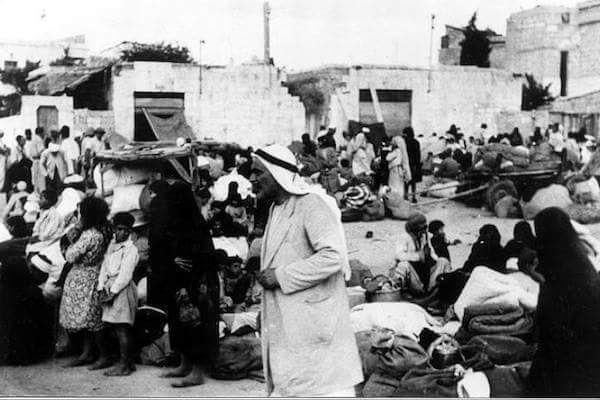 Palestinian are being ethnically cleansed out of al-Ramla & al-Lydd in July 1948 by Zionists Jewish forces on direct orders from Ben-Gurion, and executed by Yitzhak Rabin
Palestinian are being ethnically cleansed out of al-Ramla & al-Lydd in July 1948 by Zionists Jewish forces on direct orders from Ben-Gurion, and executed by Yitzhak Rabin - 69. Shonfeld, op. cit.. p. 63-65.
- 70. Elkins, op. cit.. p. 59, 166.
- 71. Ibid., p. 197, 237.
- 72. Statement to the Zionist convention in London. August 1937.
- 73. Speech on "lite Diaspora and the Redemption", Tel-Aviv; February 1943.
- 74. Shonfeld, op. cit., p. 21.
- 75. Ben Hecht, Perfidy (New York, 1961) p. 58-59.
- 76. Official charge sheet, Criminal Case 124/53, District Court. Jerusalem.
- 77. Judgement was given on 22 June 1955, Protocol Of Criminal Case 124/53 in District Court, Jerusalem.
- 78. Hecht. op. p. 202-208.
- 79. Letter to Zionist representatives, 15 May 1944.
- 80. Affidavit before Mr. Benno H. Selcke of American Evidence Division, International Military Tribunal, Nuremberg, 4 August 1947.
- 81. Hecht, op. cit., p. 67.
- 82. Ibid. , p. 84.
- 83. Haaretz. 14 July 1955.
- 84. Hecht, op. cit., p. 185.
- 85. See Ibid., p. 208-250 and Shonfeld, op. cit.. p. 36-39 for details of Joel Brand story; well as Alex Wetssberg, Die Geschichte von Joel Brand (Cologne, 1956).
- 86. Shonfeld. op. cit. , p. 76, 82-86.
- 87. Andre Biss. A Million Jews to Save (London, 1975) p. 21, 37.
- 88. Habokers 23 June 1955.
- 89. Protocol C.C. 1 24/53, Jerusalem District Court.
- 90. Menuhin, op. cit., p. 473.
- 91. Alfred Lilienthal, Other Side of the Coin (New York, 1965) p. 109; New York Times, 16 December 1960'. Arendt, op. cite. p. 16.
- 92. Moshe Pearlmann. The Capture and Trial of Adolf Eichmann (New York, 1963) p. 534.
- 93. Ibid.. p. 358.
-
94. Ibid.. p. 359.
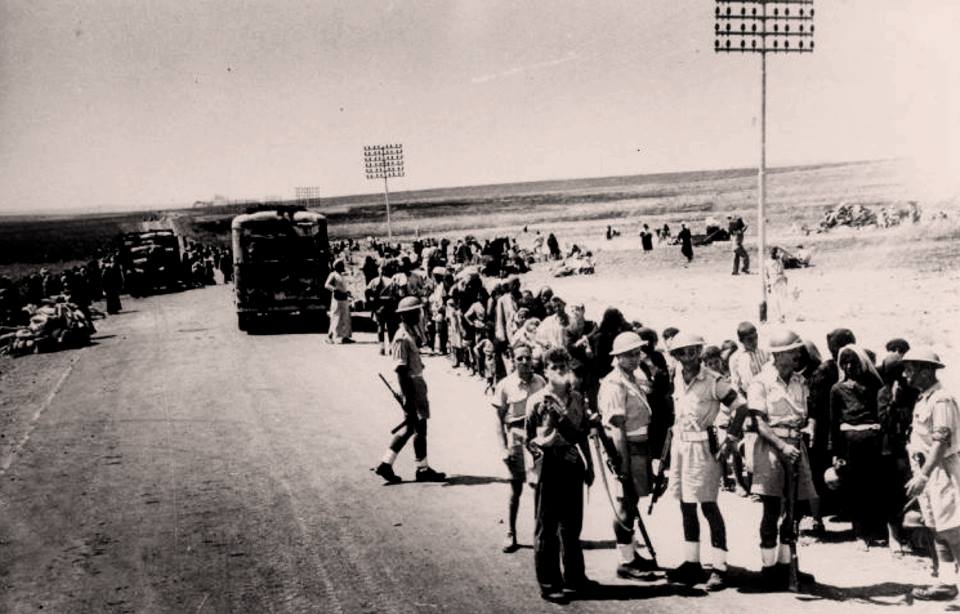 Palestinian are being ethnically cleansed out of al-Ramla & al-Lydd in July 1948 by Zionists Jewish forces as you see based on direct orders from Ben-Gurion, and executed by Yitzhak Rabin
Palestinian are being ethnically cleansed out of al-Ramla & al-Lydd in July 1948 by Zionists Jewish forces as you see based on direct orders from Ben-Gurion, and executed by Yitzhak Rabin - 95. Hecht, op. cite p. 200.
- 96. Leonard Sussman. Analysis of Perfidy (American Council for Judaism) quoted by Menuhin, op. cit., p. 484.
- 97. Shonfeld, op. cit., p. 30.
- 98. Bisss op. cit., p. 191.
- 99. Hecht, op. cite, p. 267, note 148.
- 100. Memorandum dated 11 January 1941 submitted in the report of German Naval Attache in Turkey, quoted by Klaus Polkehn, The Secret Contacts: Zionist-Nazi Relations, 1933-1941 (article in Journal of Palestine Studies, Vol. V, Nos. 3 & 4, Spring/Summer 1976).
- 101. See Joseph Schechtman, Fighter and Prophet (New York, 1961) p. 483-484 and Gerold Frank Deed (New York 1963) p. 79
- 102. The Other Israel. (Marzpen pamphlet, Tel Aviv, n.d.) p. 9-10,
- 103. Morris R. Cohen, Tribalism or Liberalism, essay in Palestine: a Search for truth, ed. Alan R. Taylor and Richard N. Tetlie (Washington, DC, 1970), p. 71.
- 104. Arendt, op. cit.. p. 55-56.
- 105. Izzi Cohen, The Cruel Zionism (article in Matzpen. April 1974). The quotation is from Morris L. Ernst, so Far so Good (London, 1953), p. 138-139.
- 106. Lilienthal, op. cite, p. 20.
- 107. Arthur Hayes Sulzberger in New York Times, 27 October 1946.
- 108. Menuhin, op. cit., p. 92.
- 109. Hecht, op. cit., p. 50.
- 110. Isaac Deutscher. The Non-Jewish Jew & Other Essays (London, 1968) 66.
- 111. Letter to Rabbi Baruch Rabinowitz, Congregation Wnai Abraham, Hagerstown, Maryland, 1 February 1940.
- 112. Arendt. op.cit., p. 111.
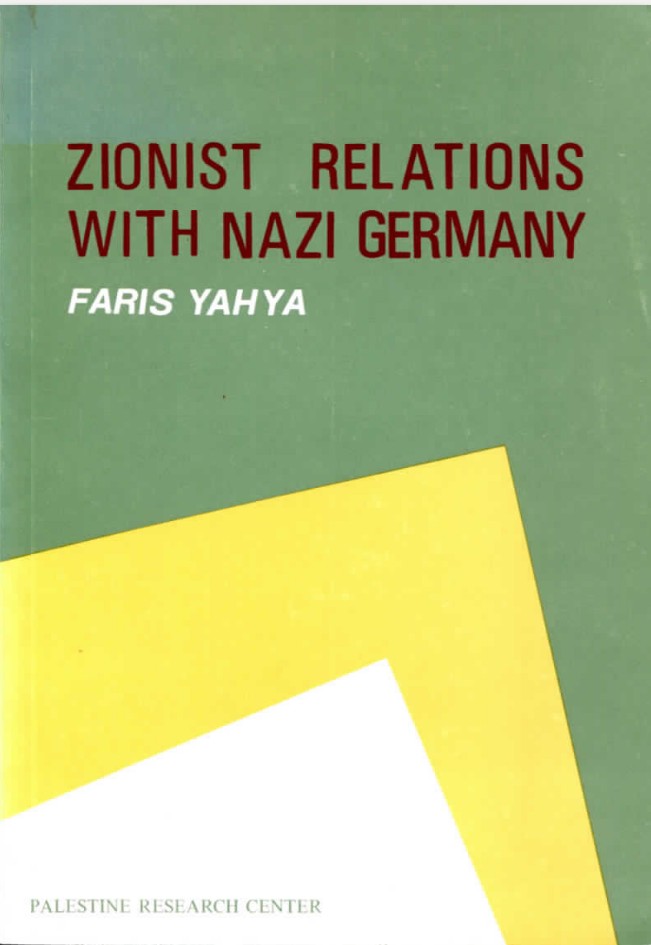
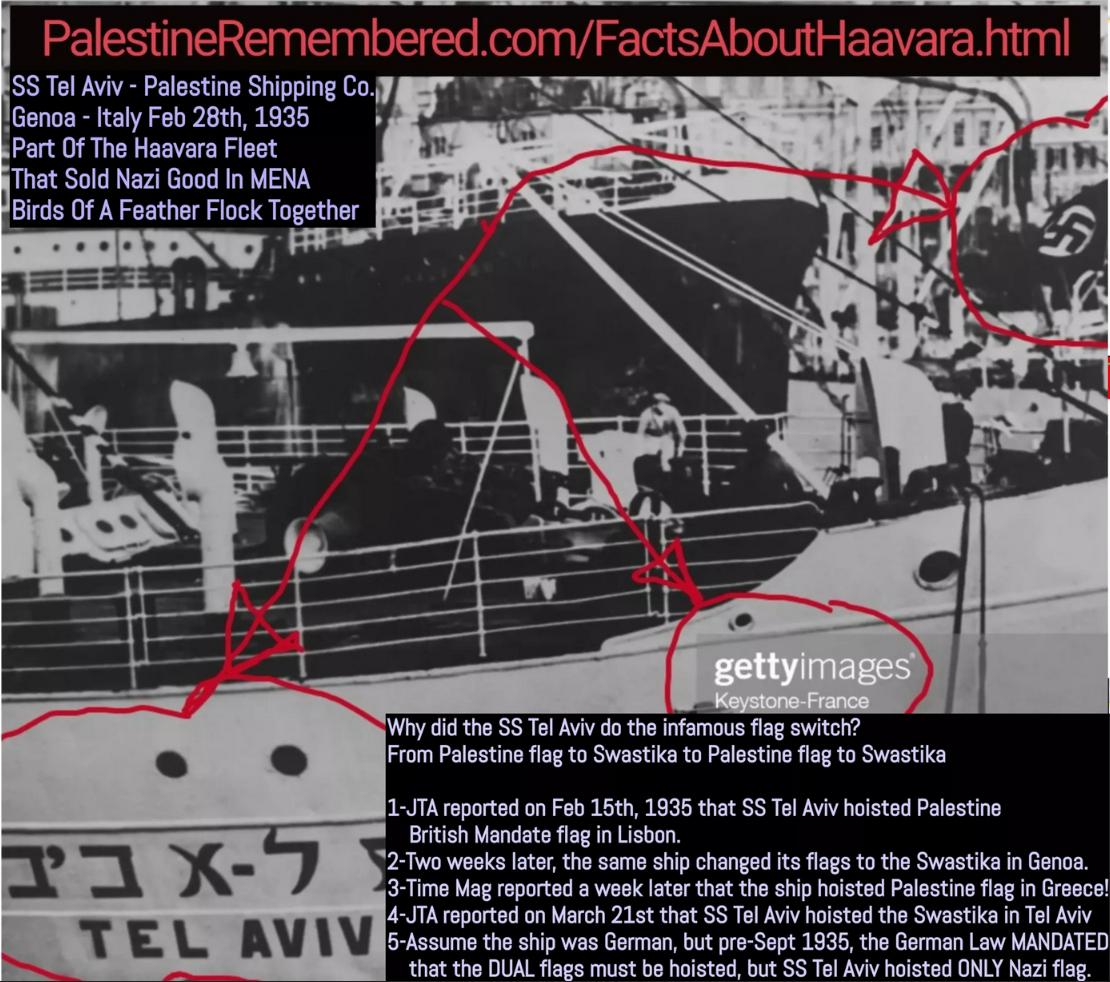
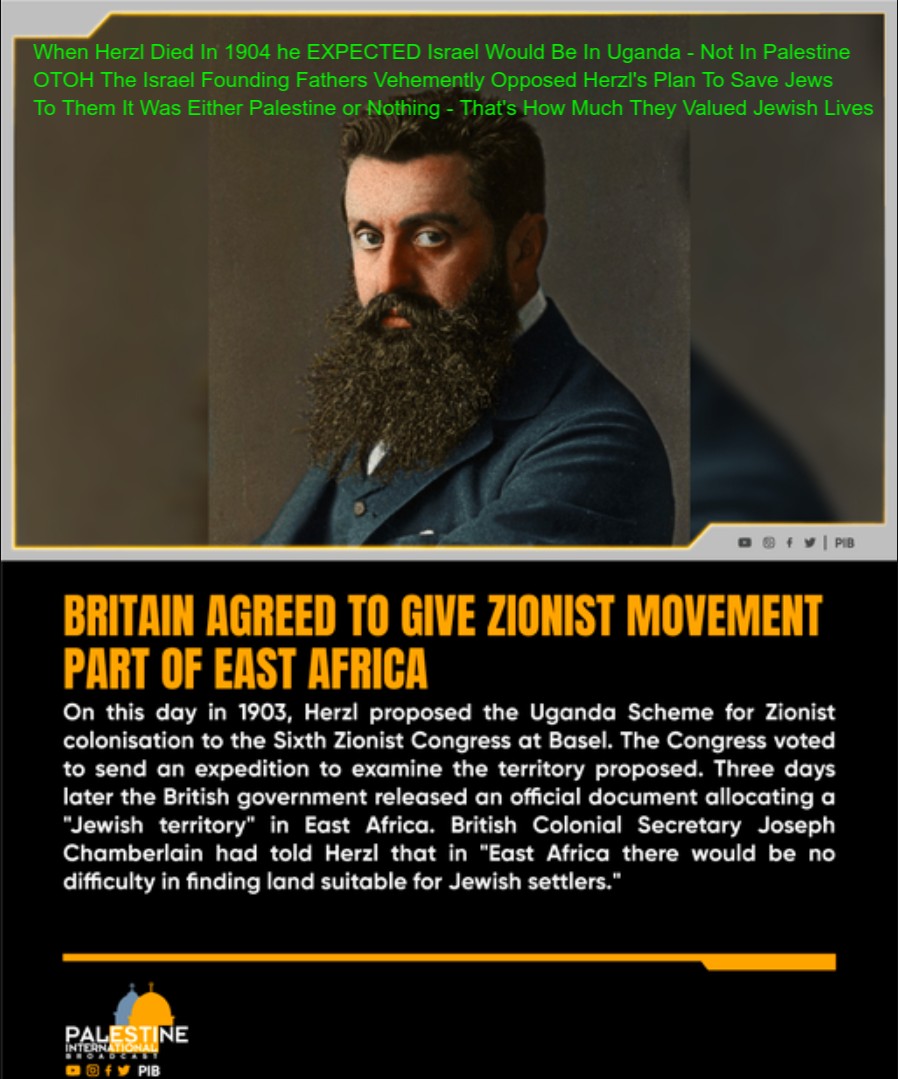
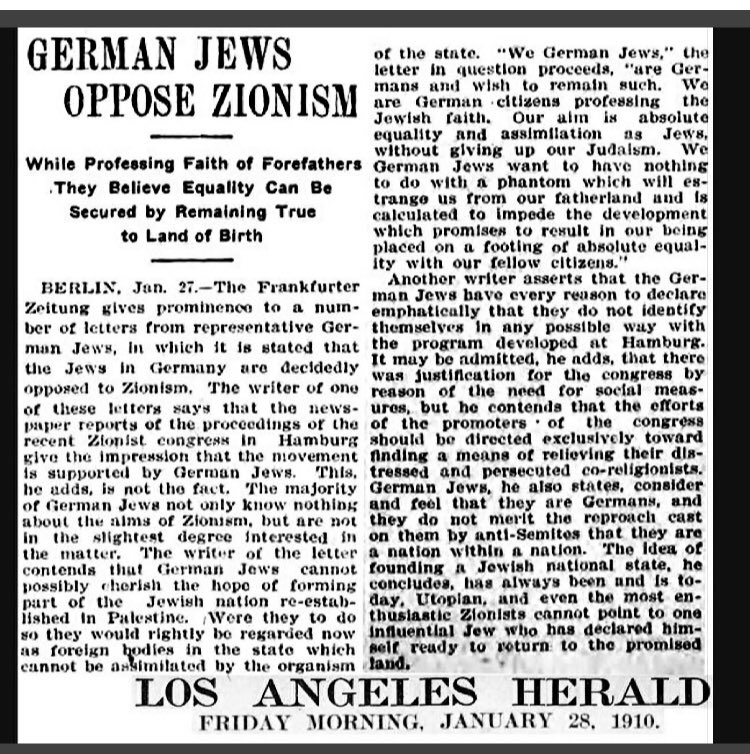

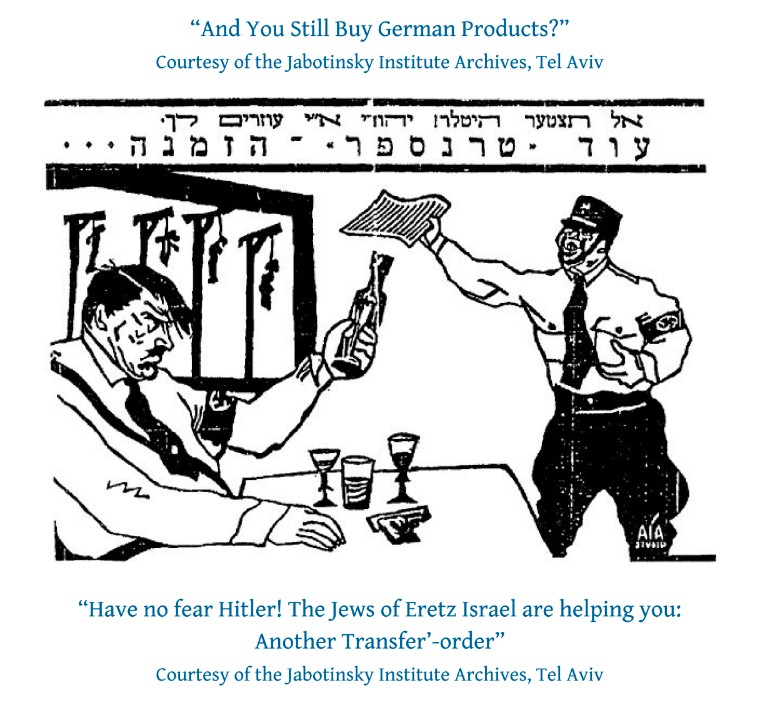
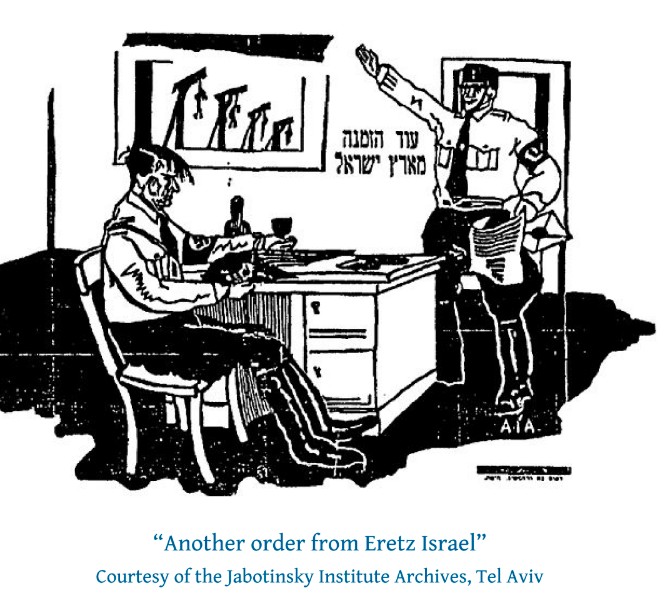
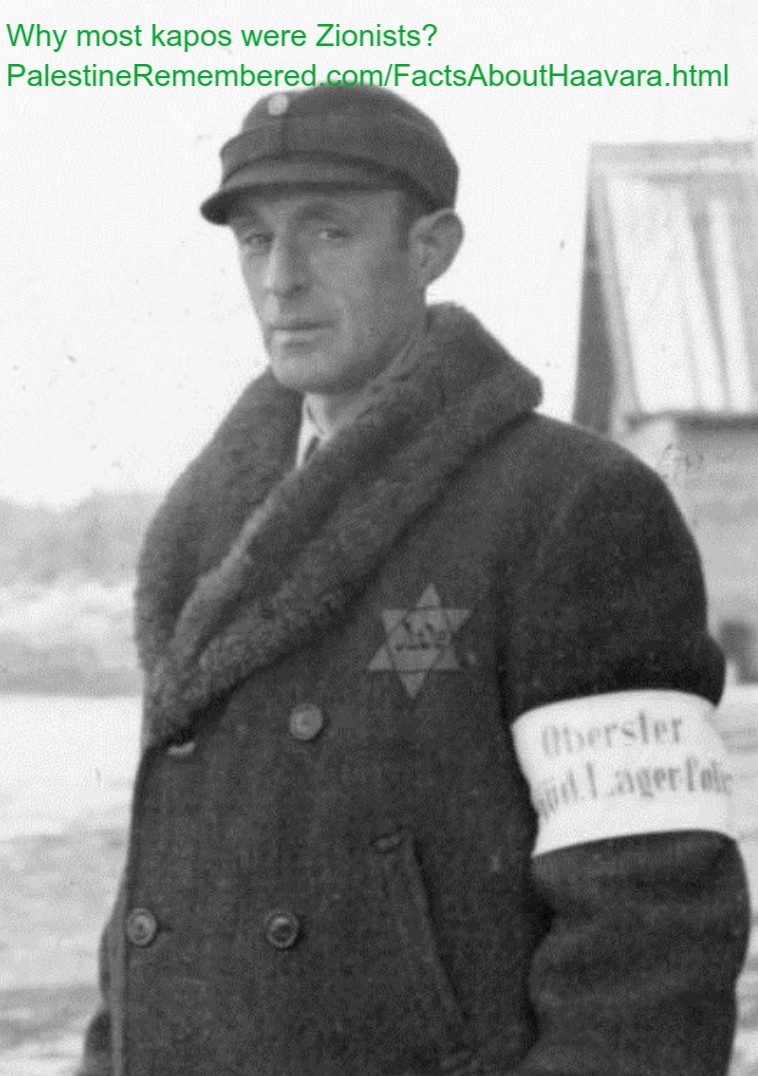
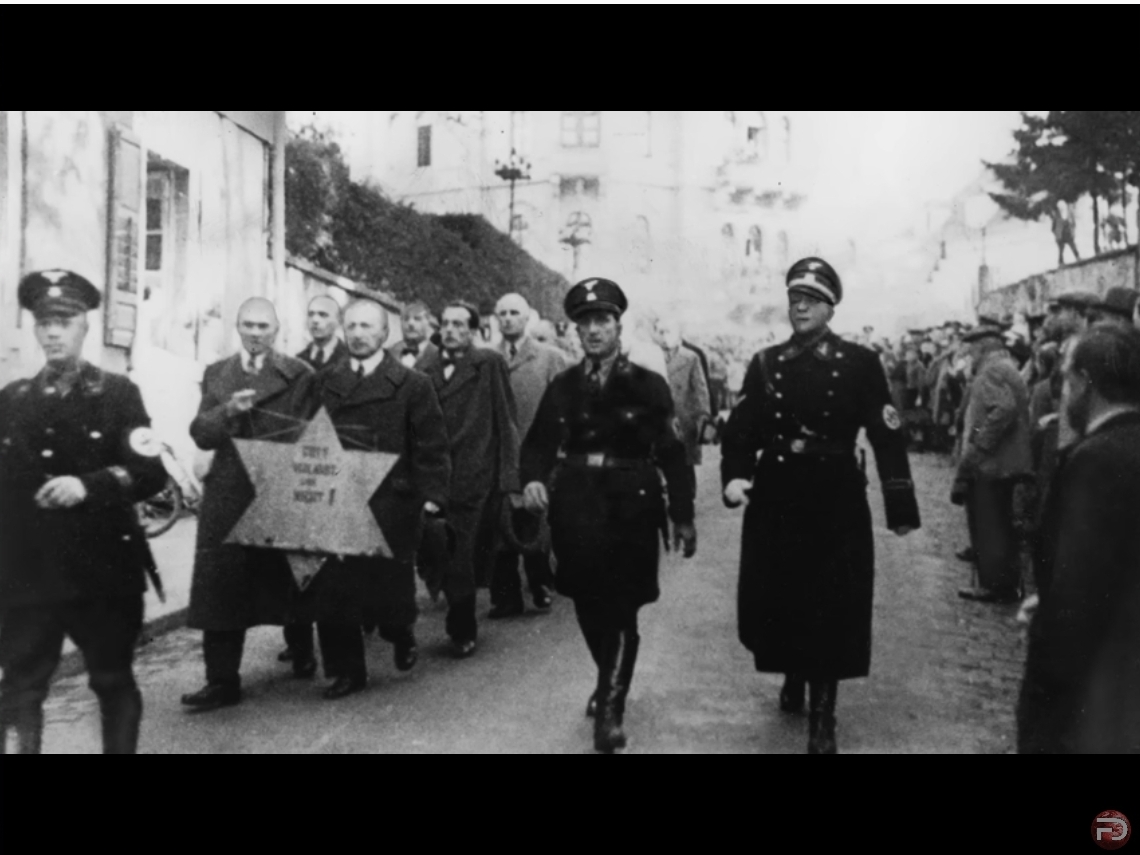
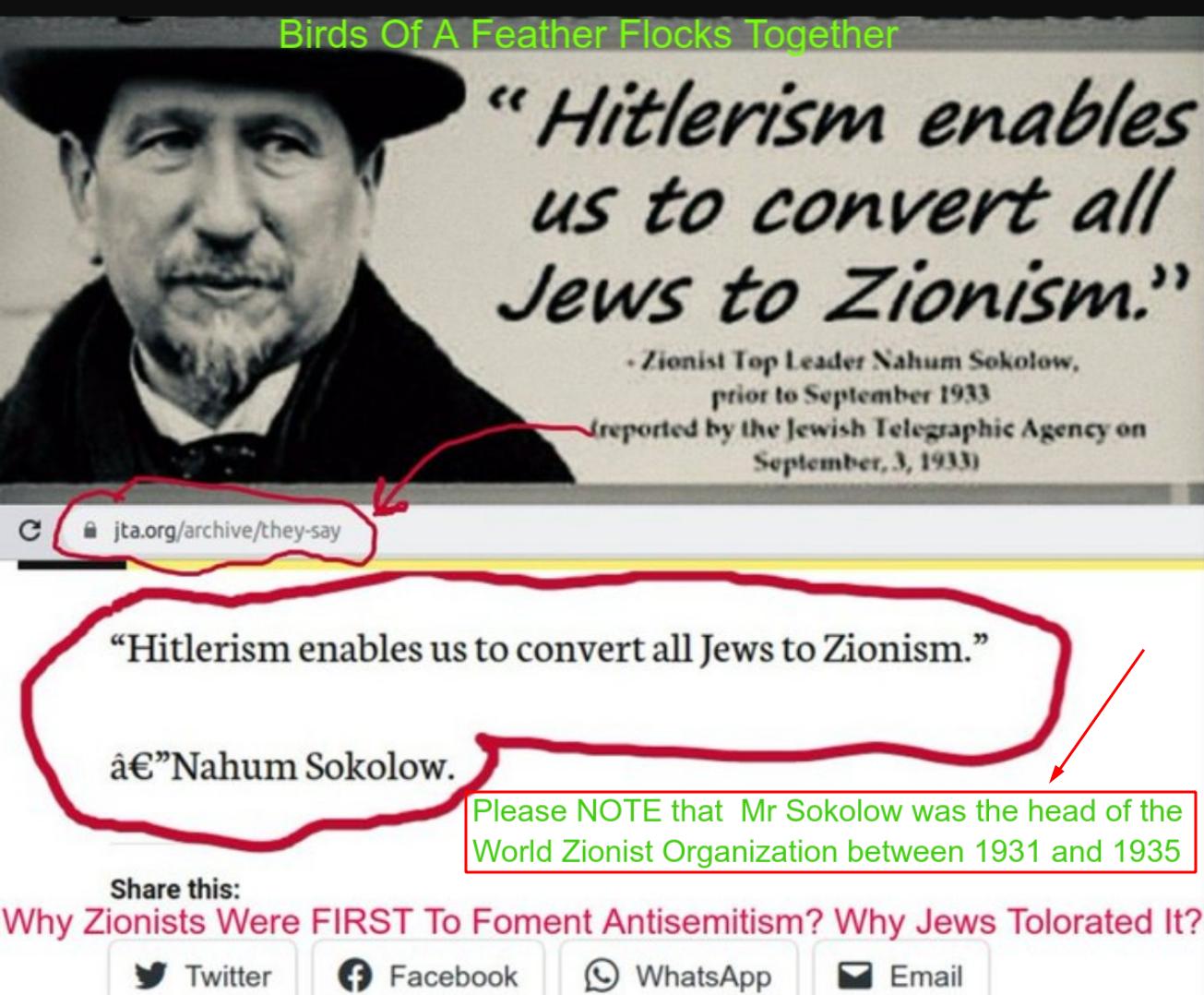
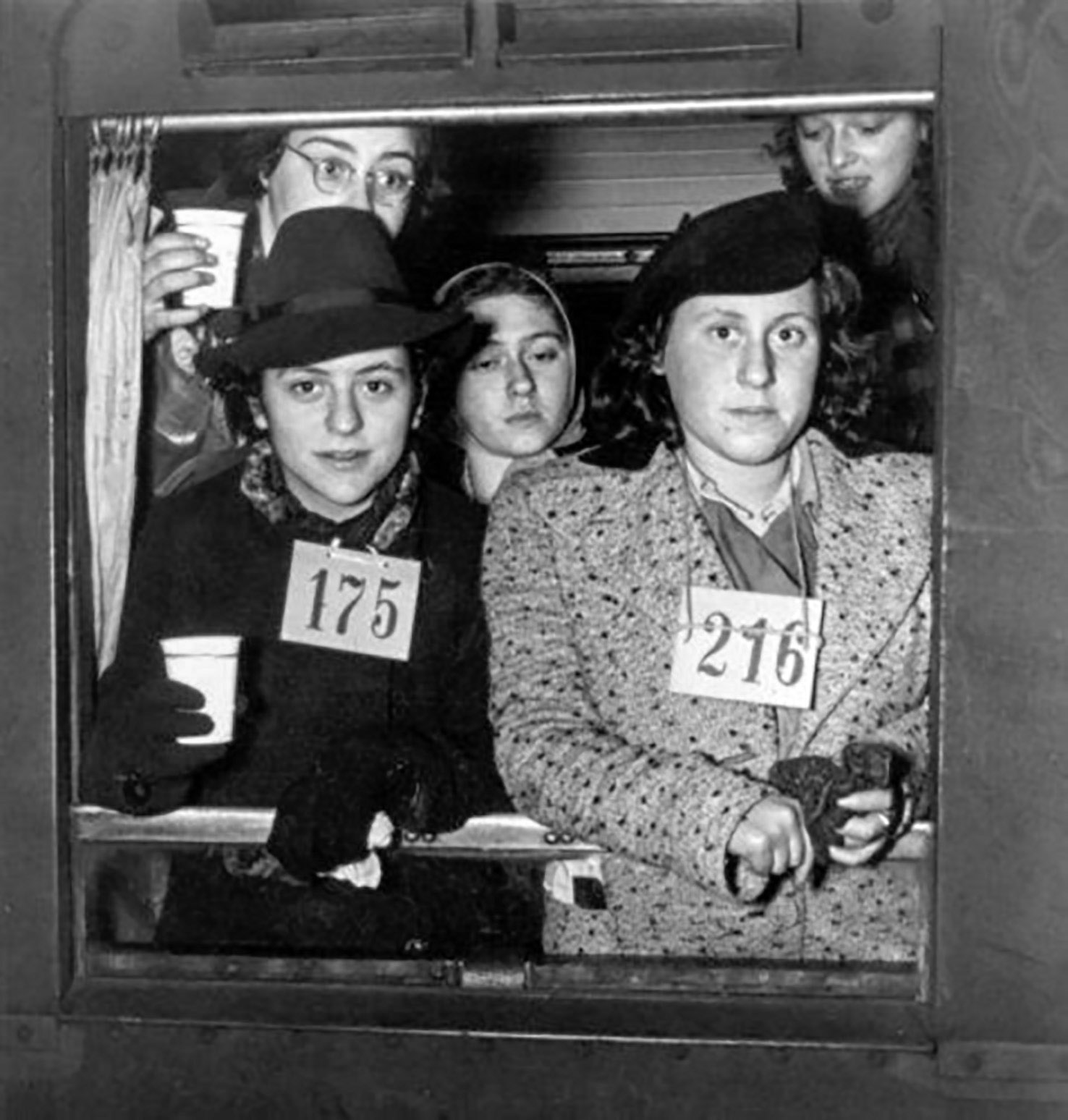
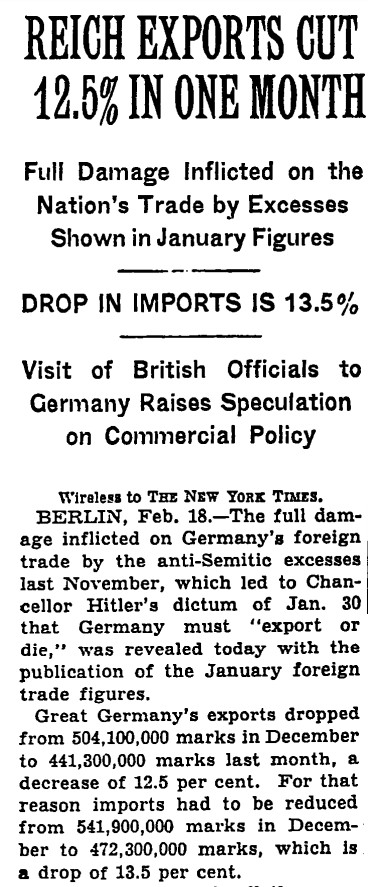
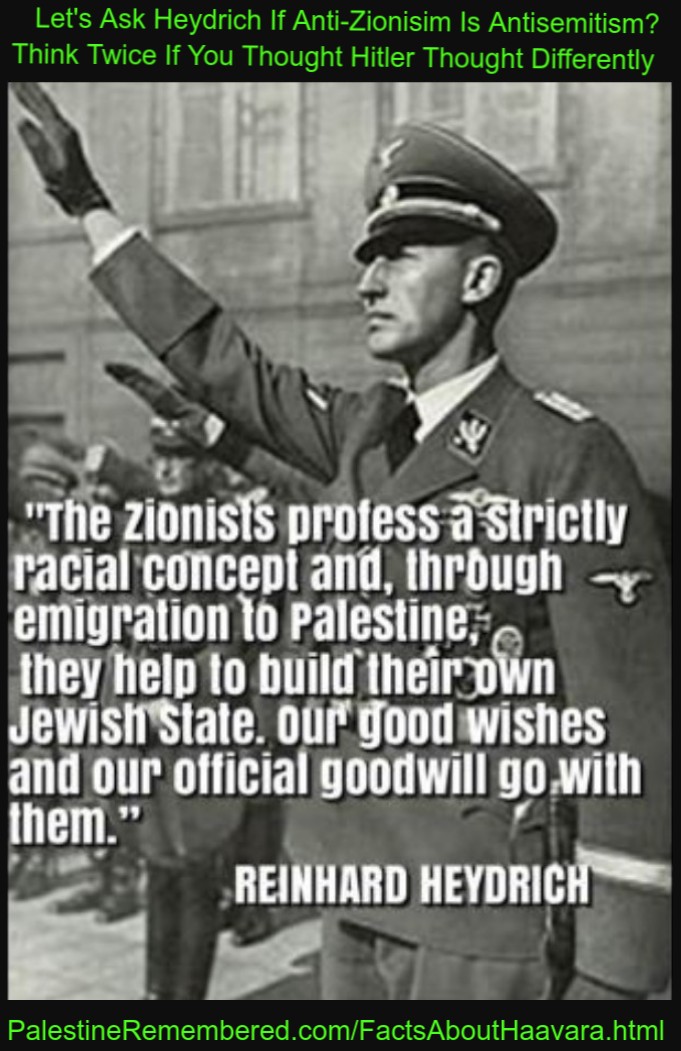
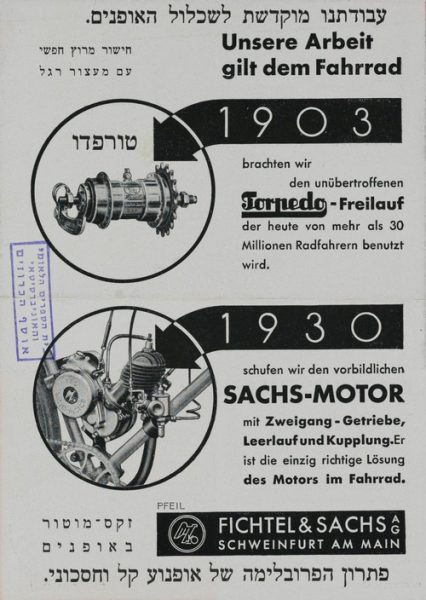
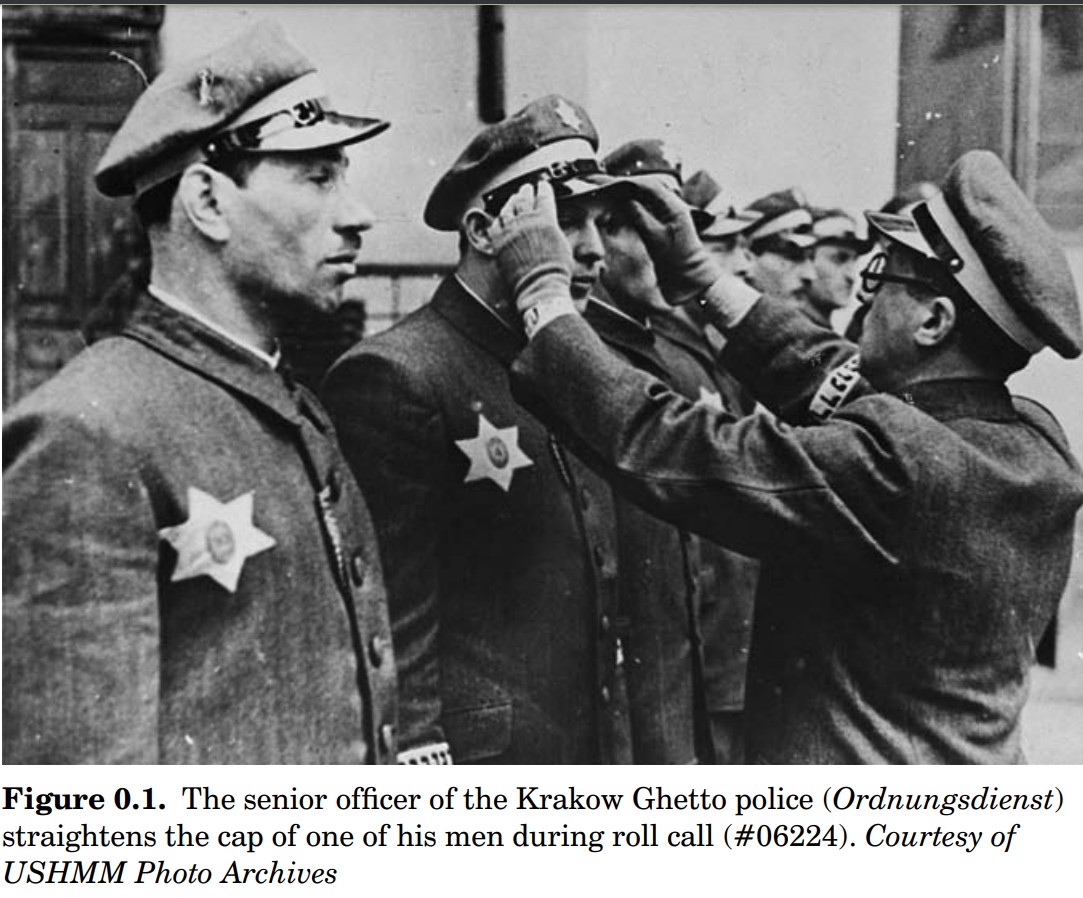
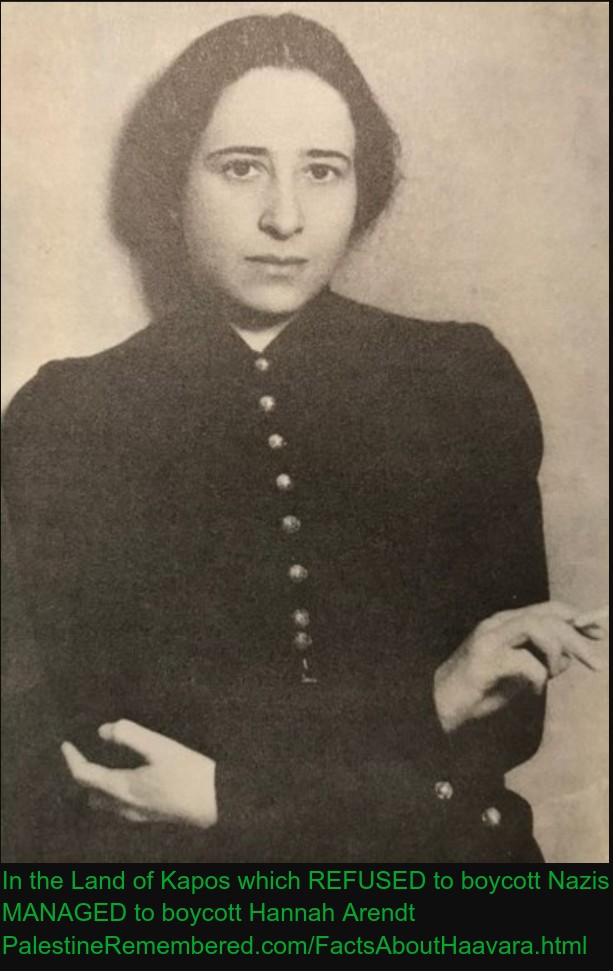
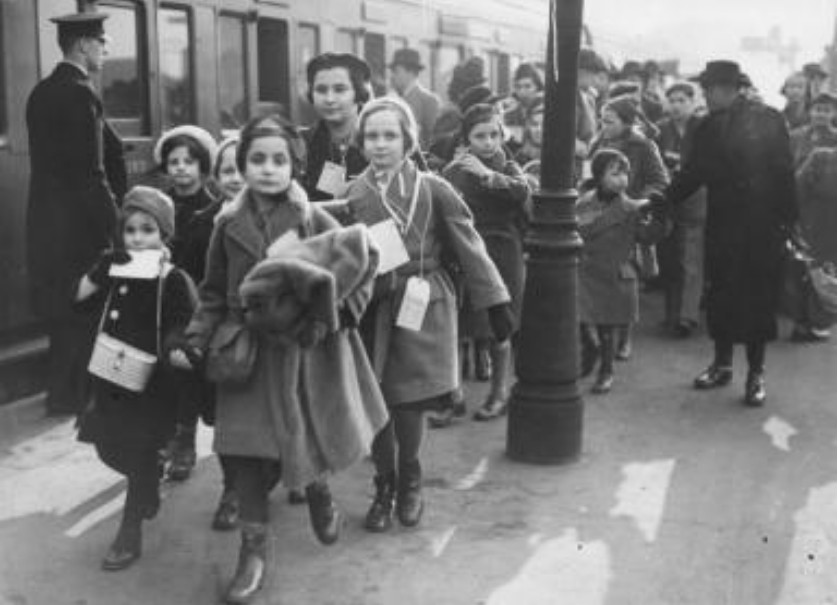
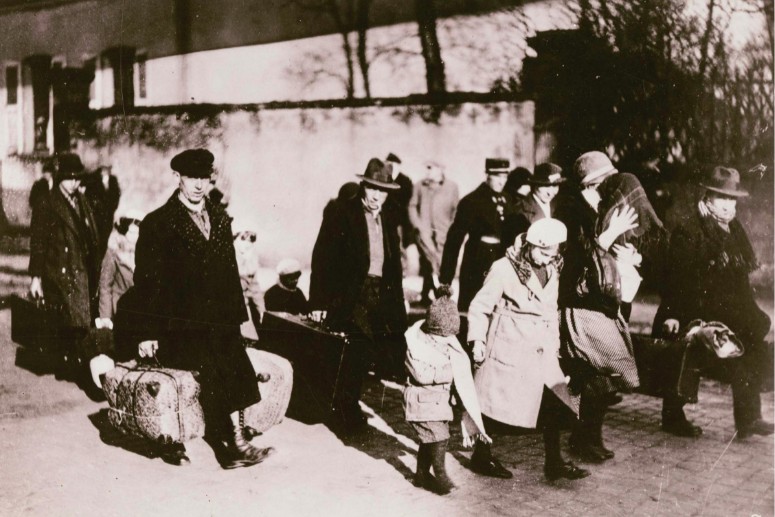
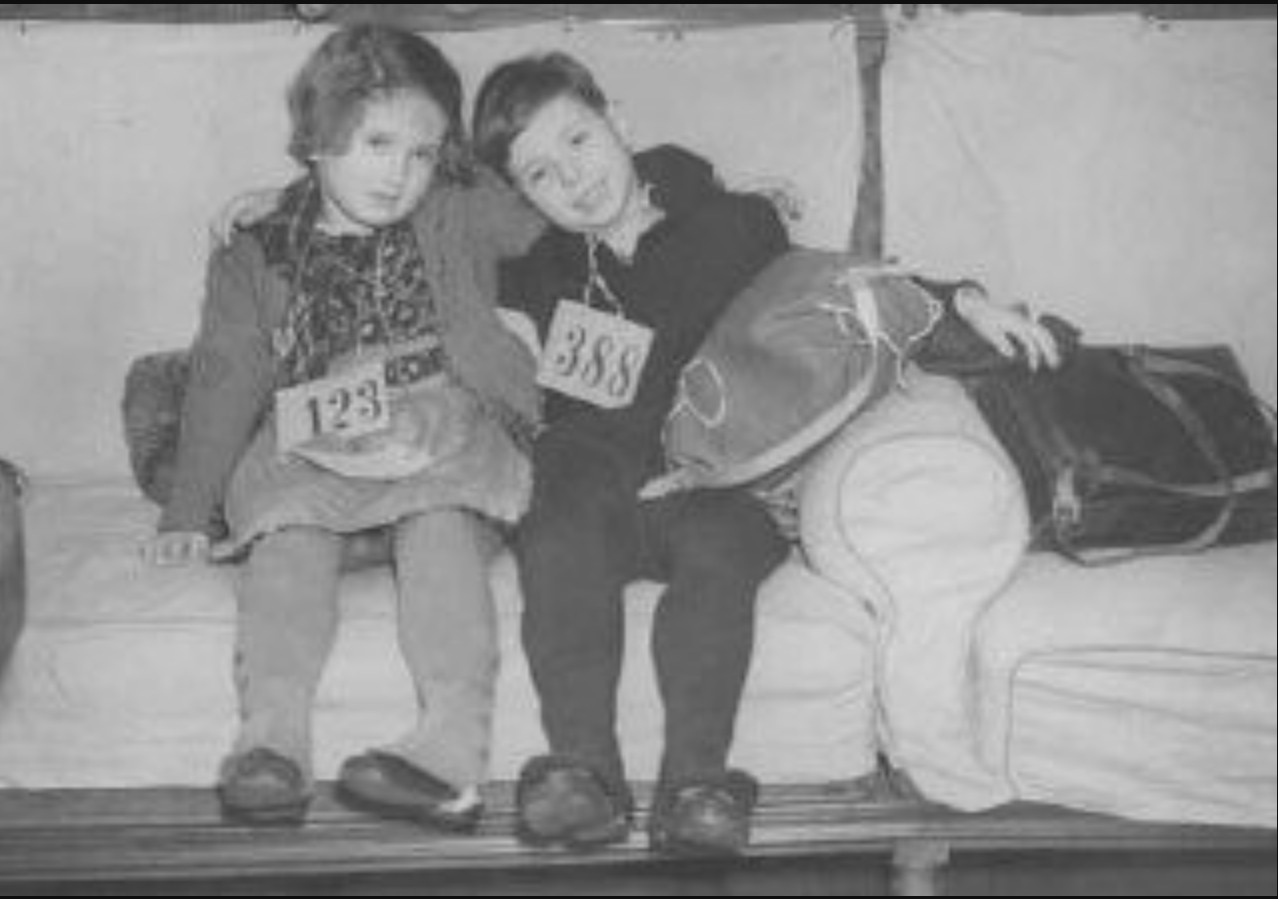
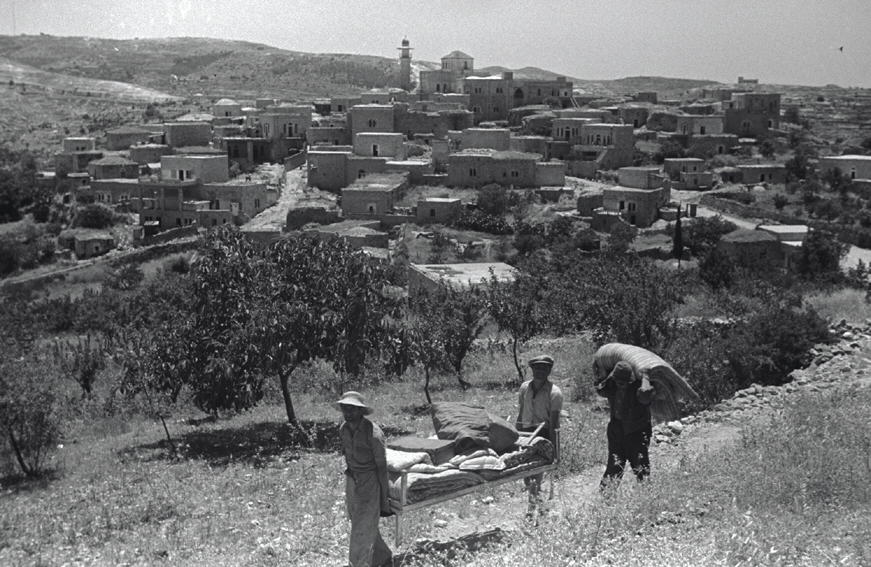
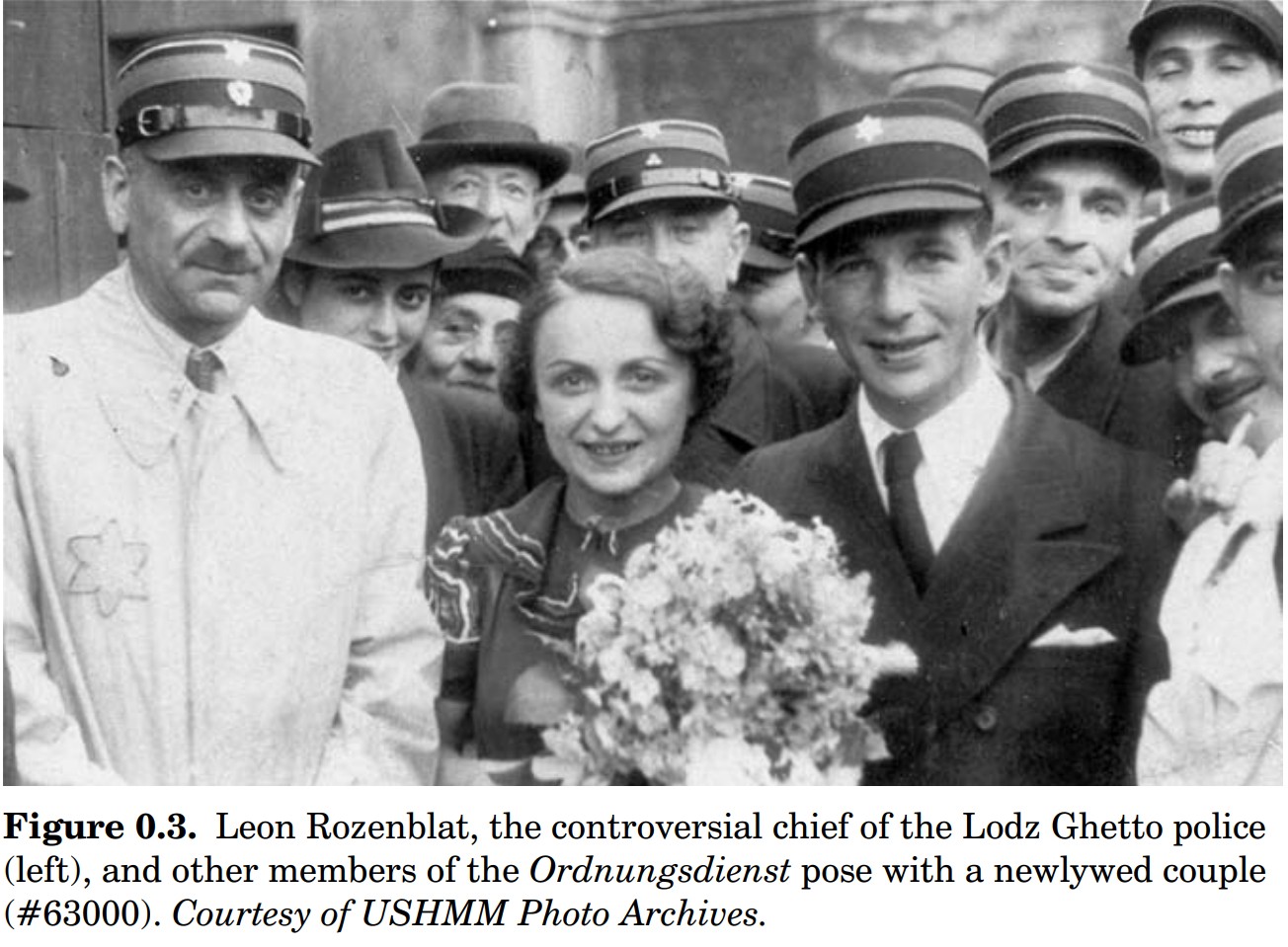
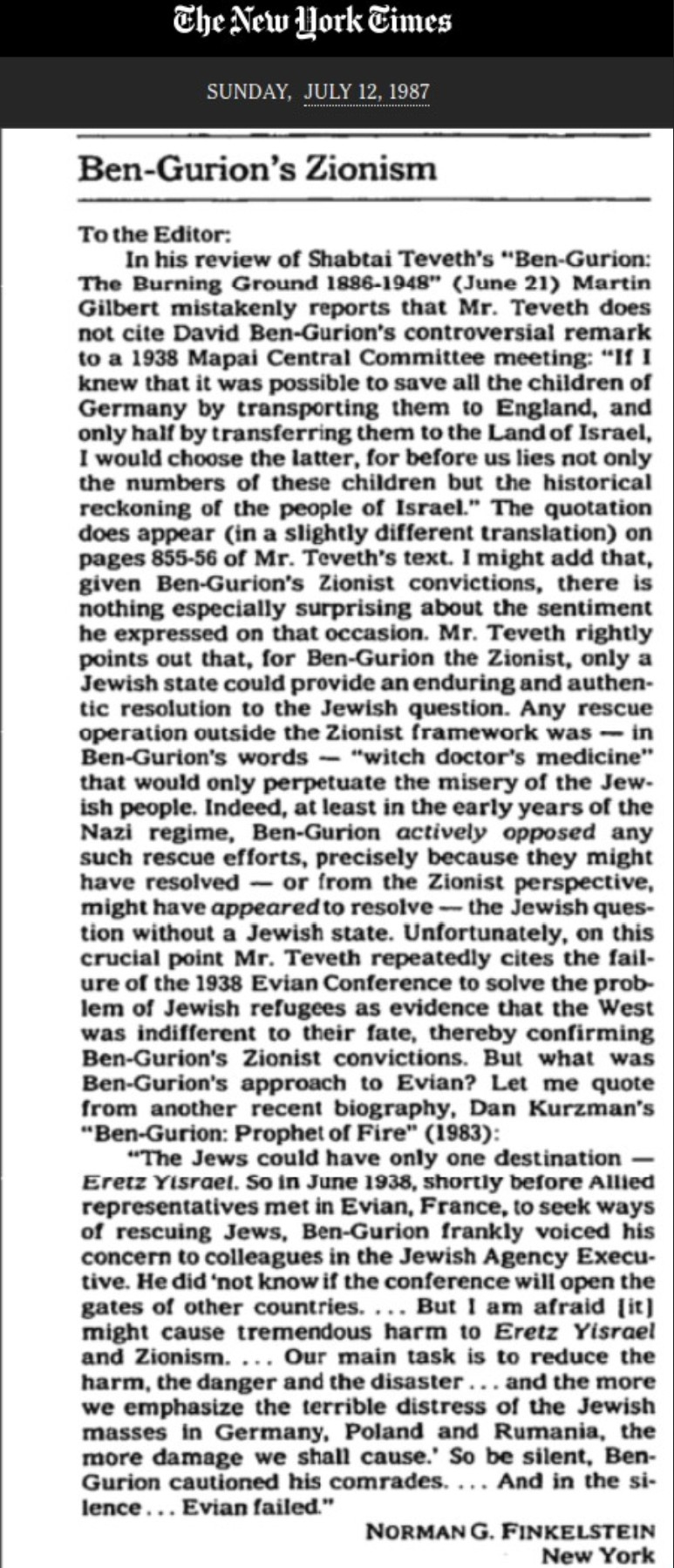
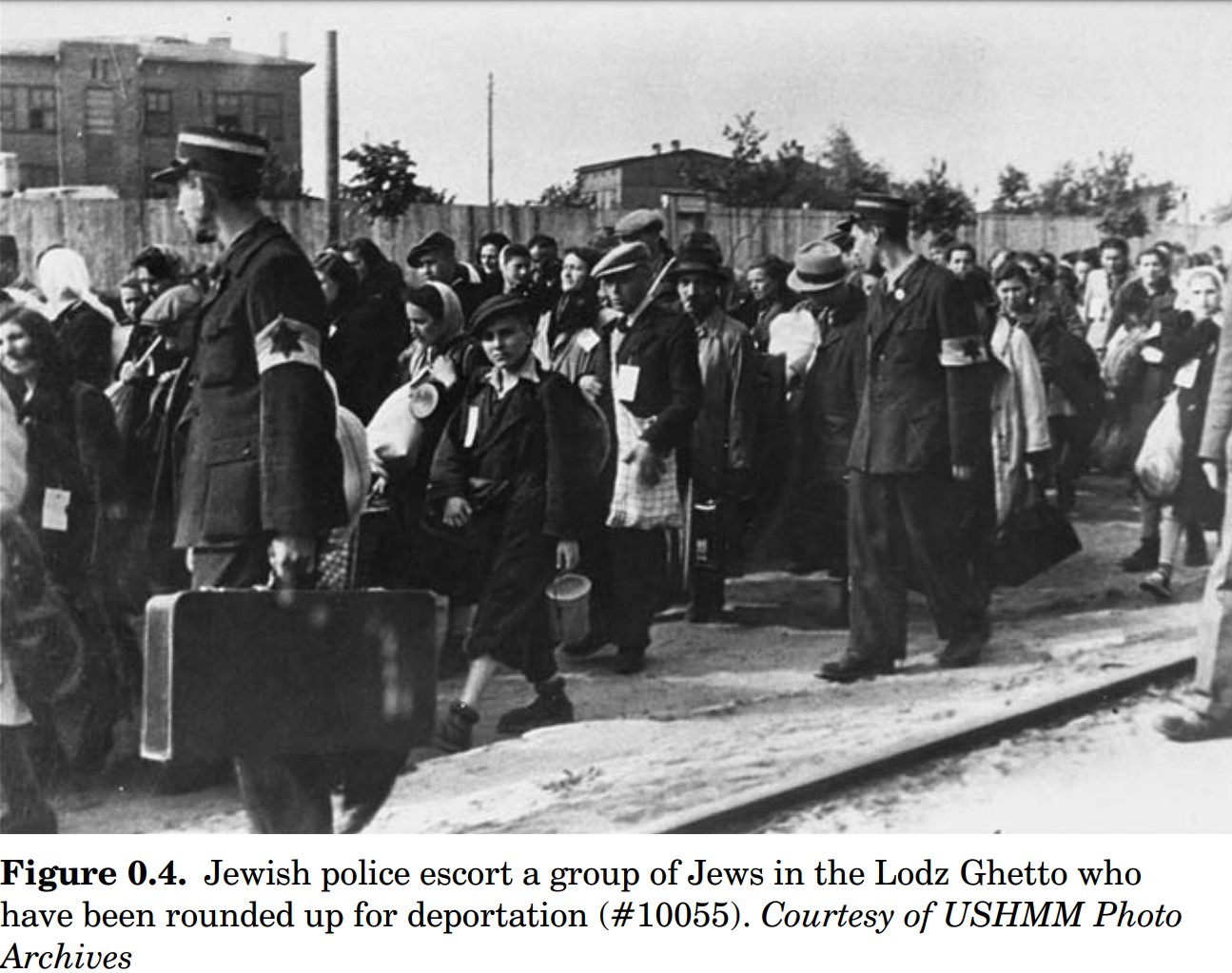
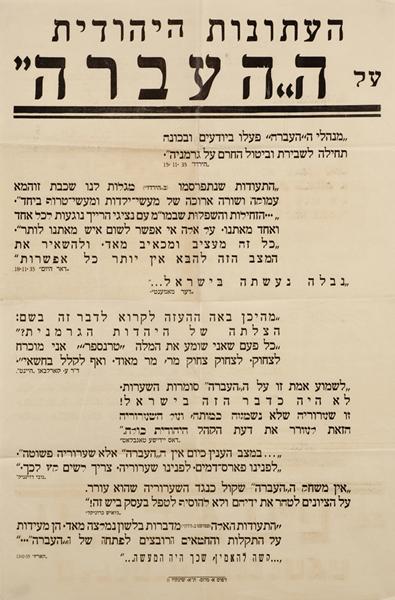
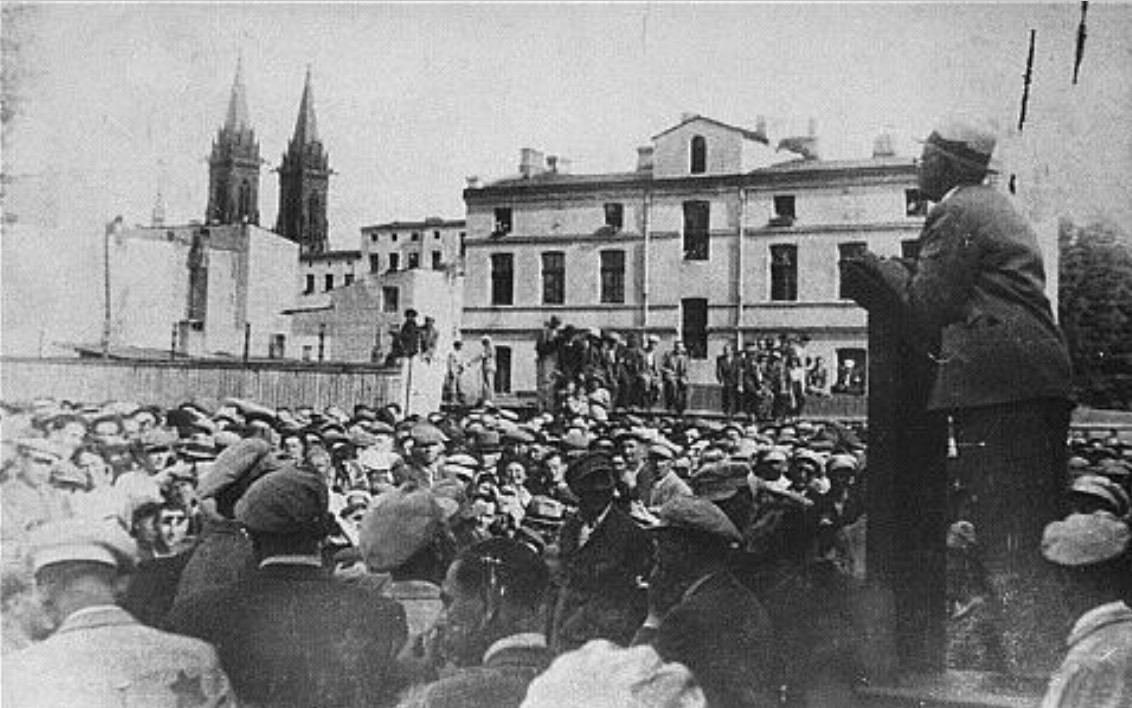
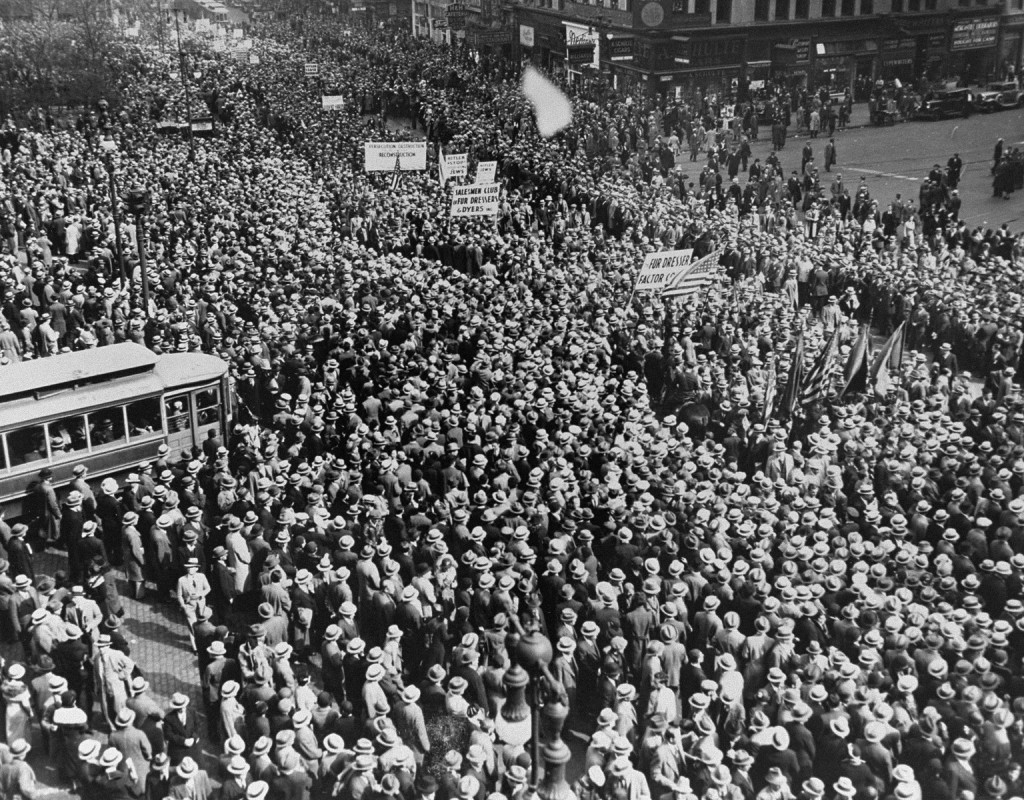
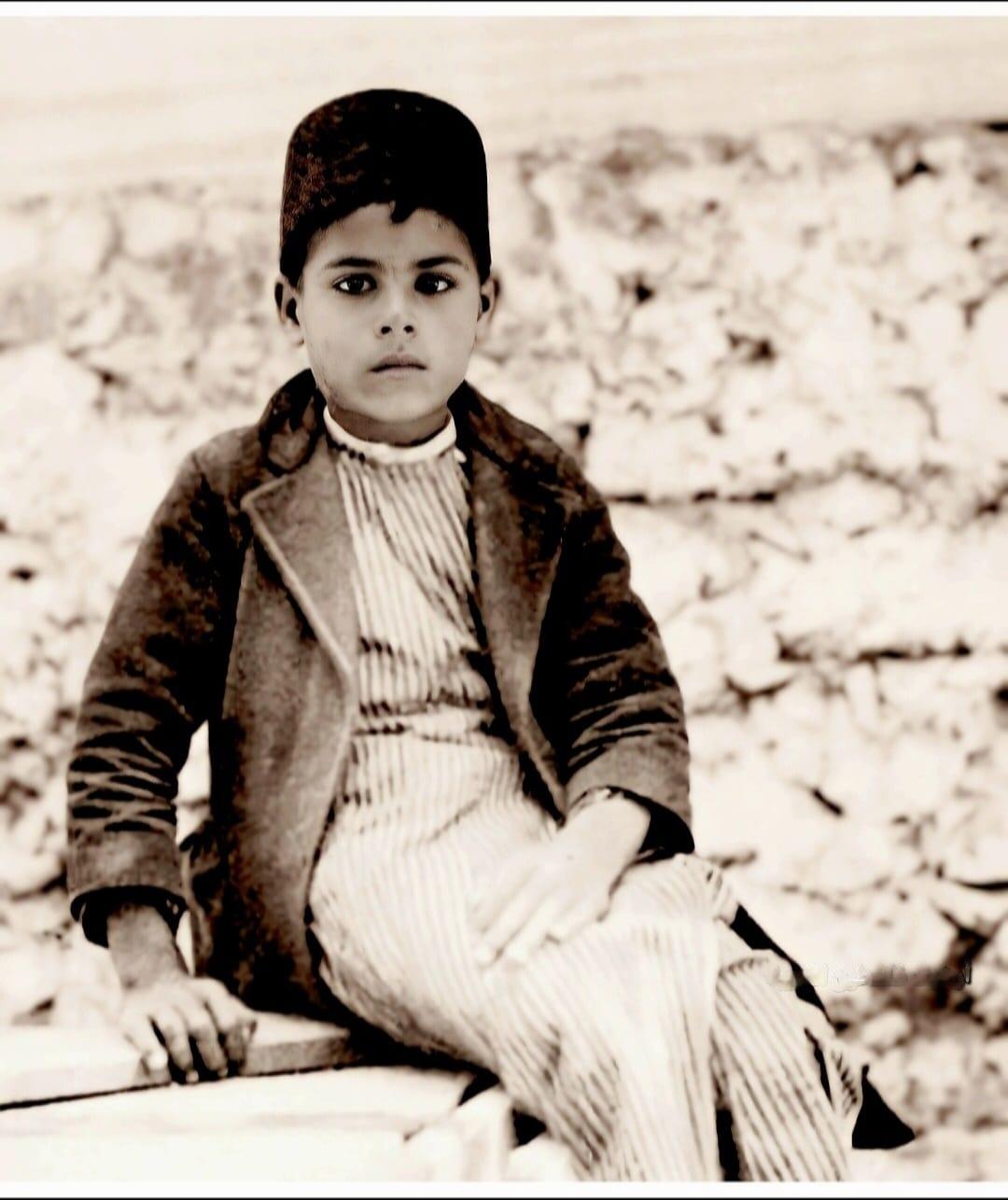
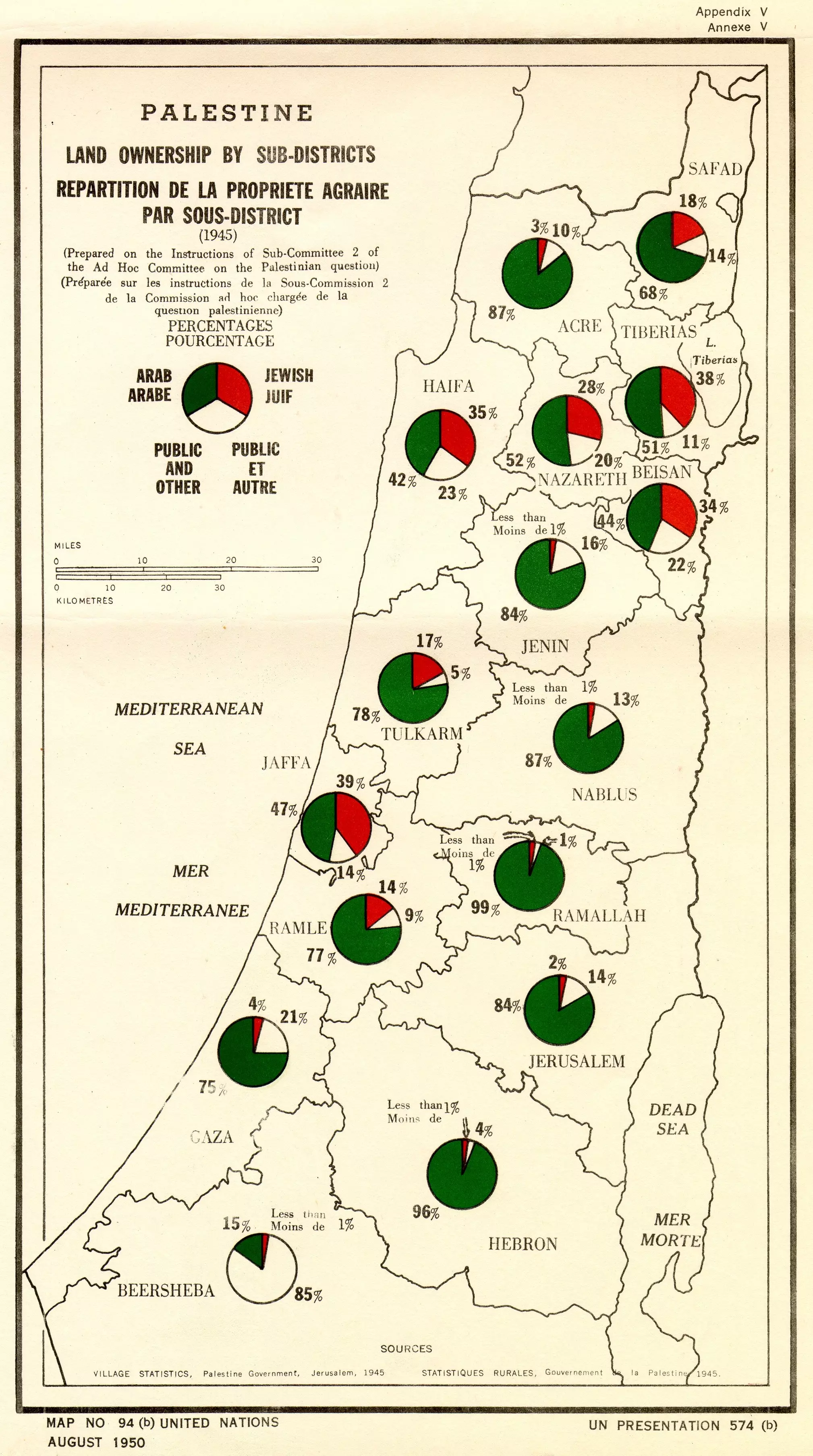
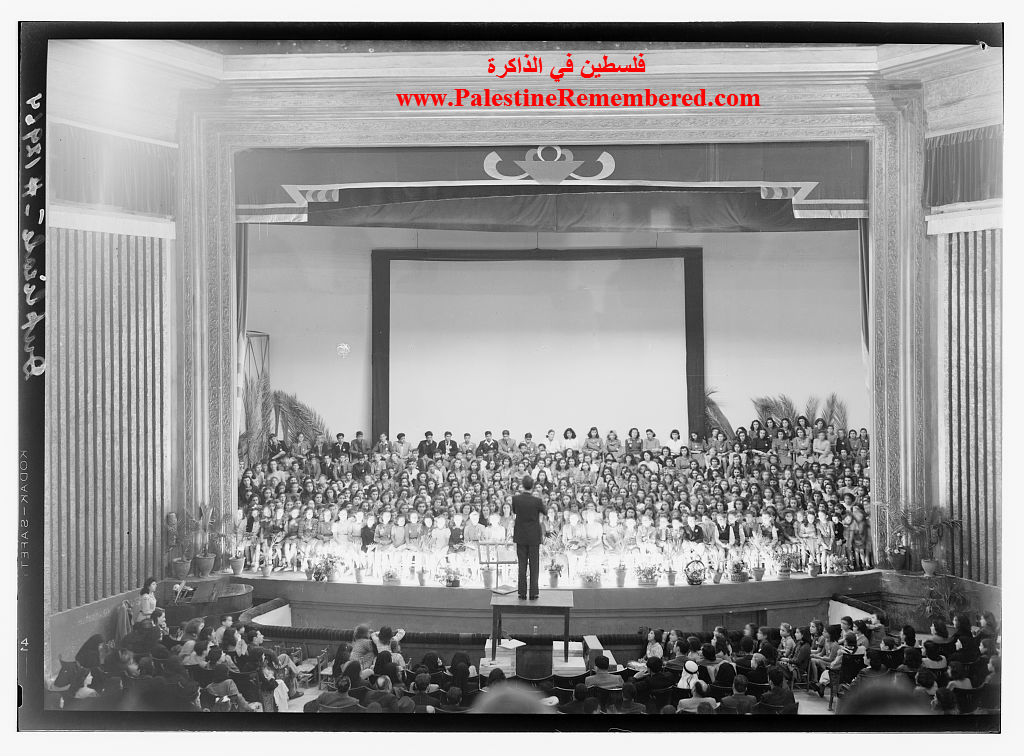
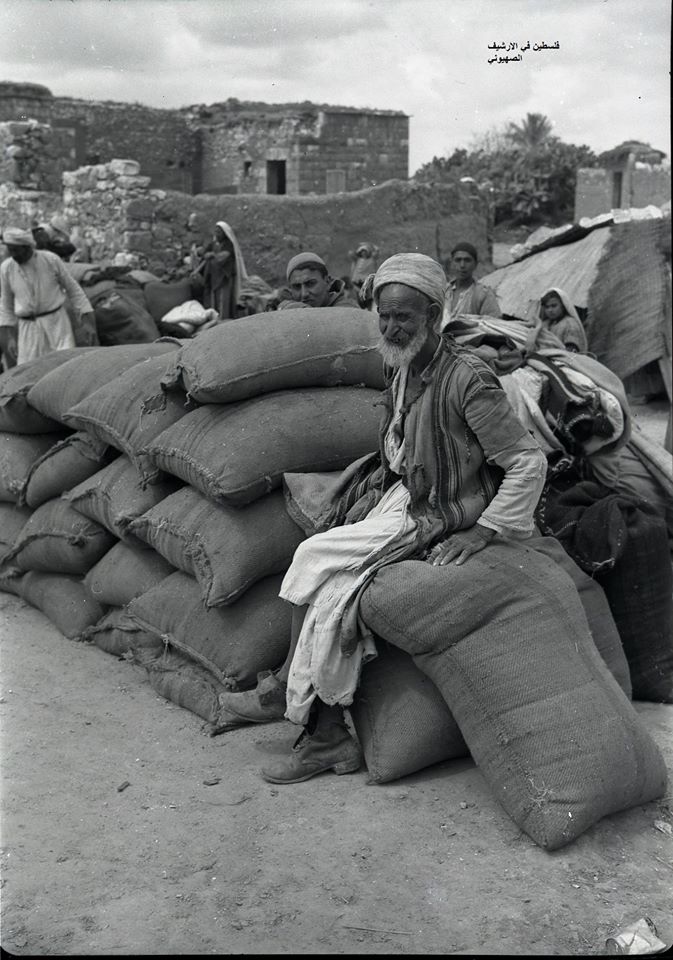
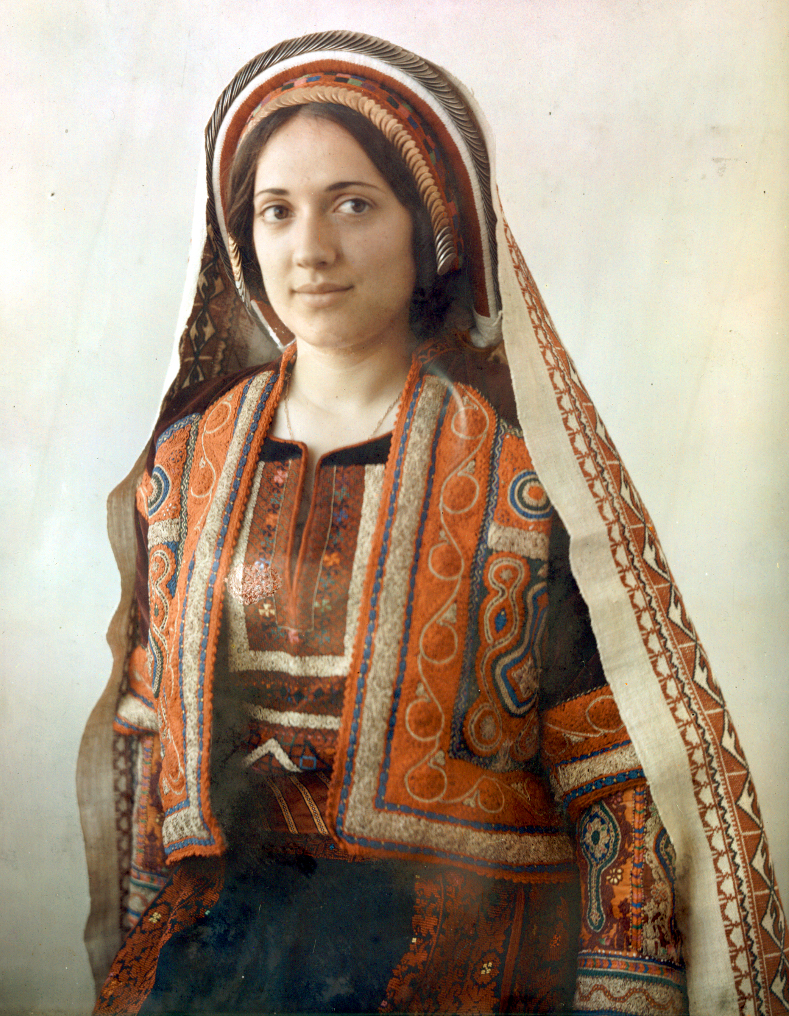
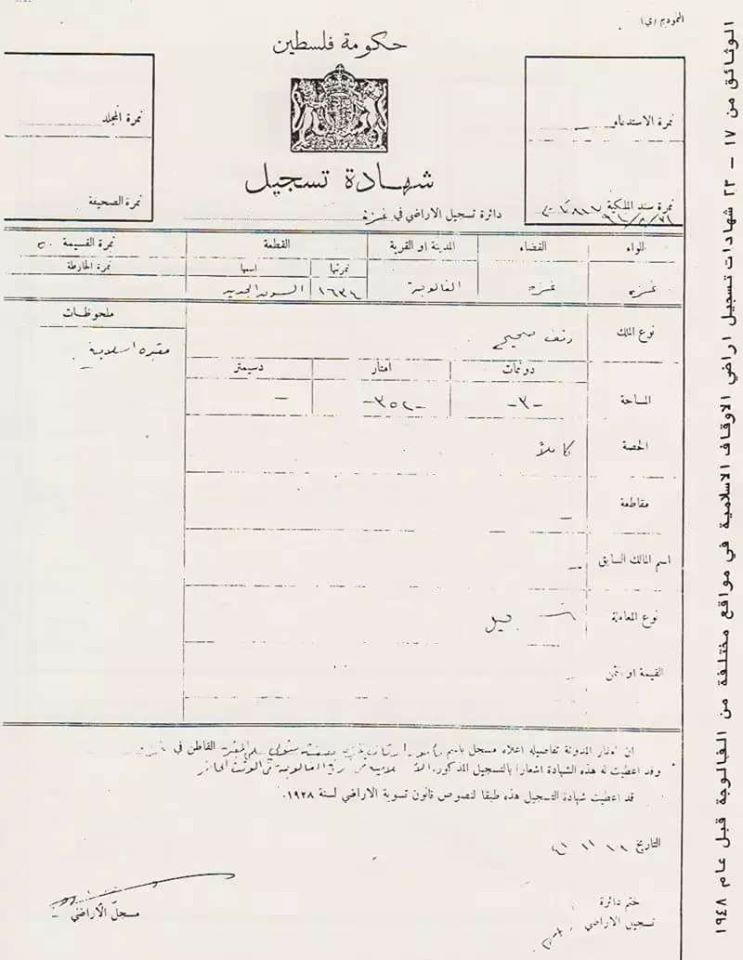
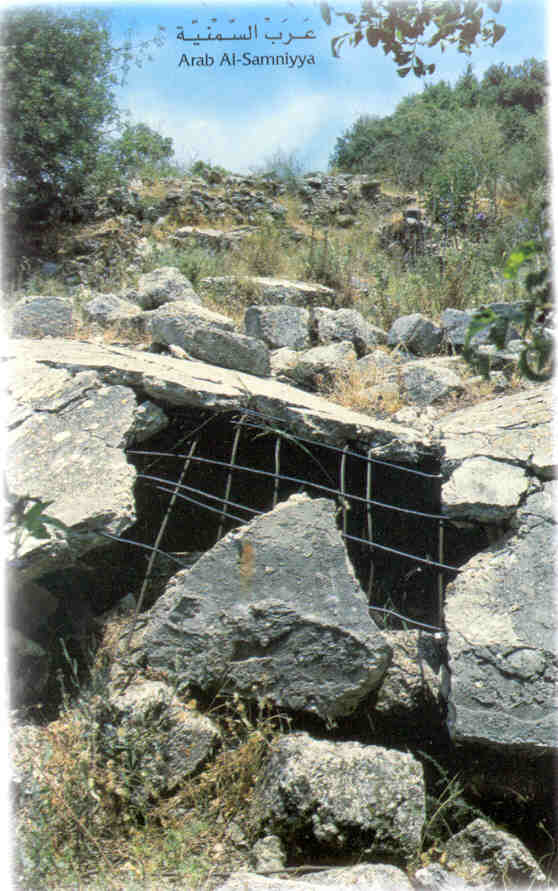
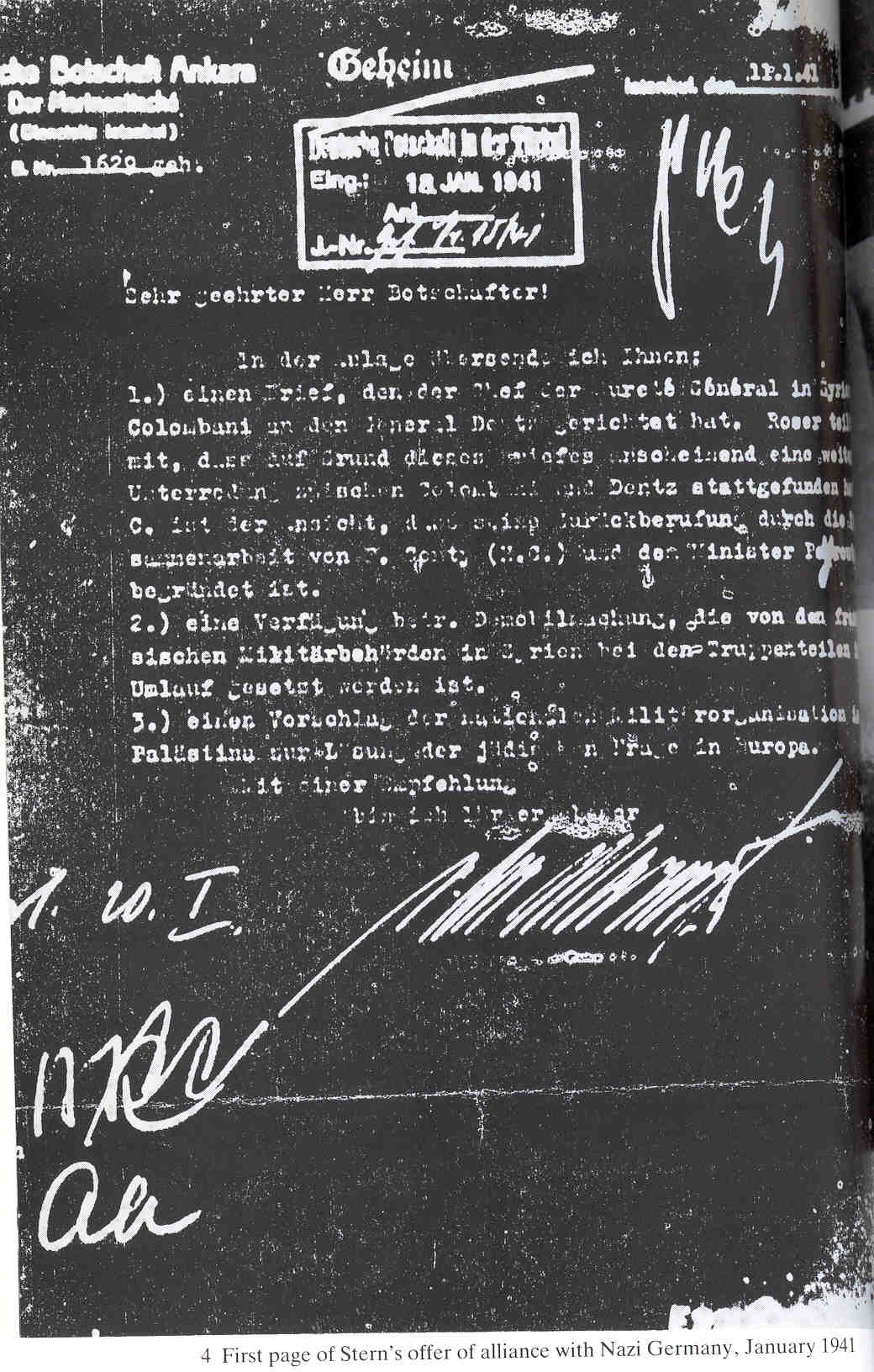
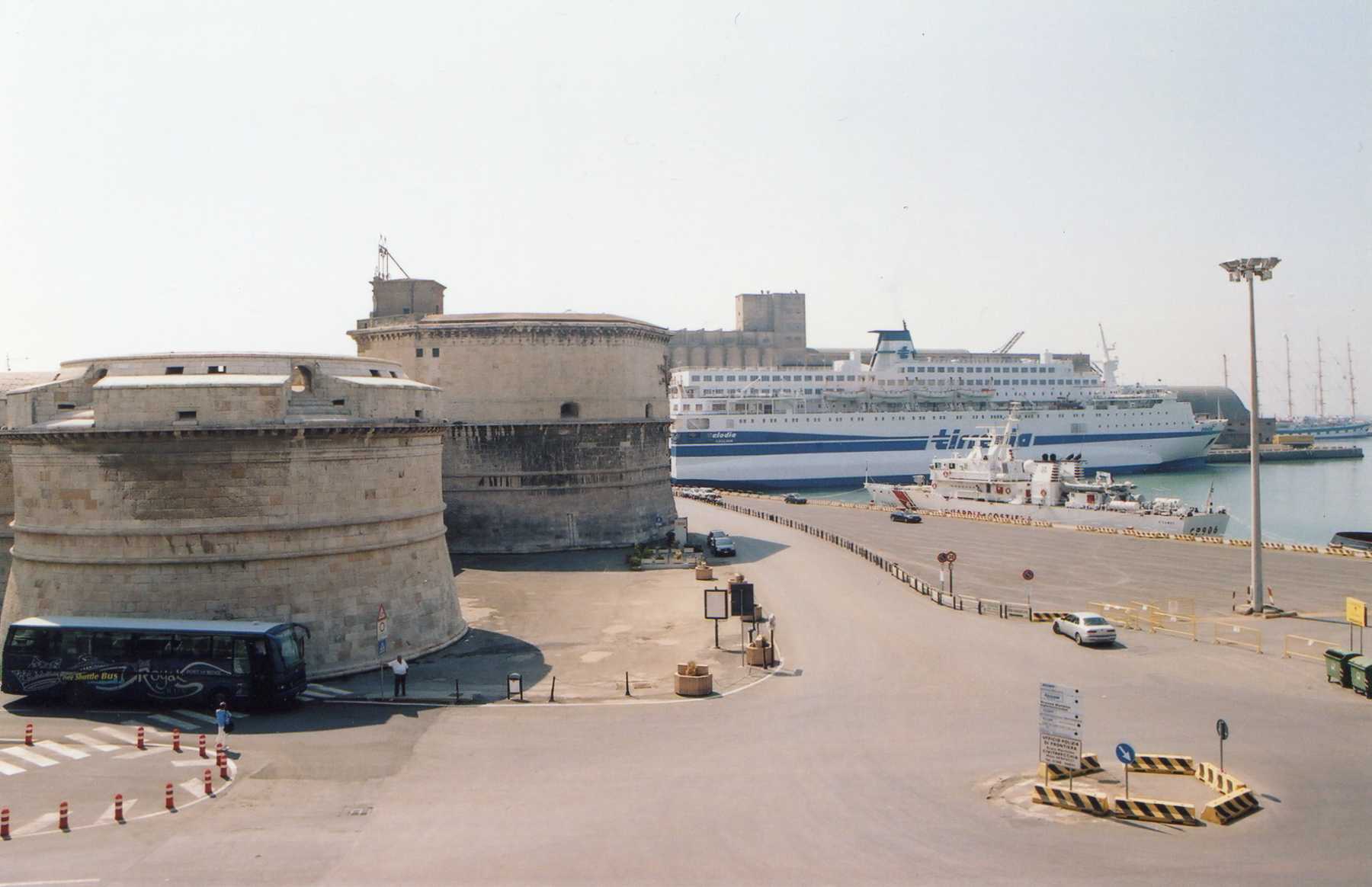


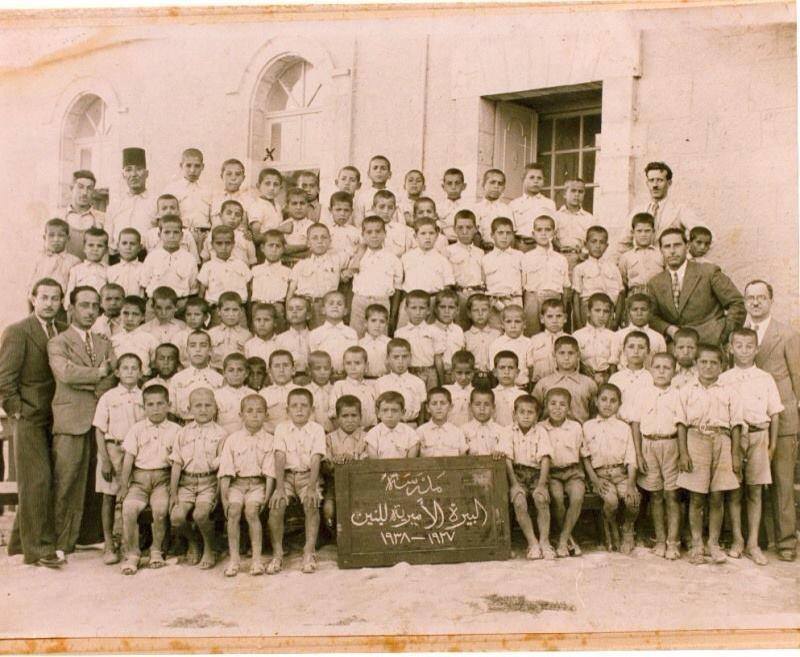
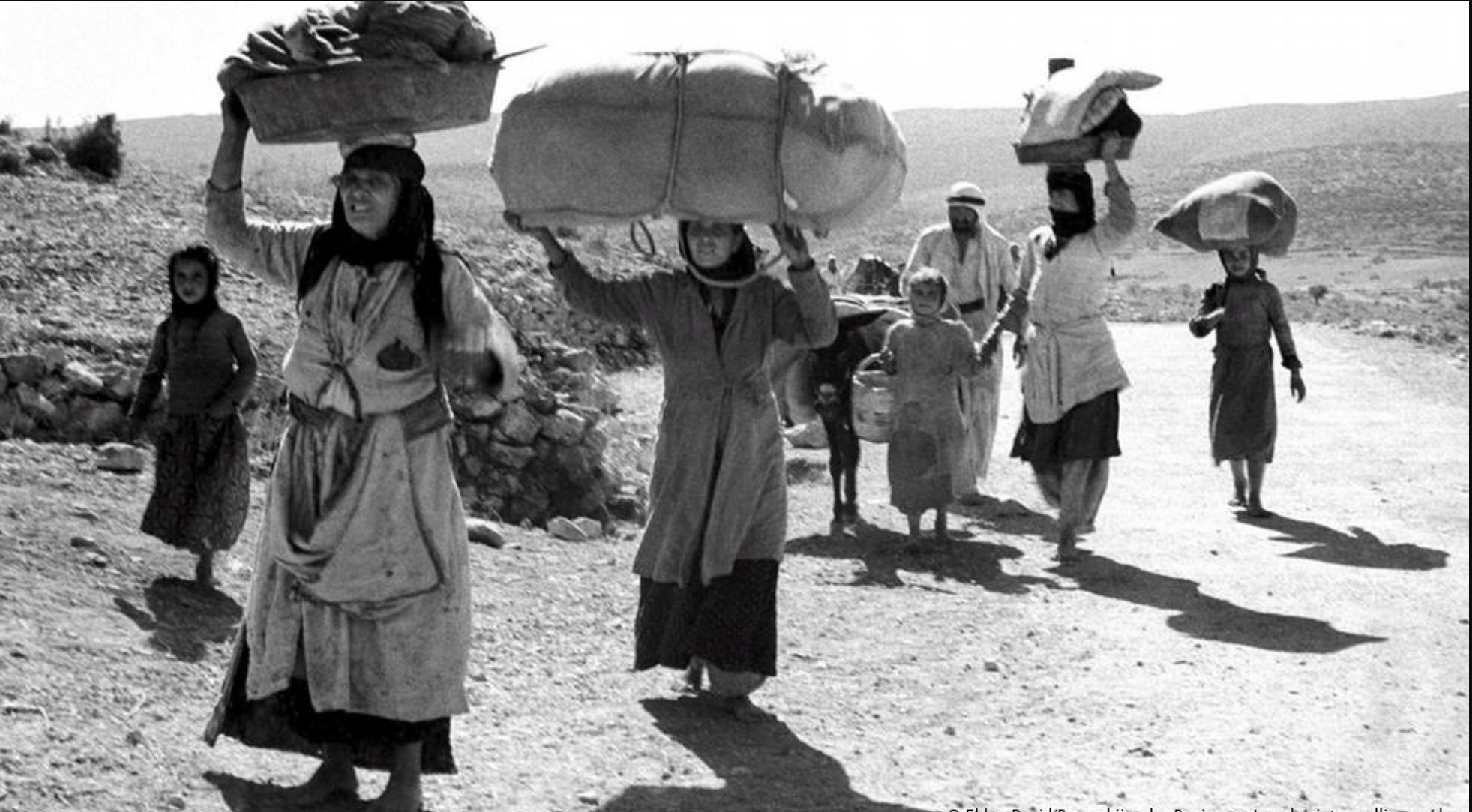
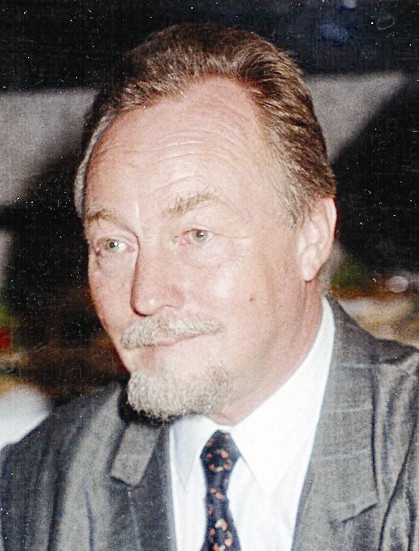
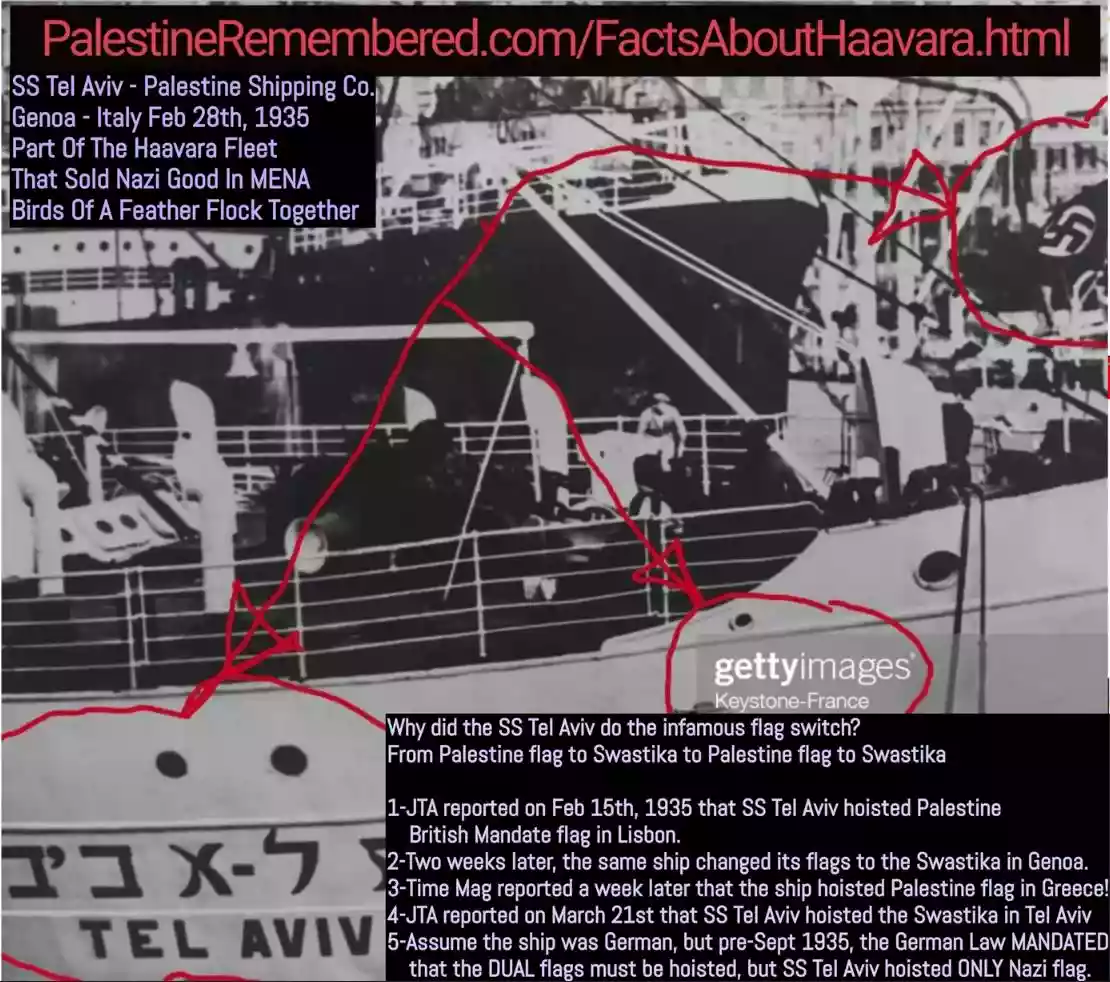

Post Your Comment
*It should be NOTED that your email address won't be shared, and all communications between members will be routed via the website's mail server.